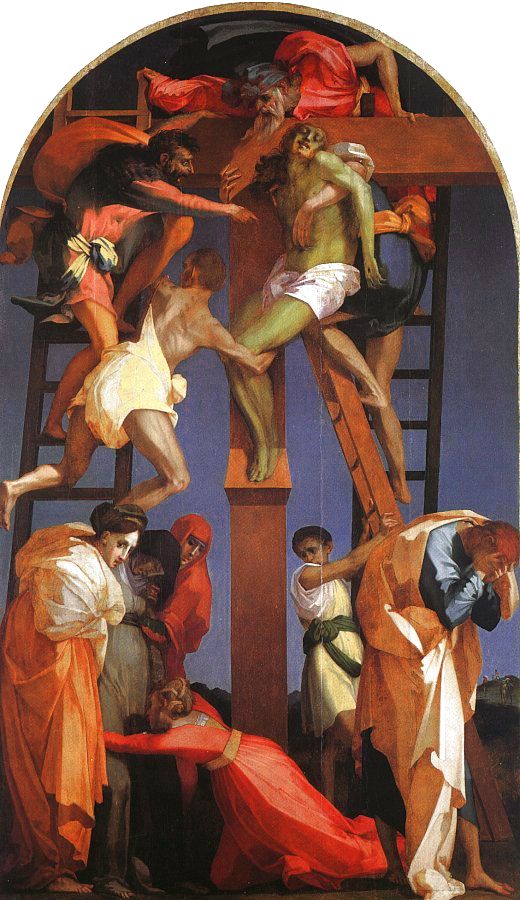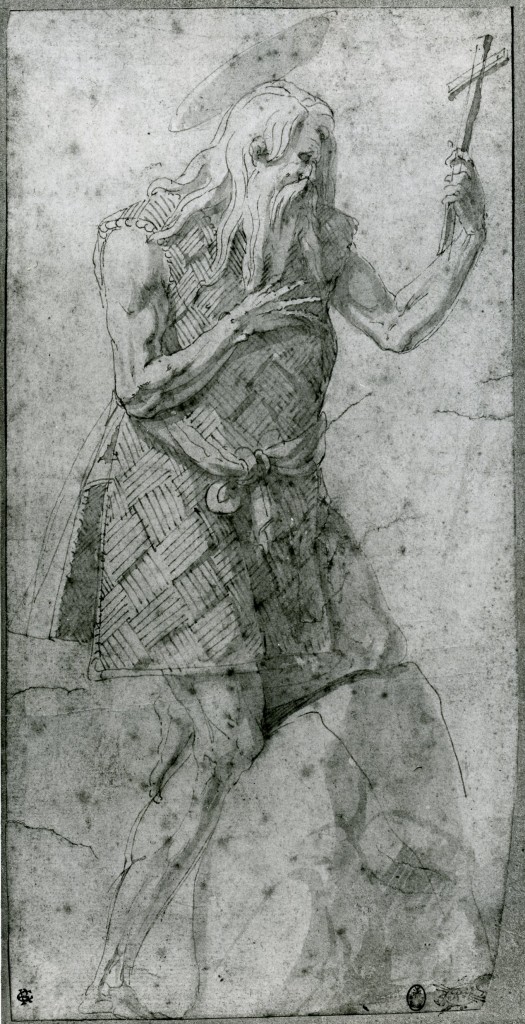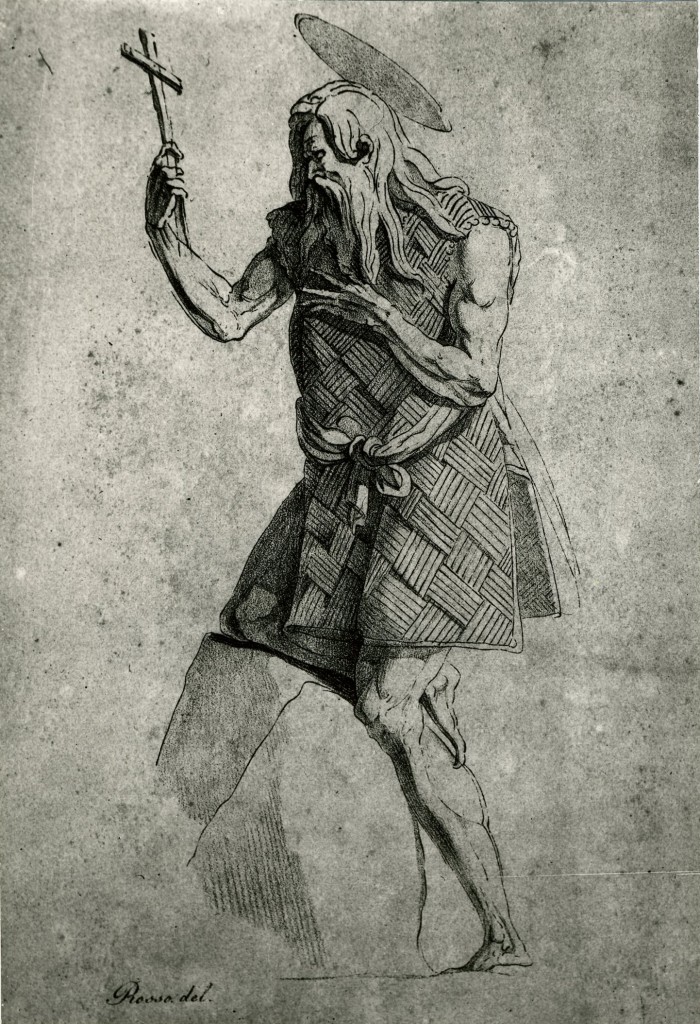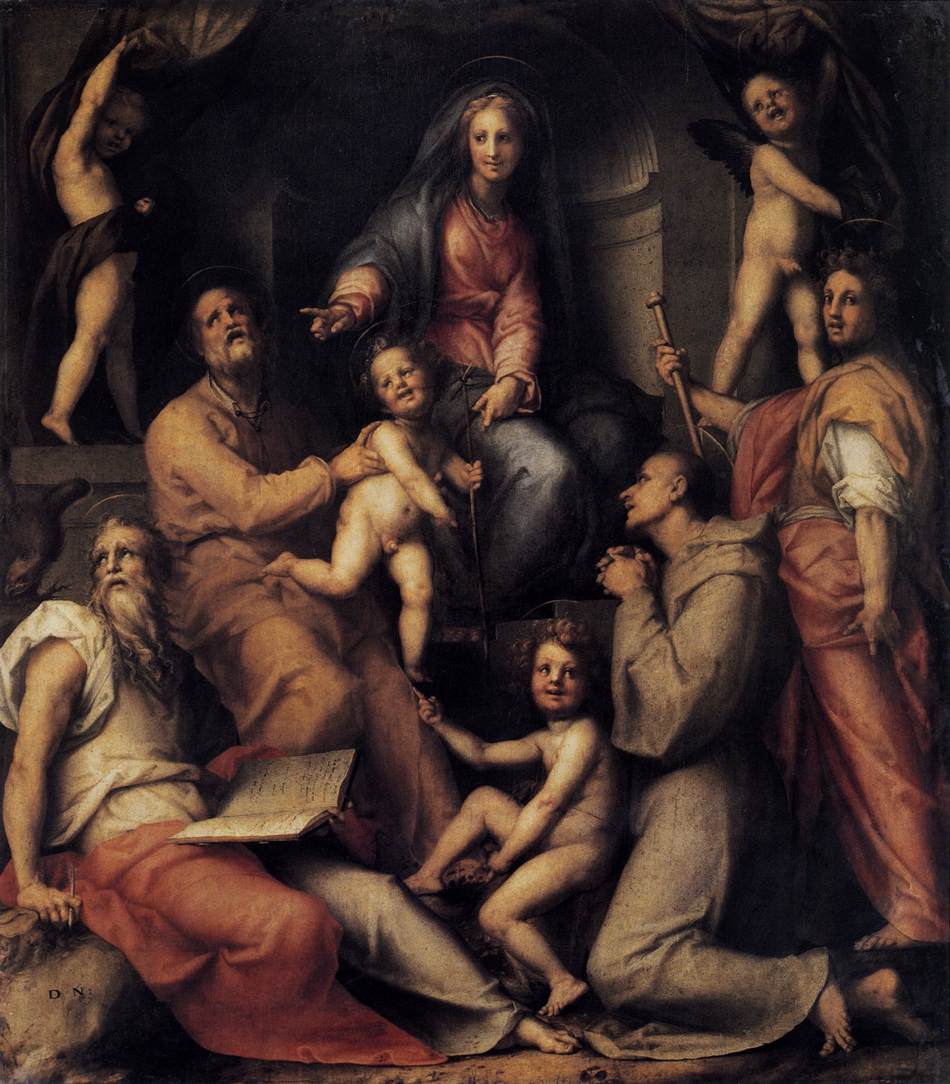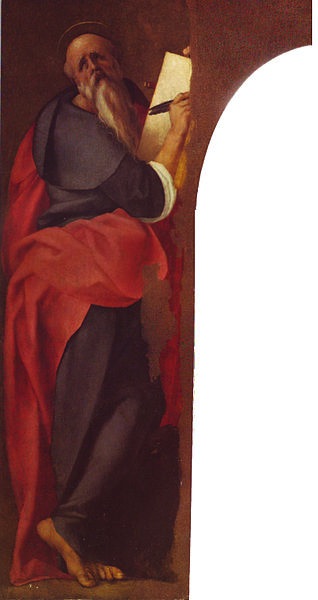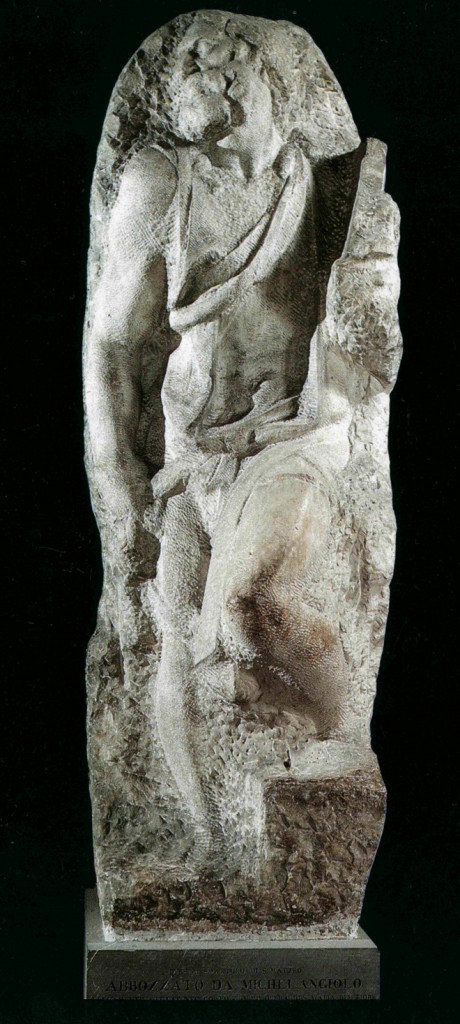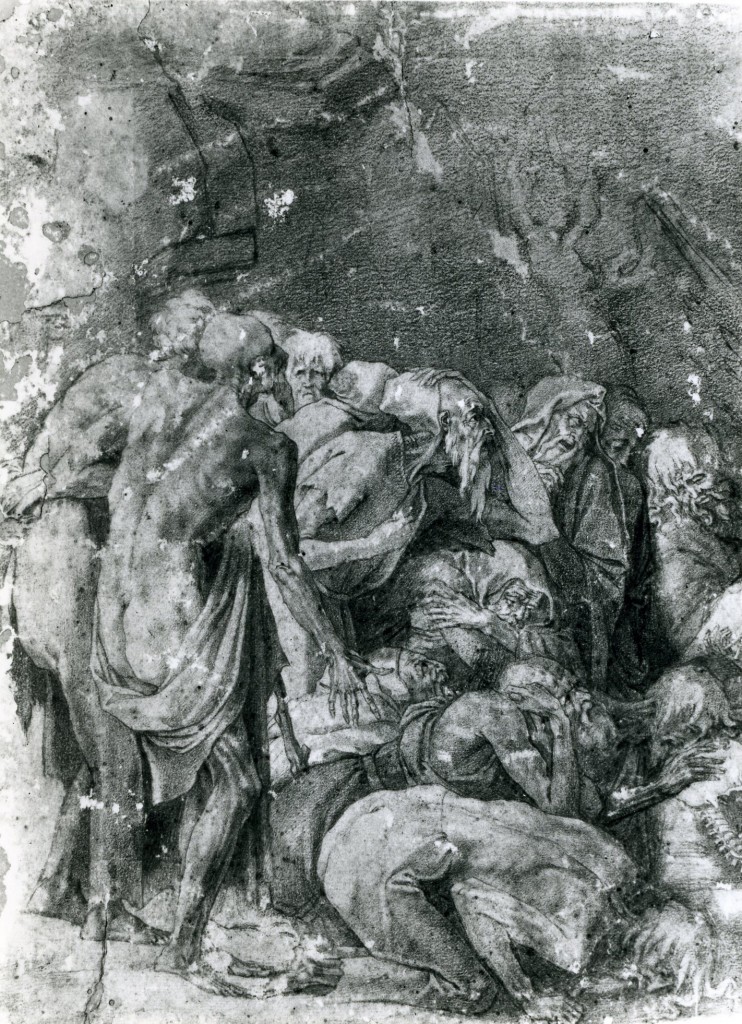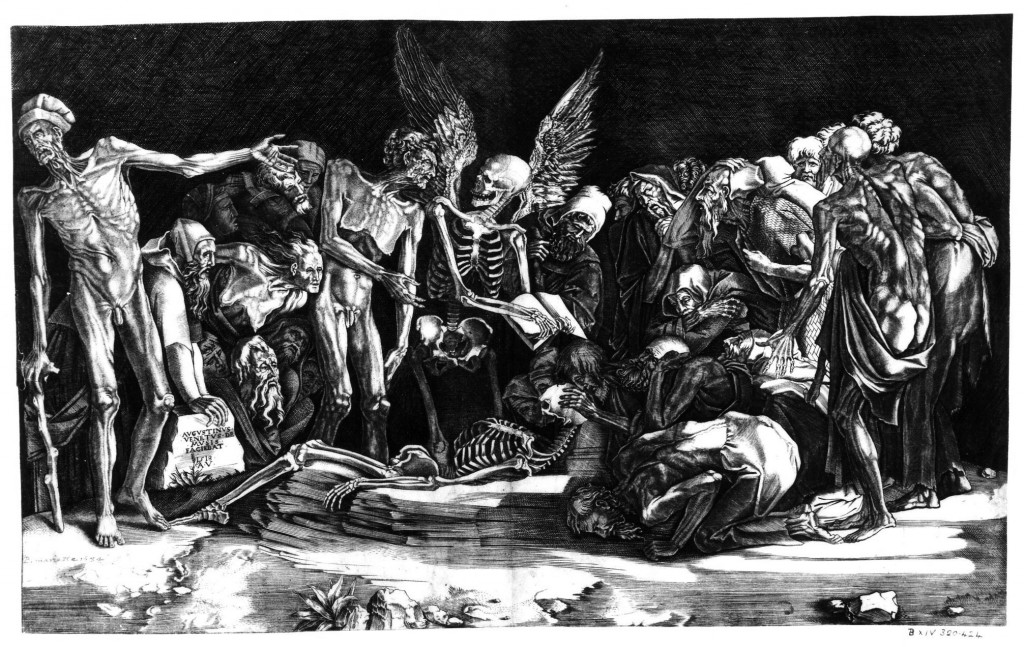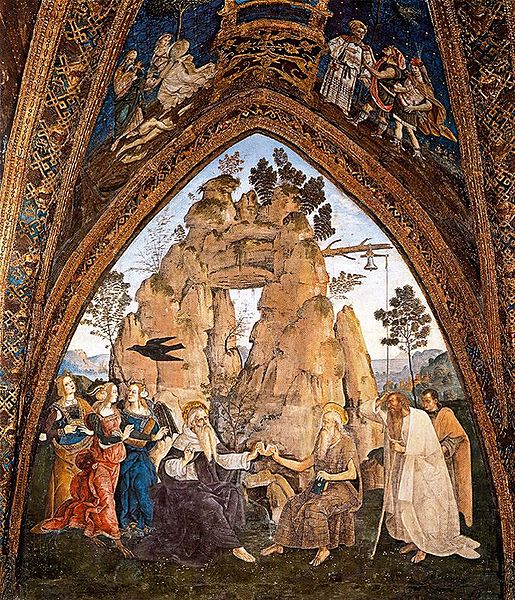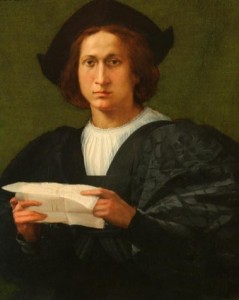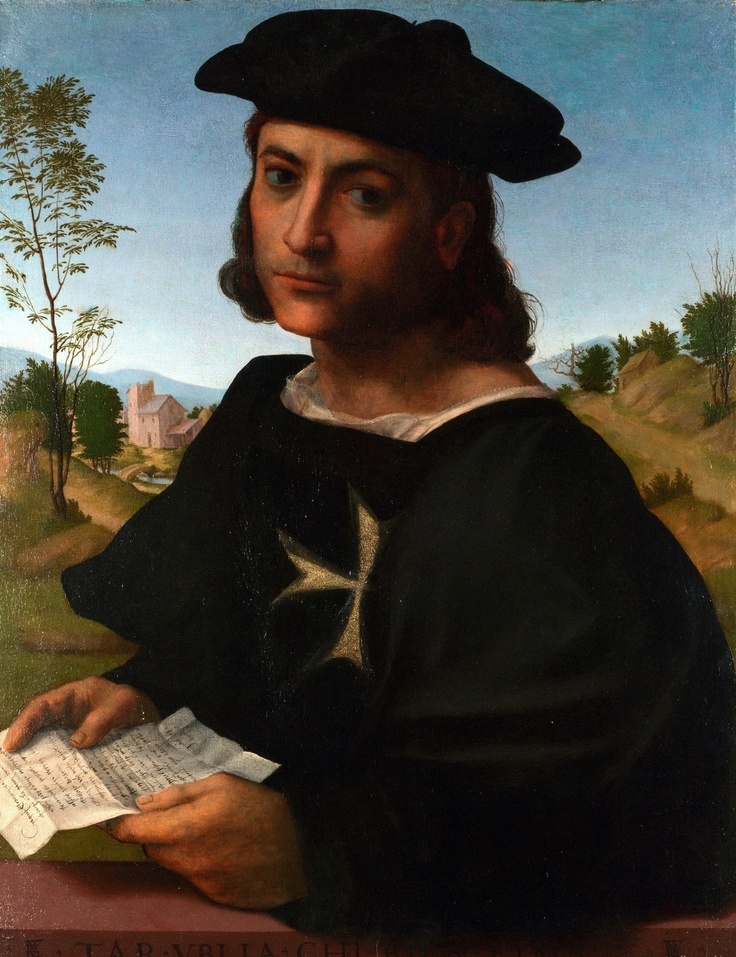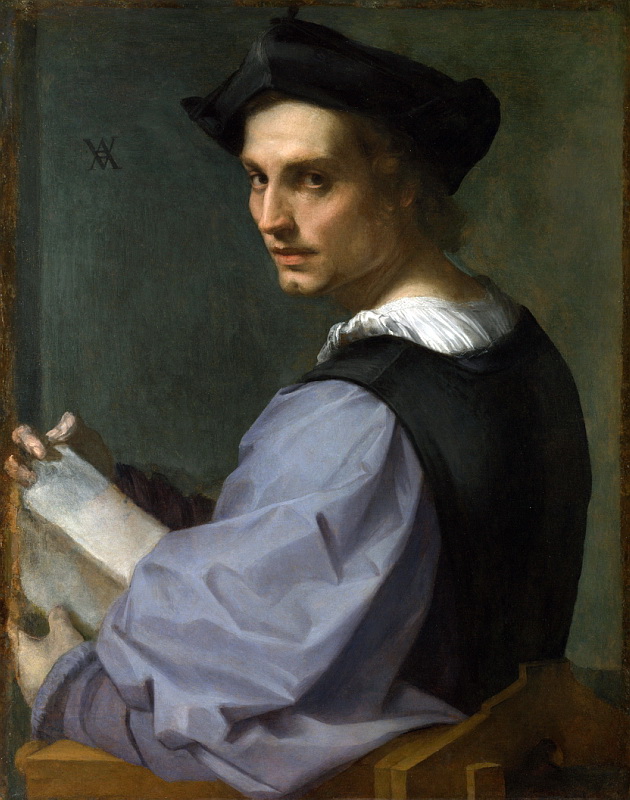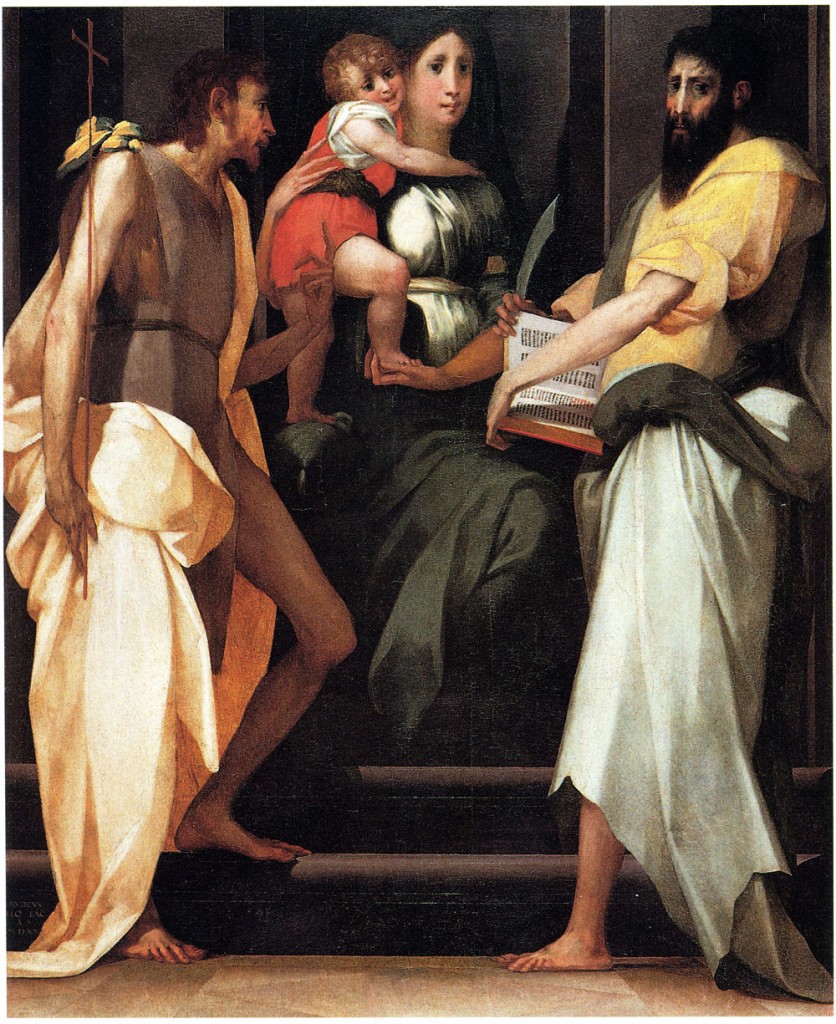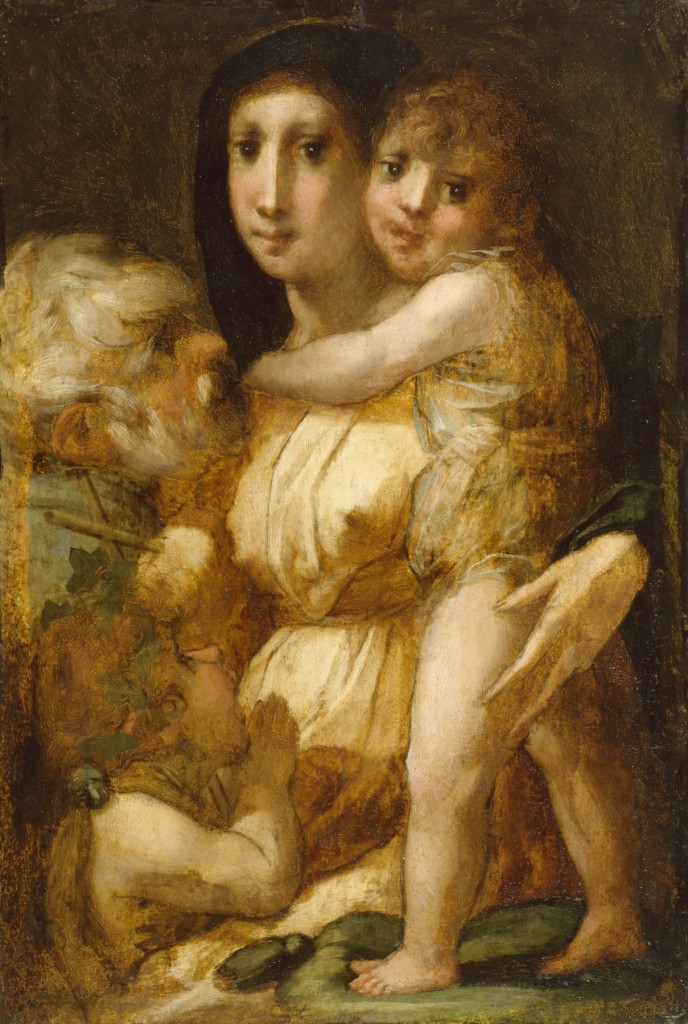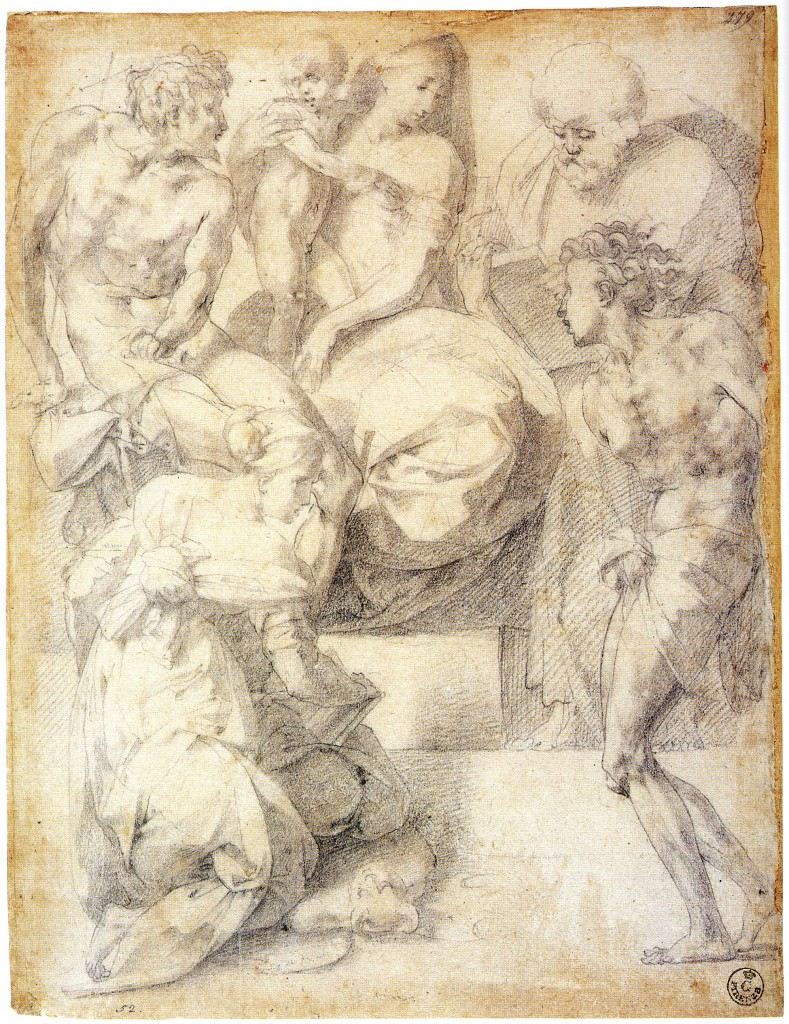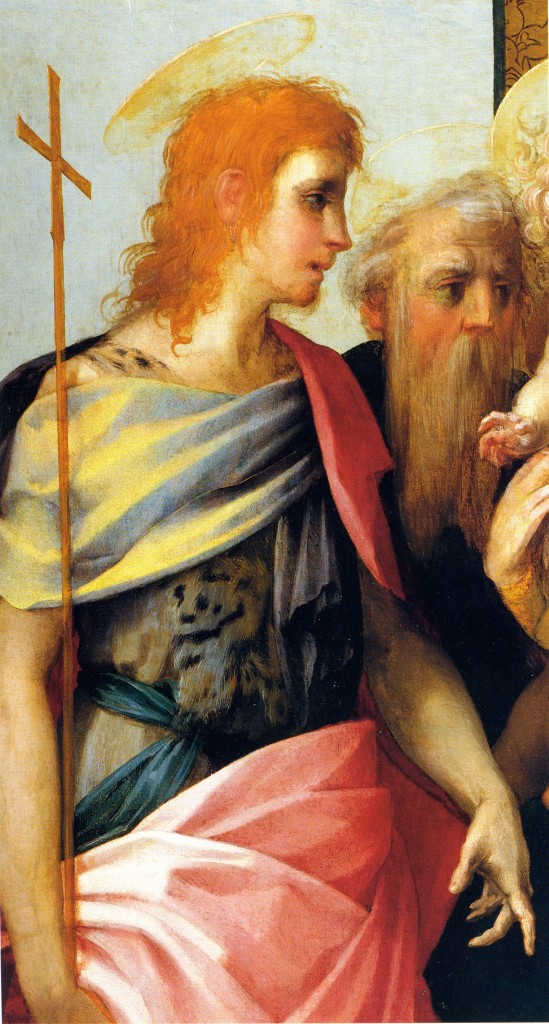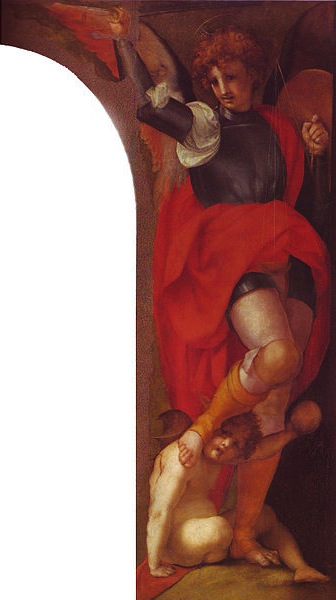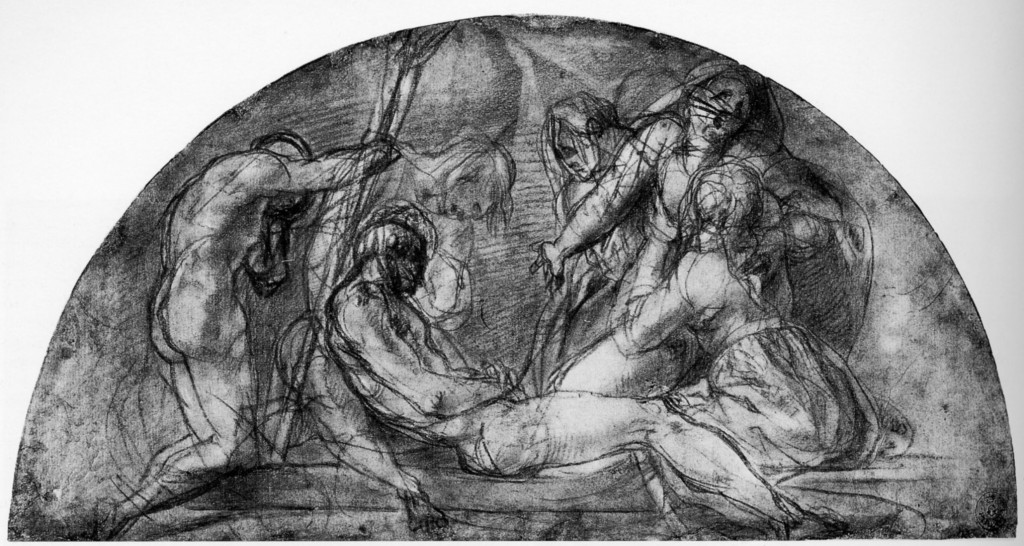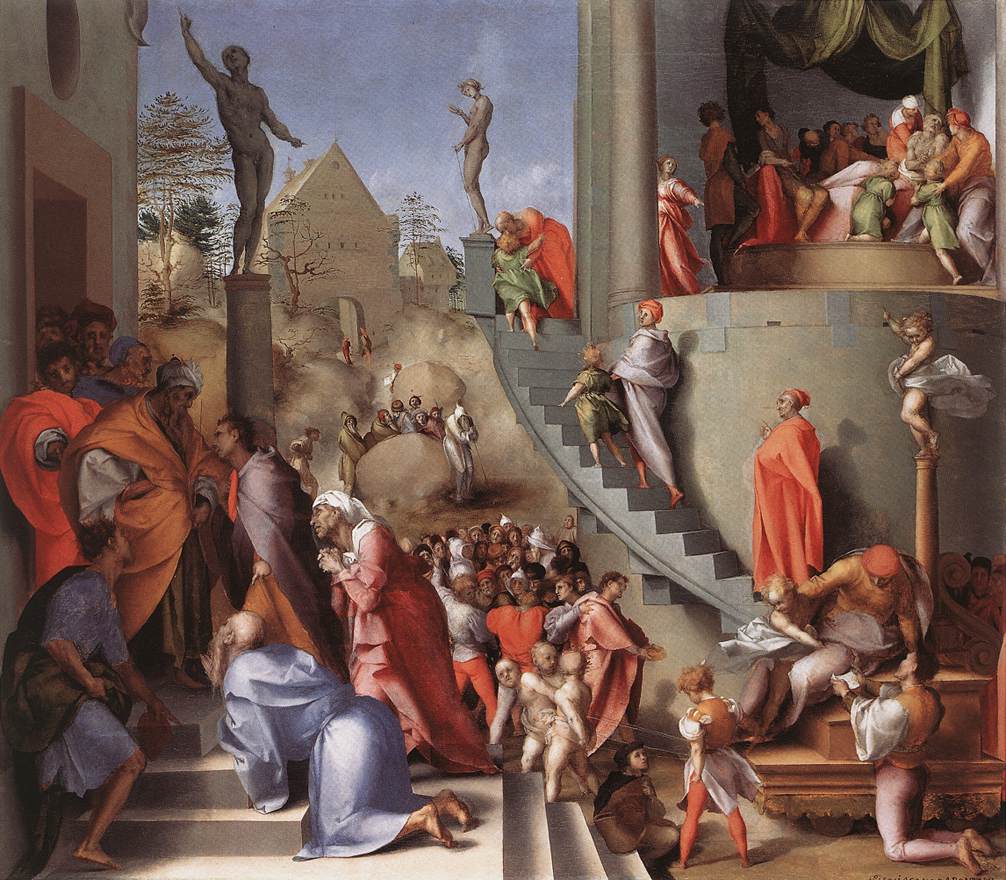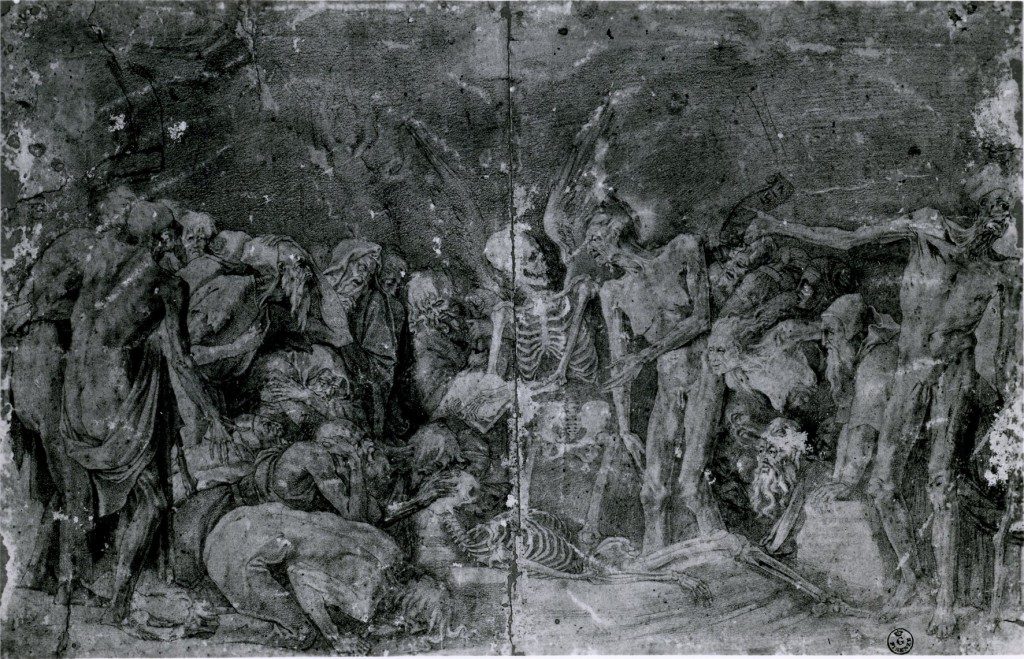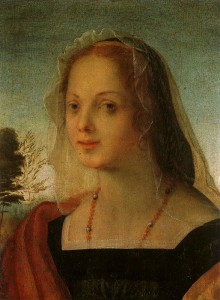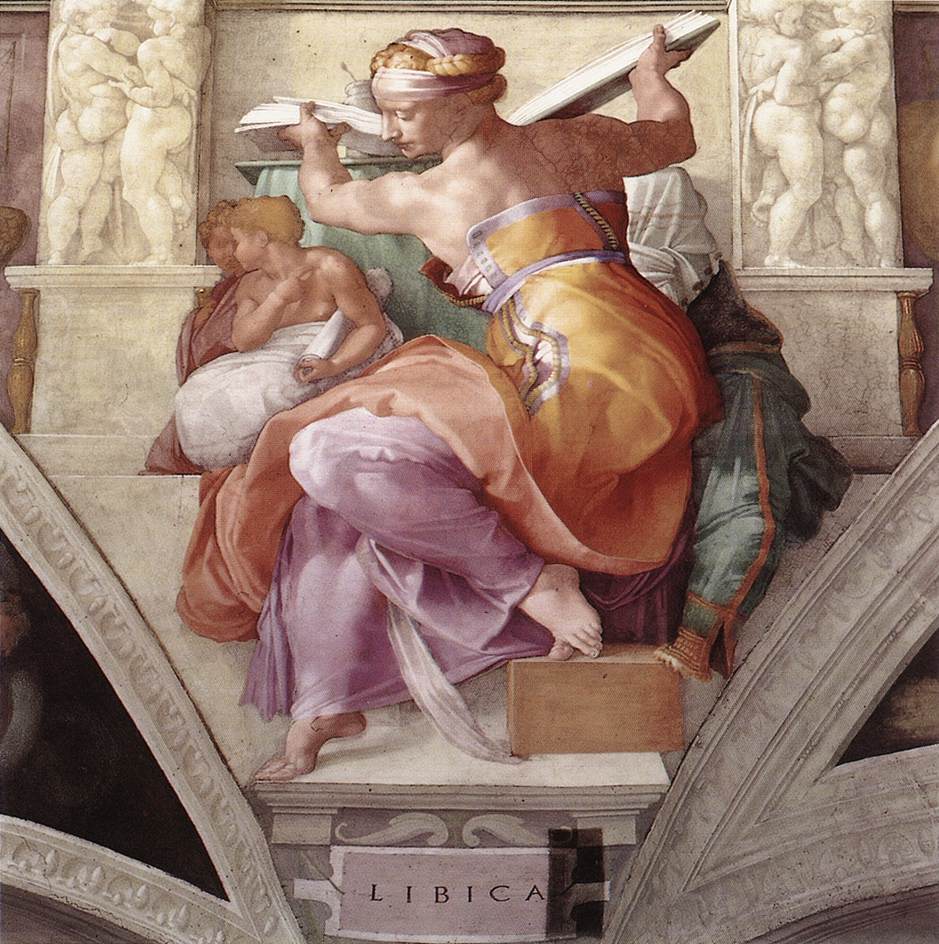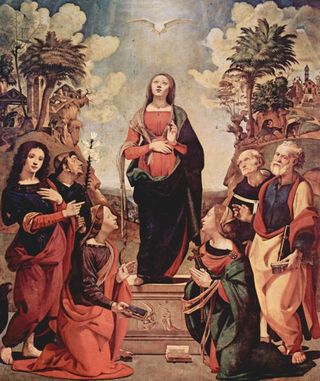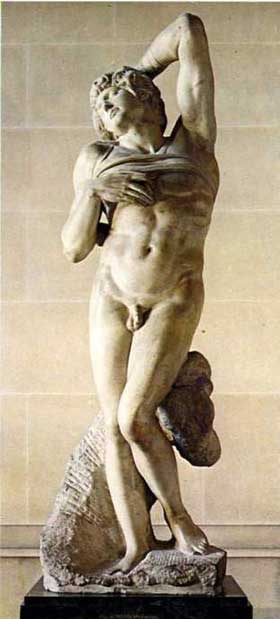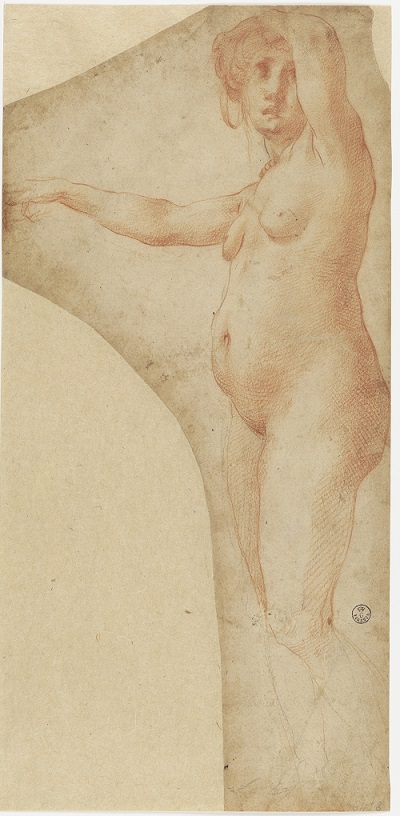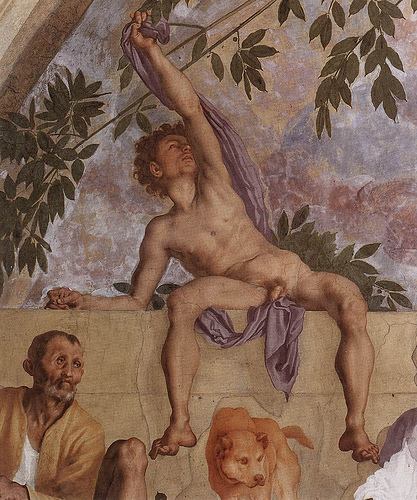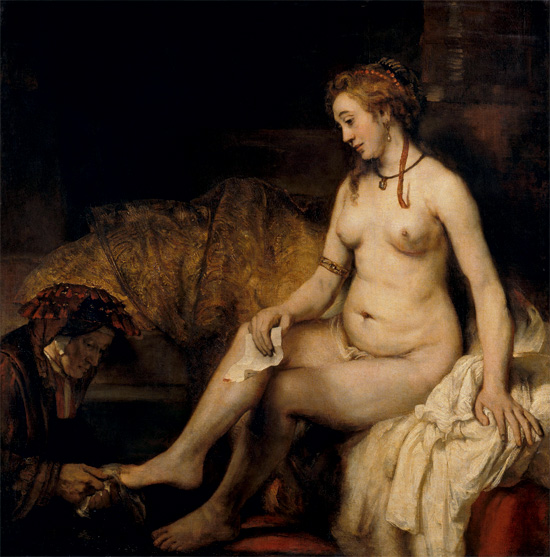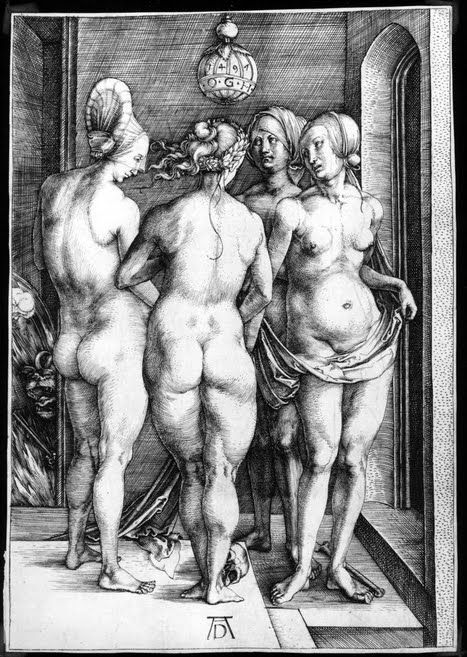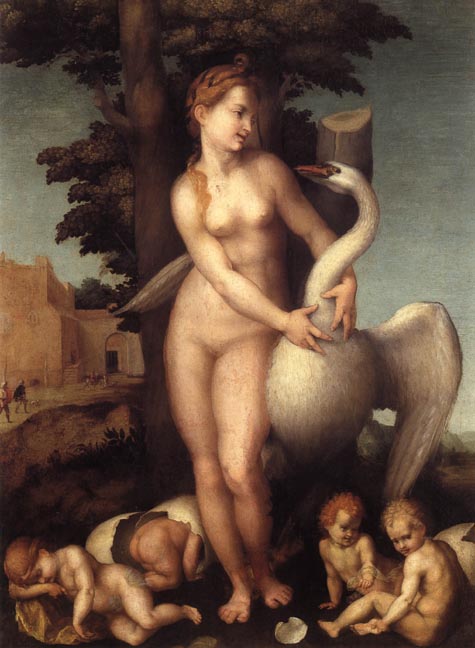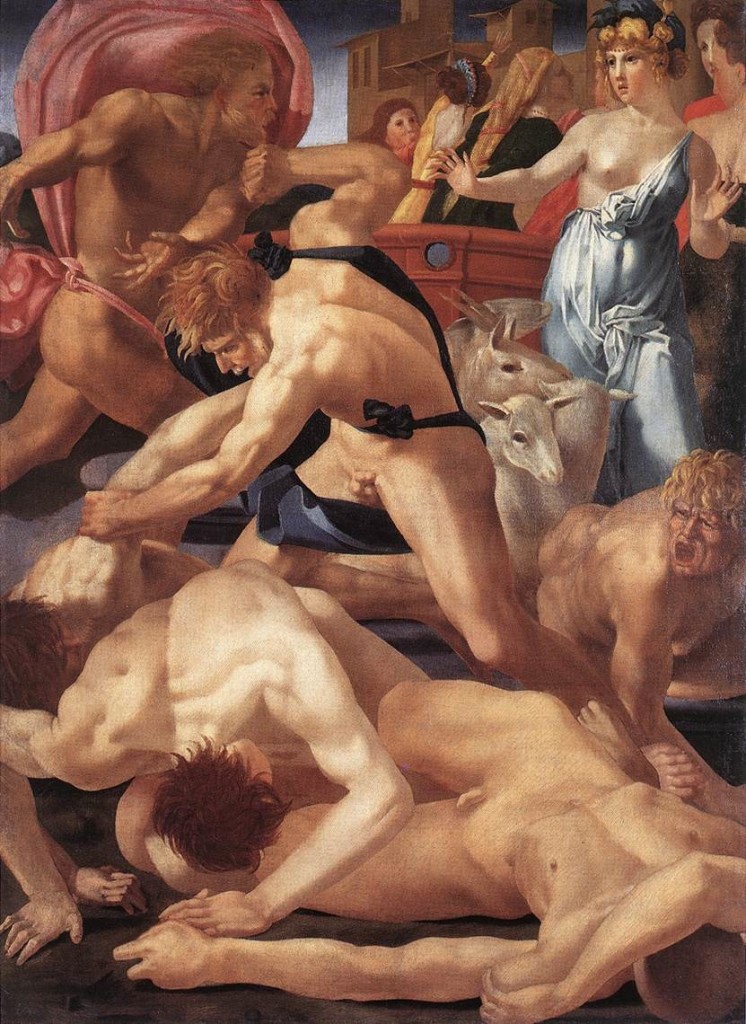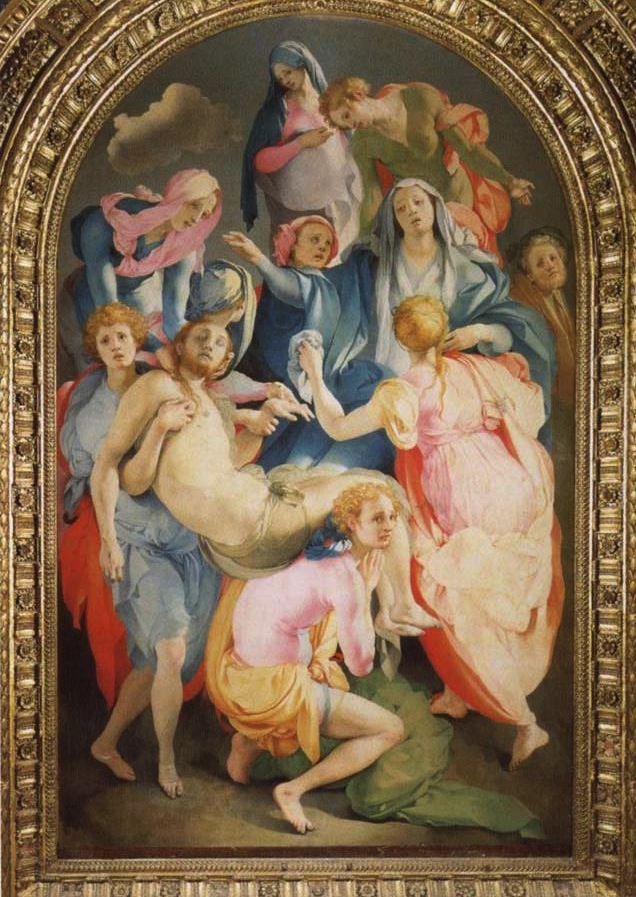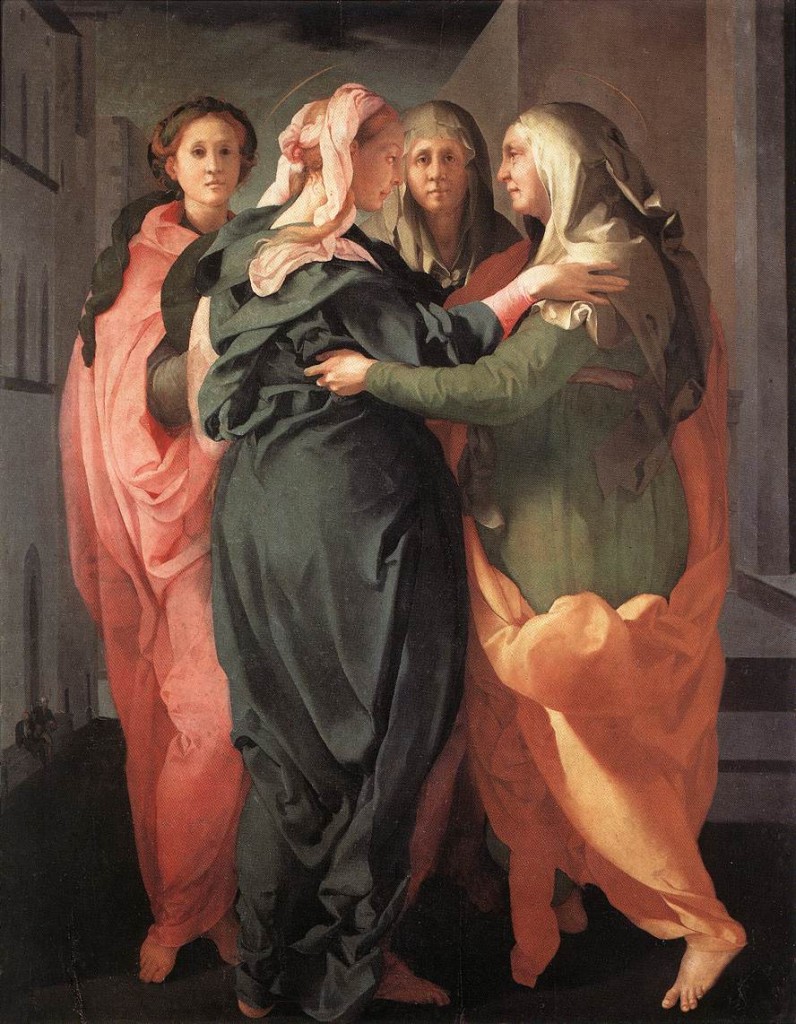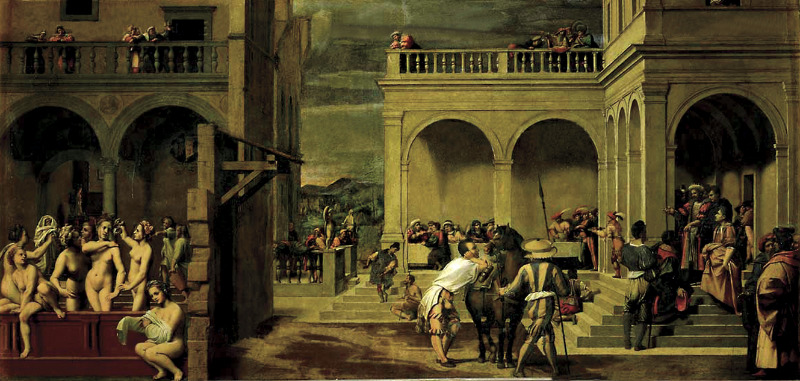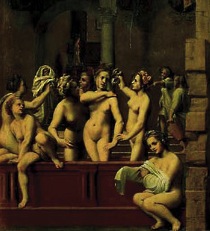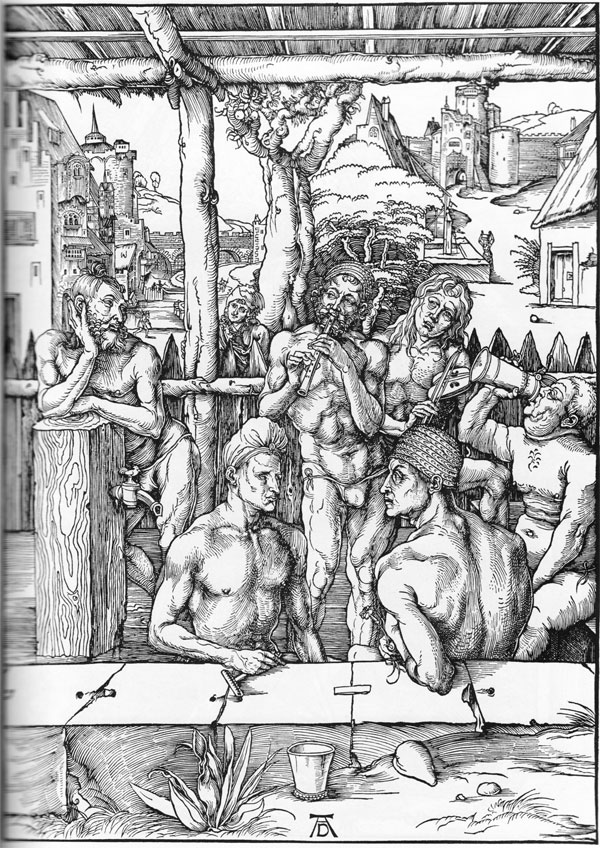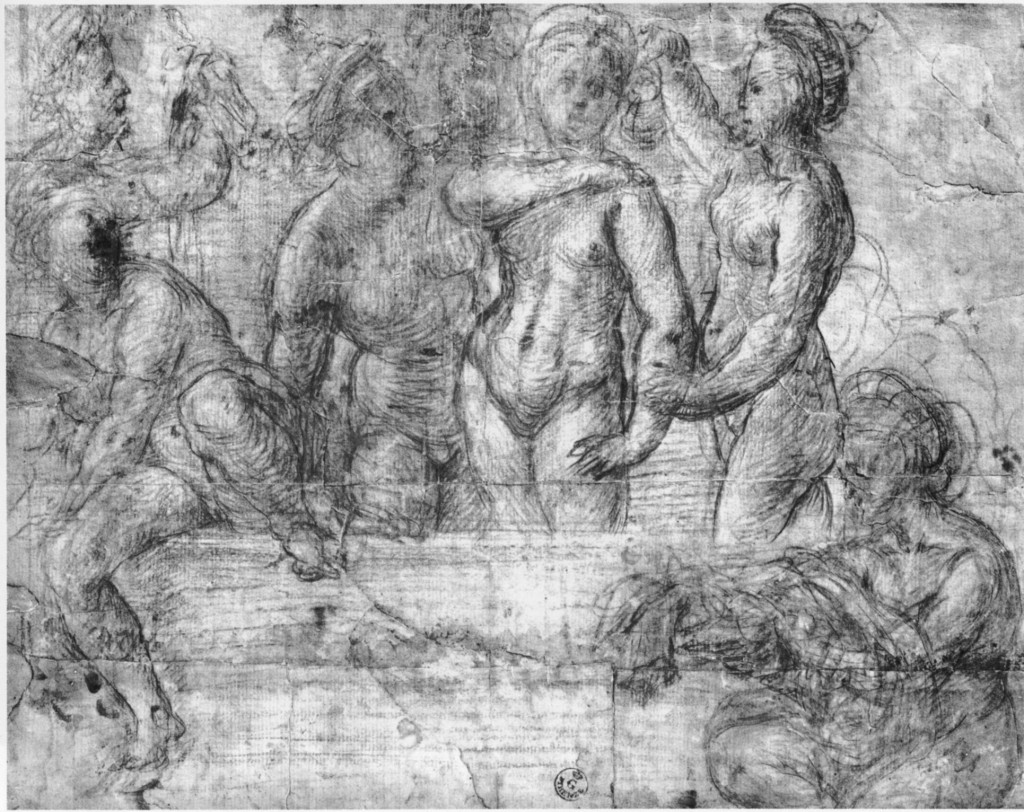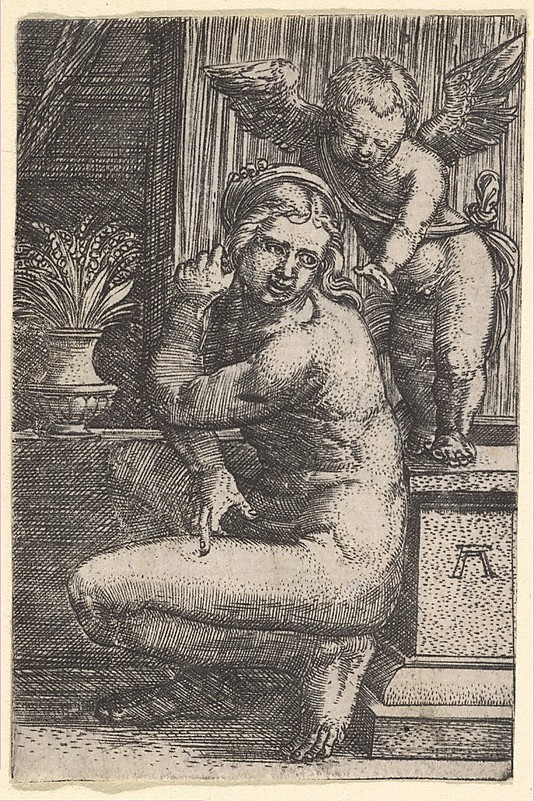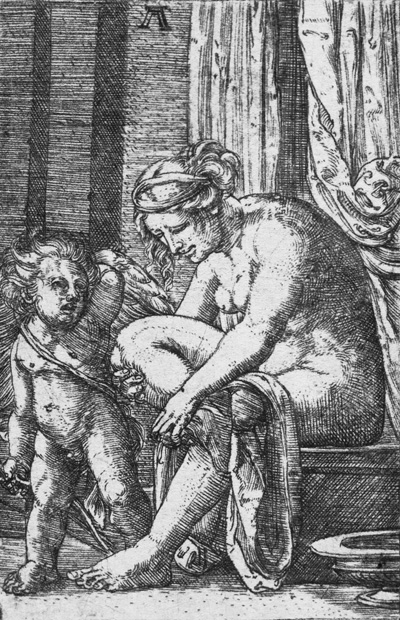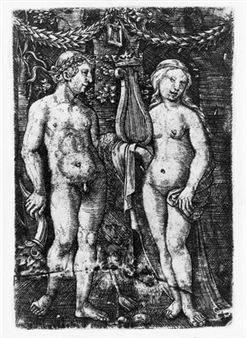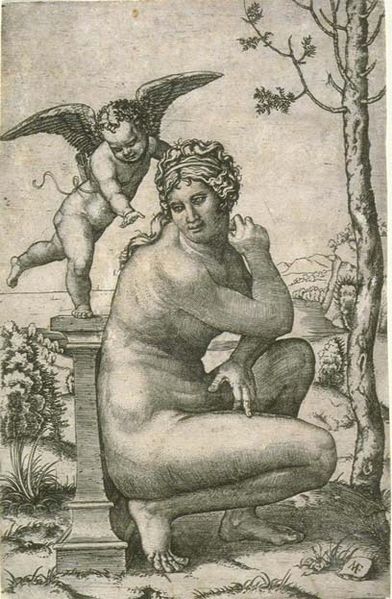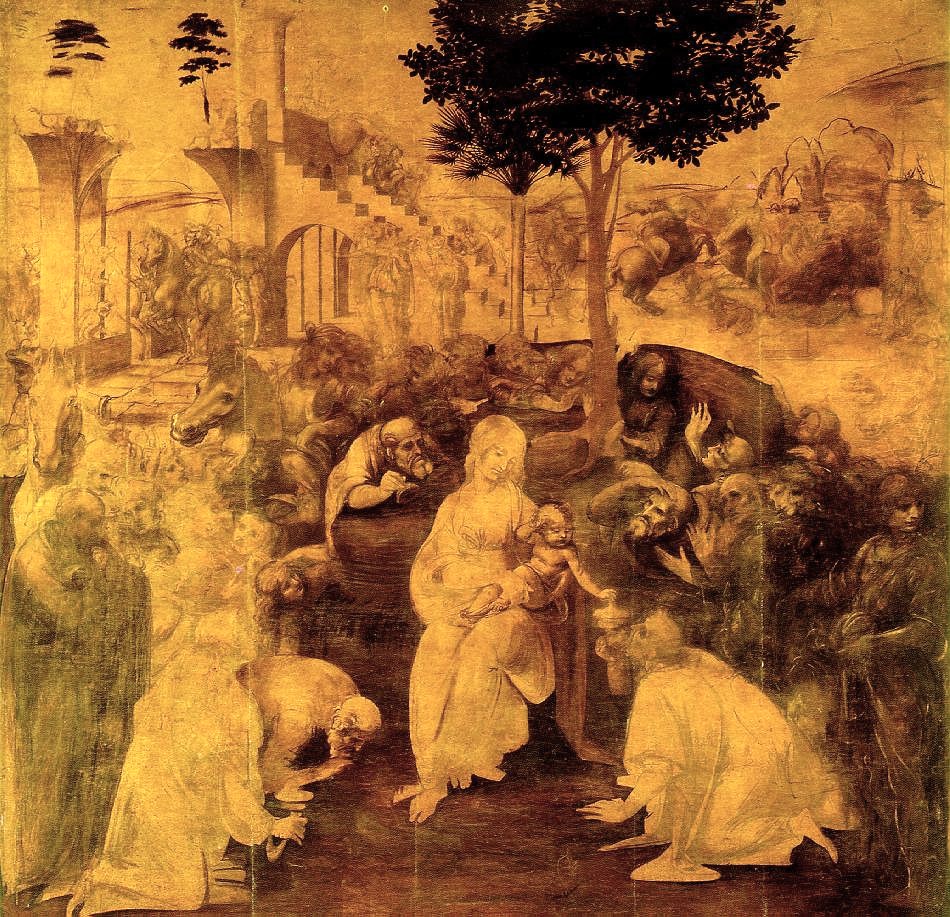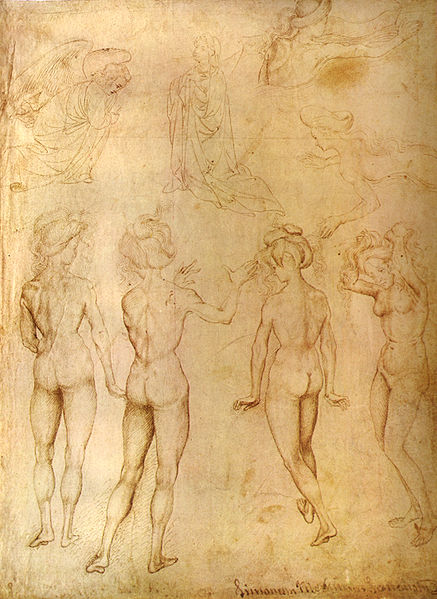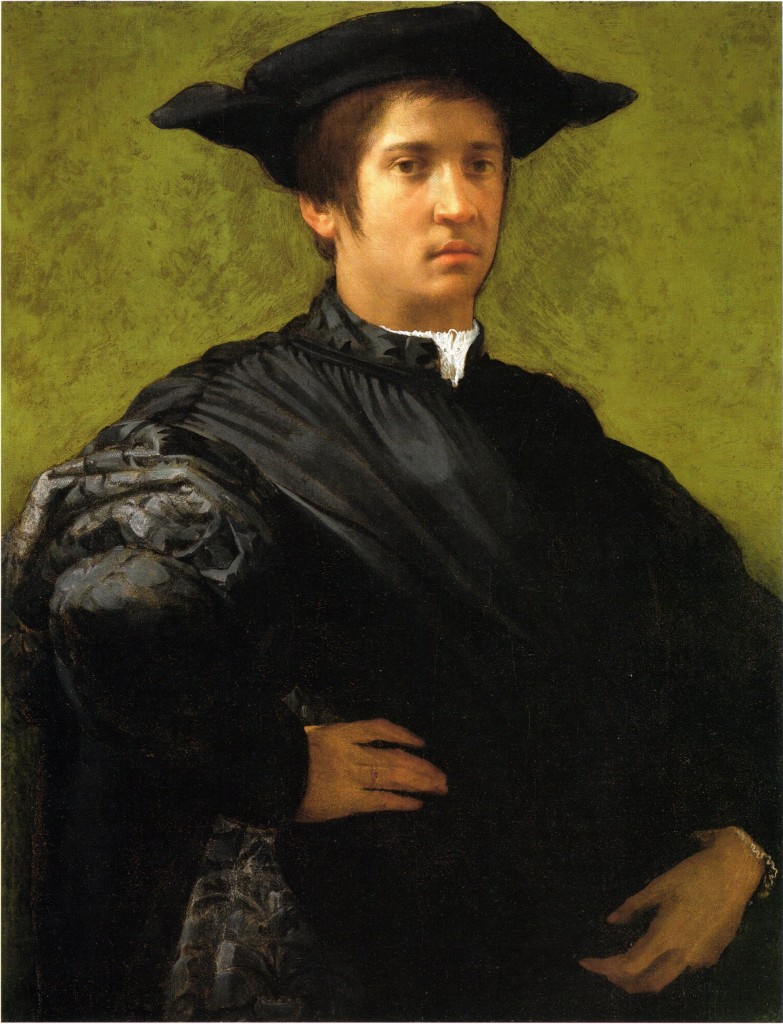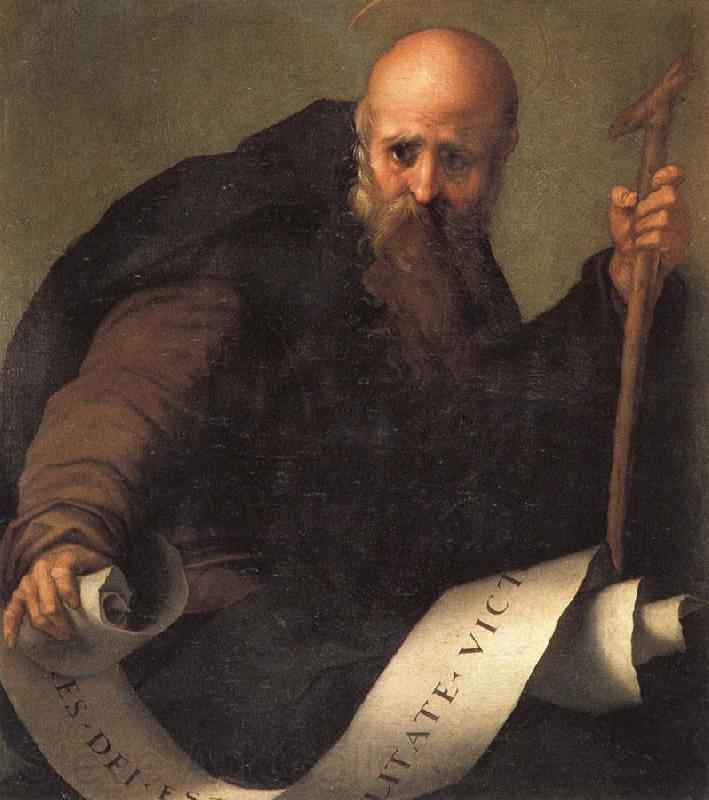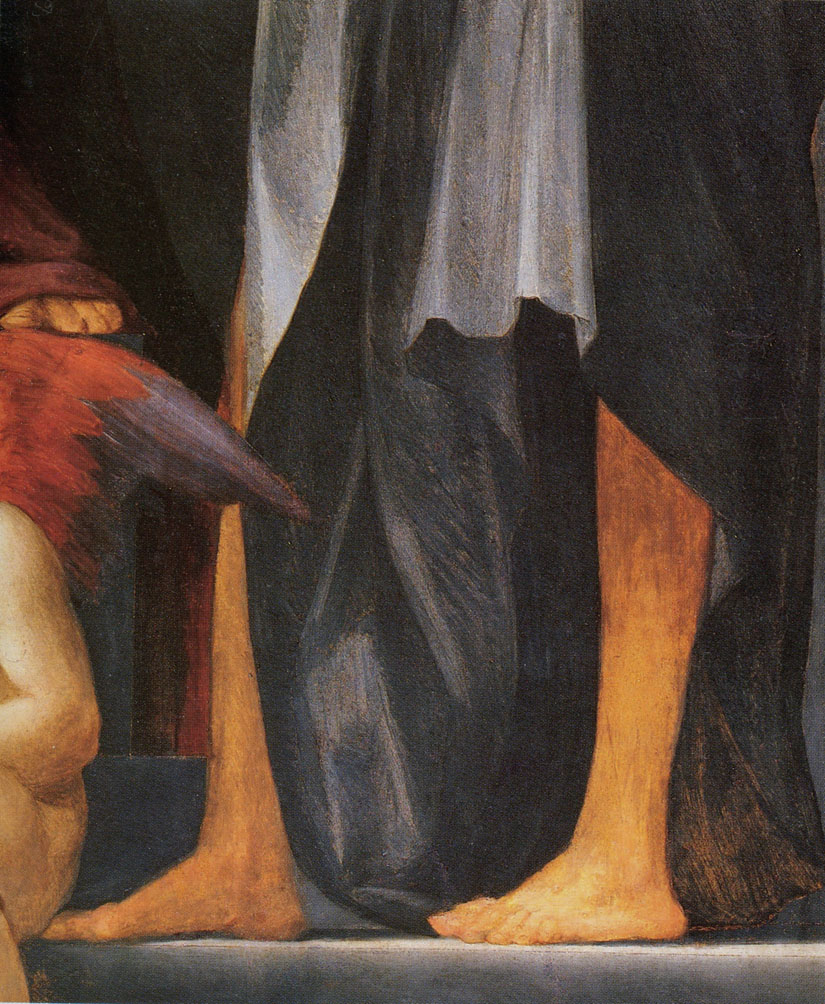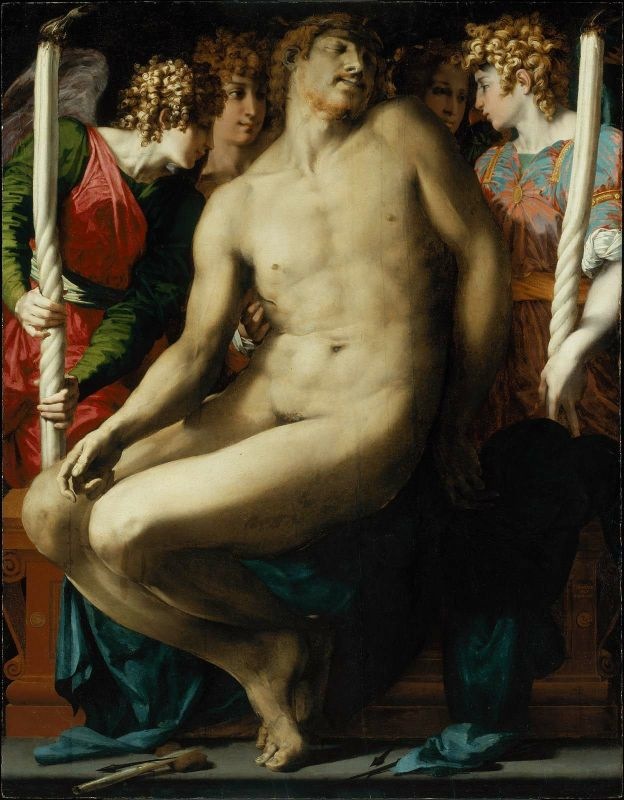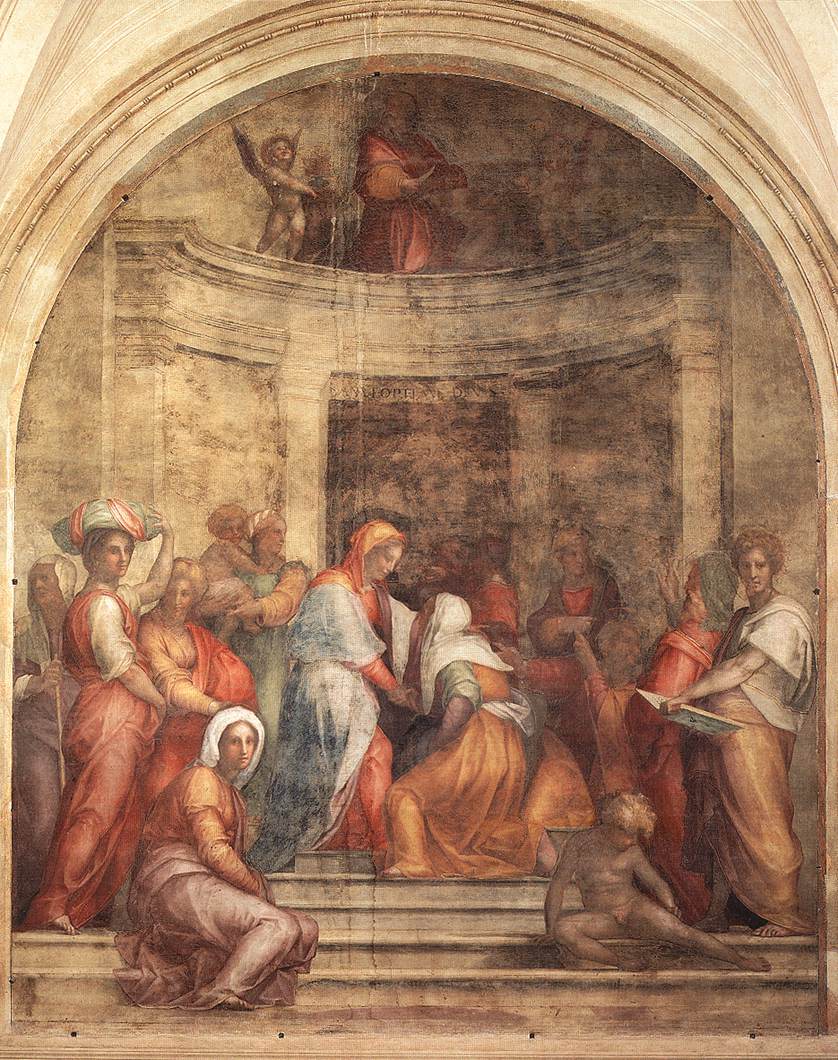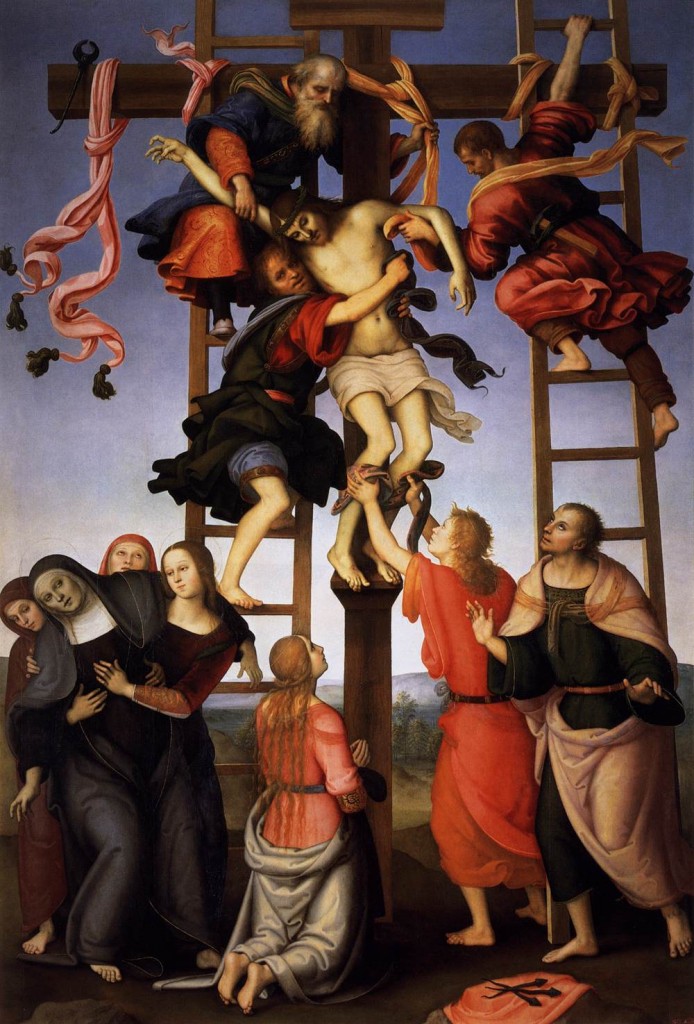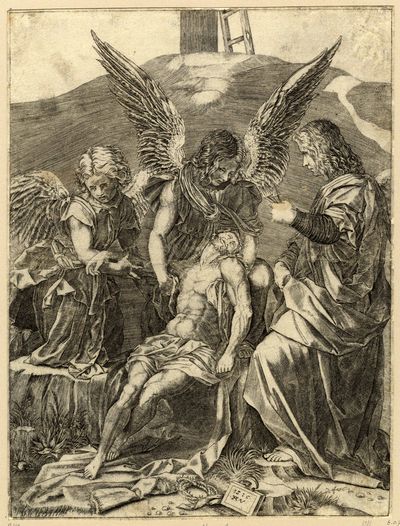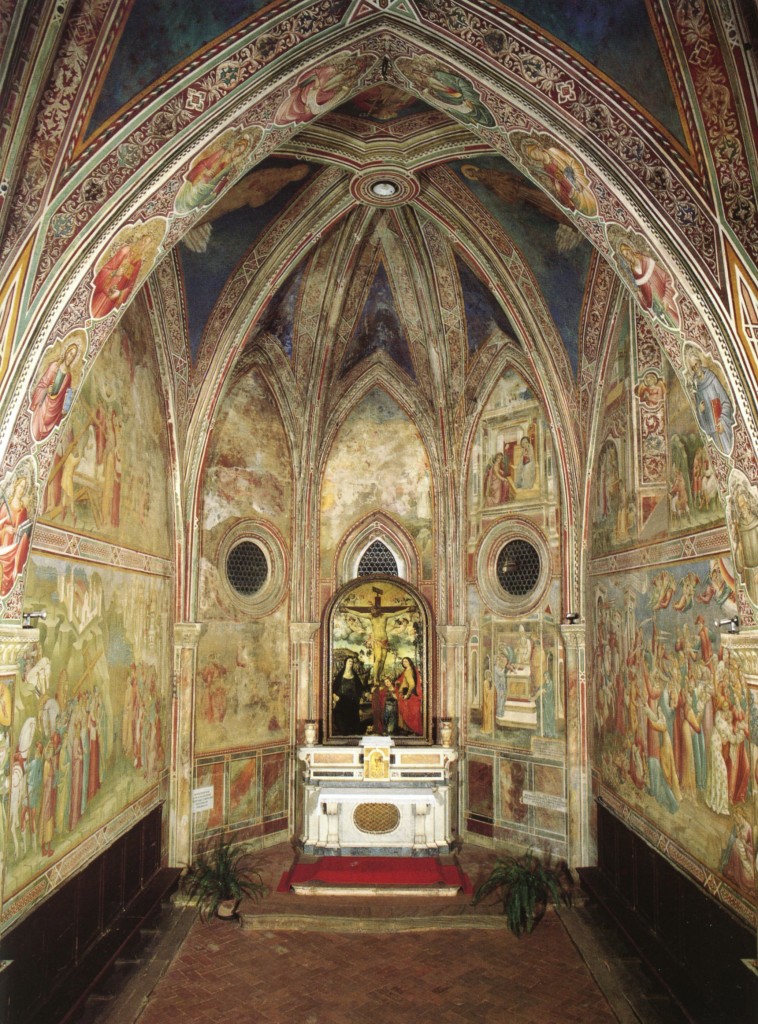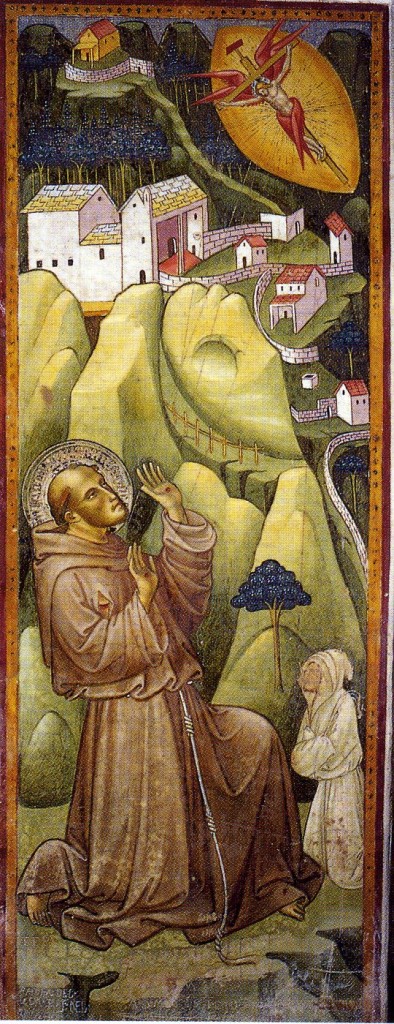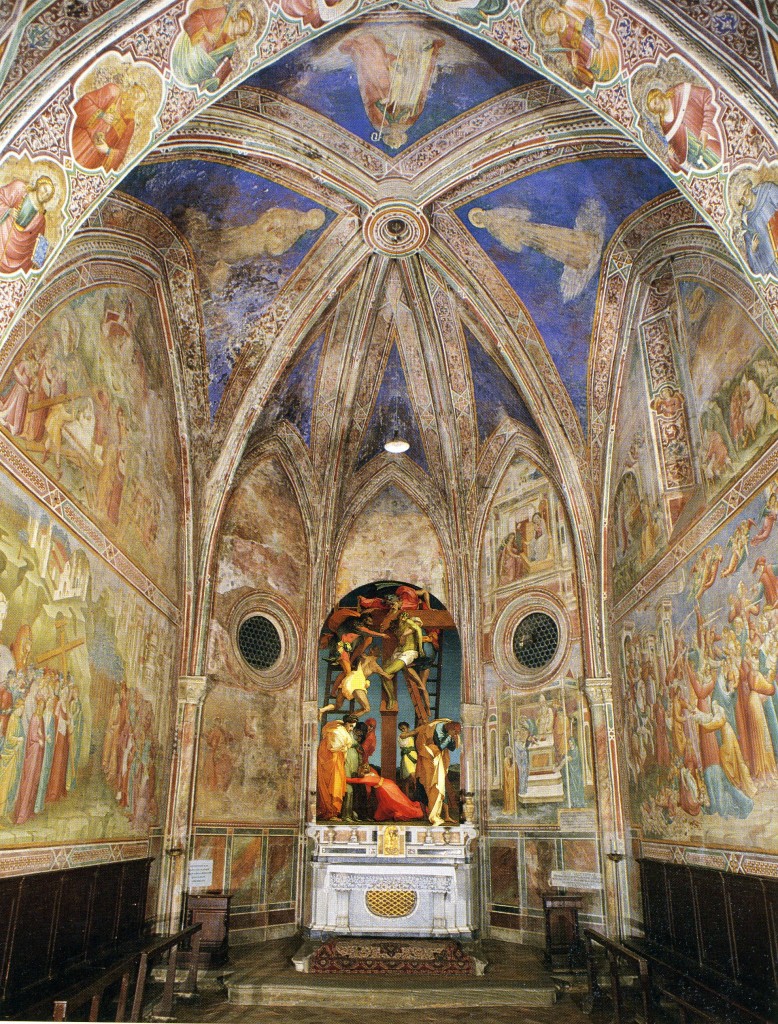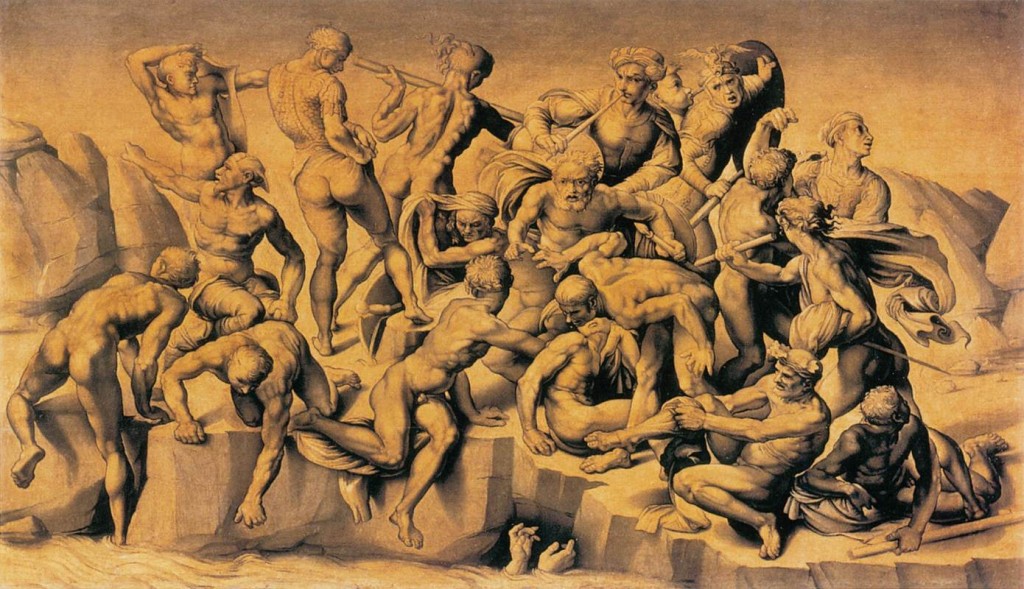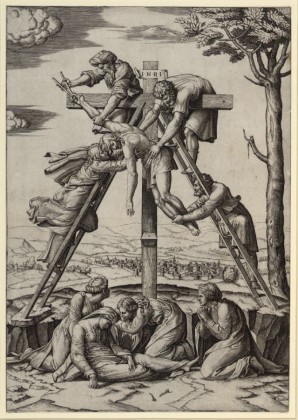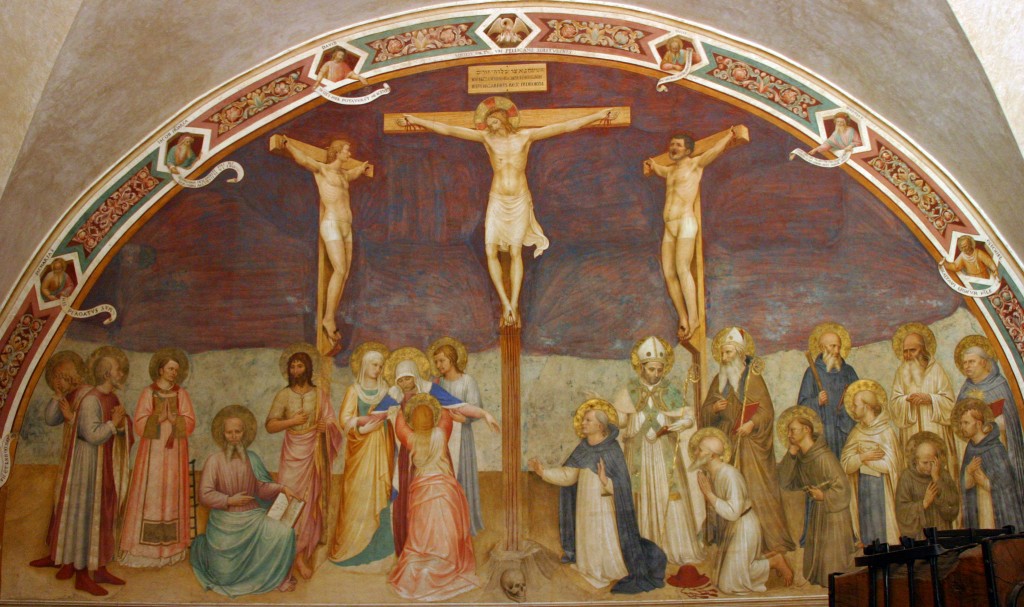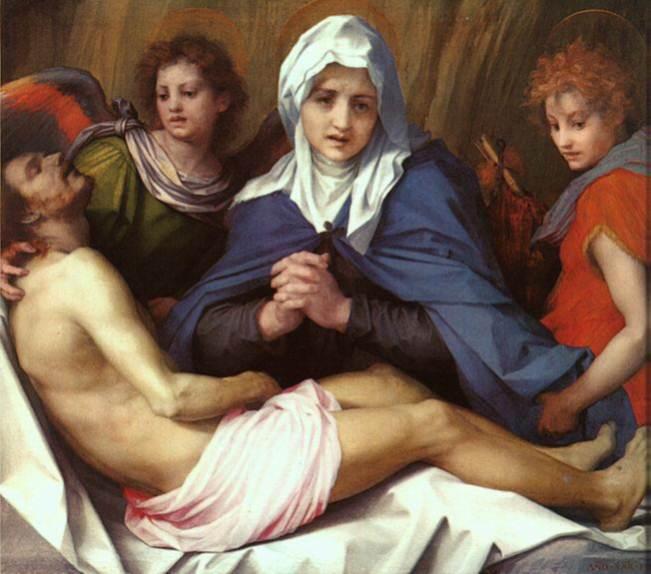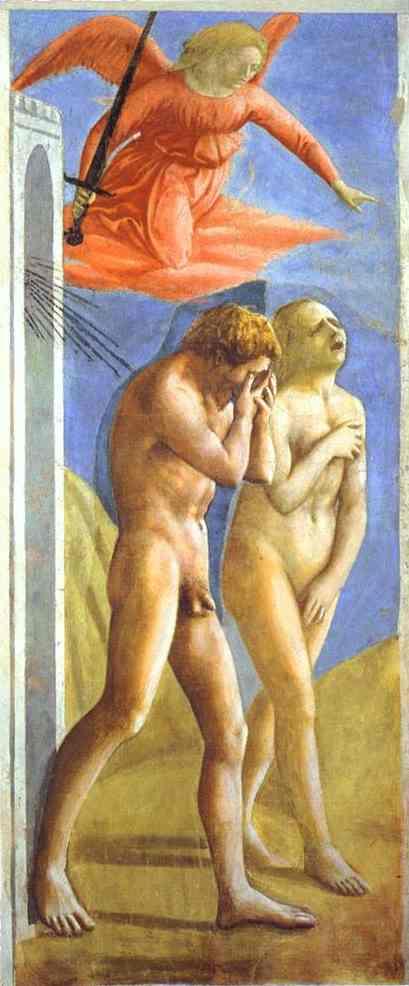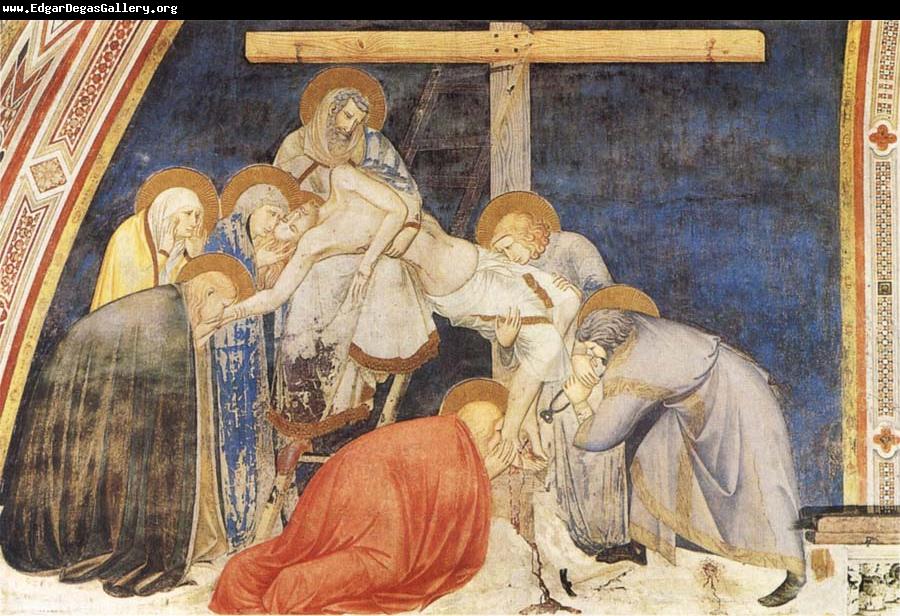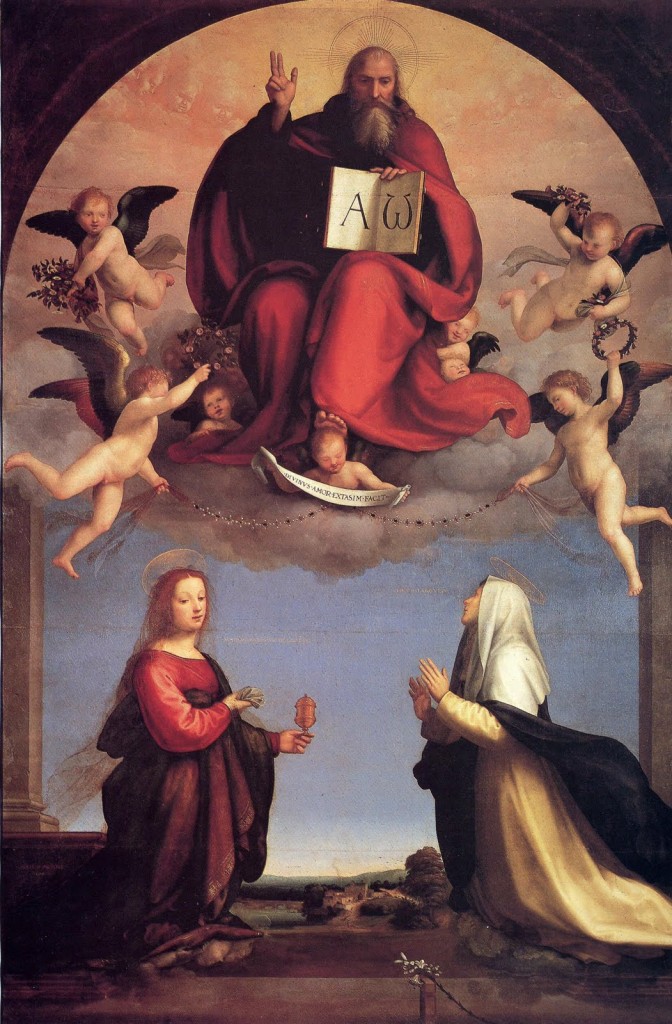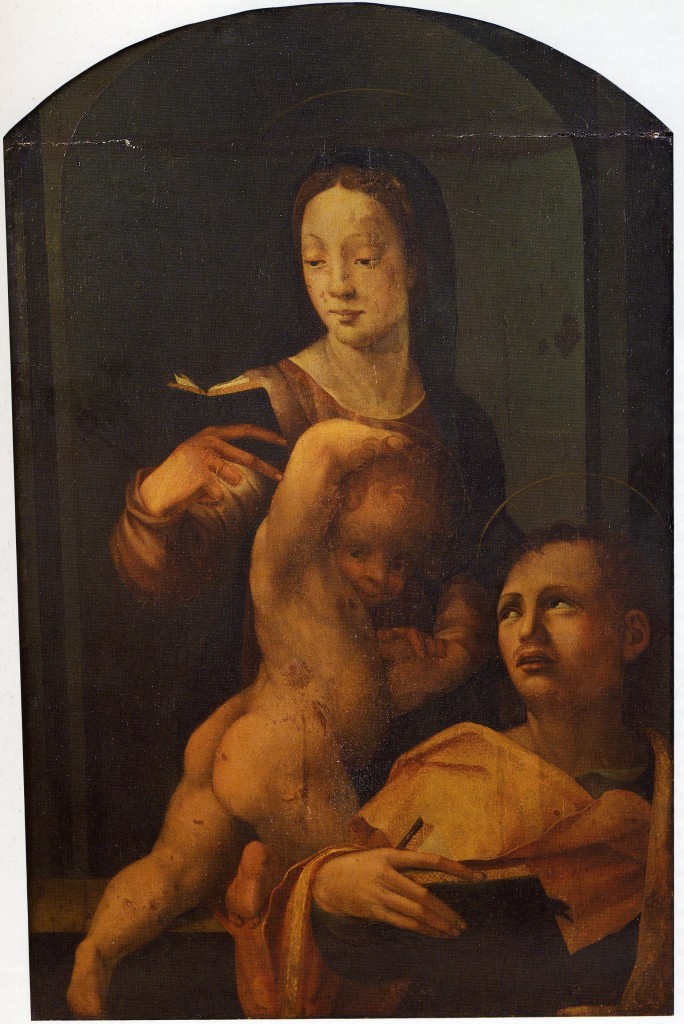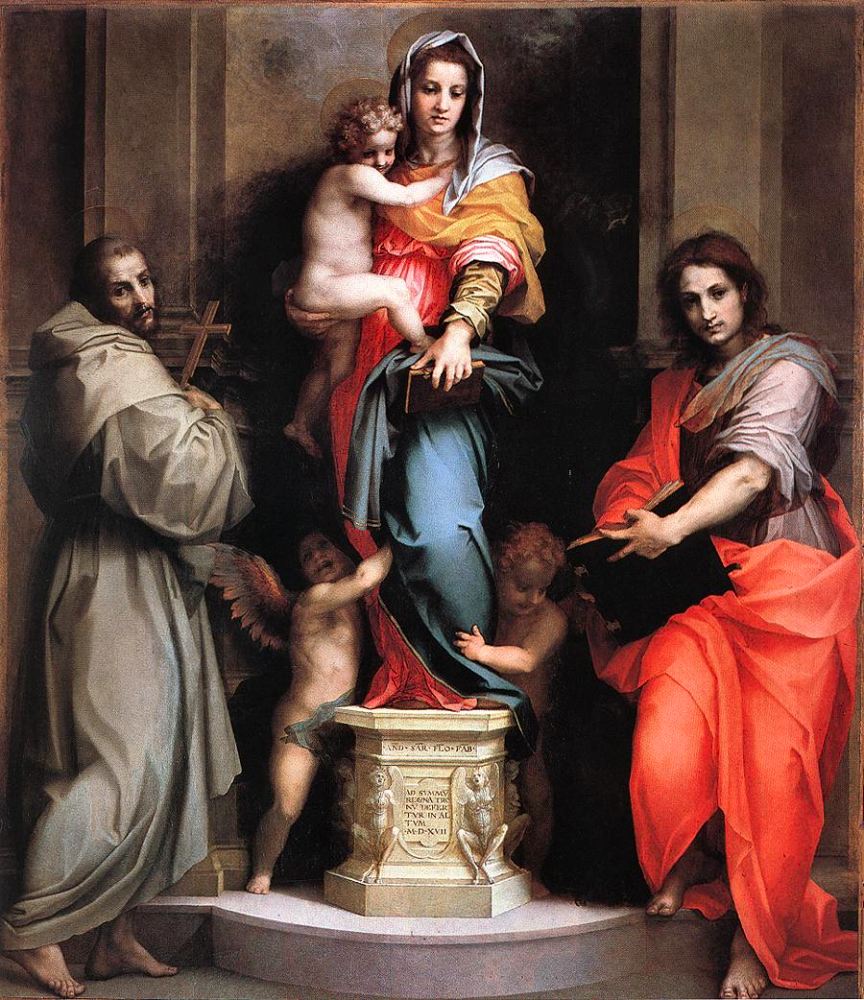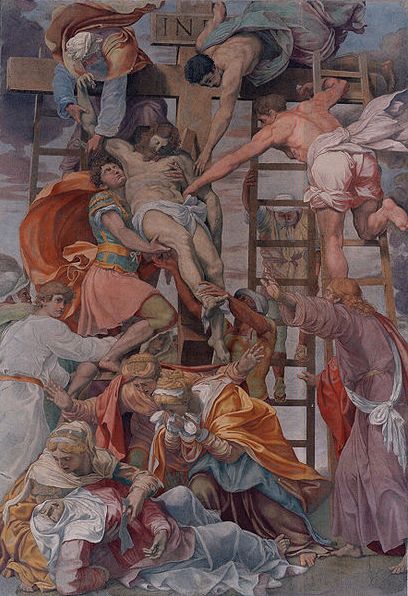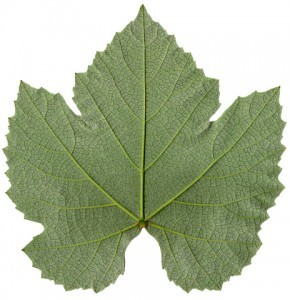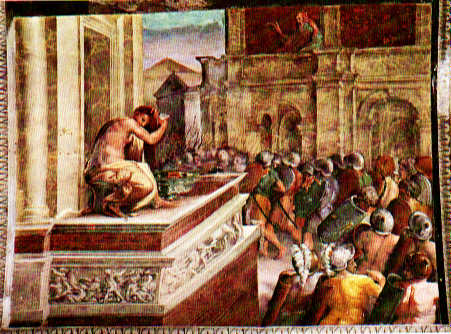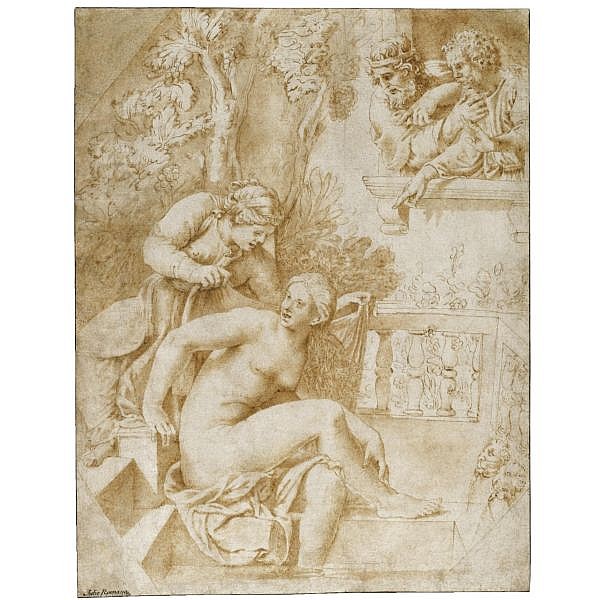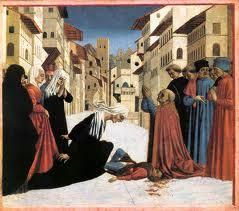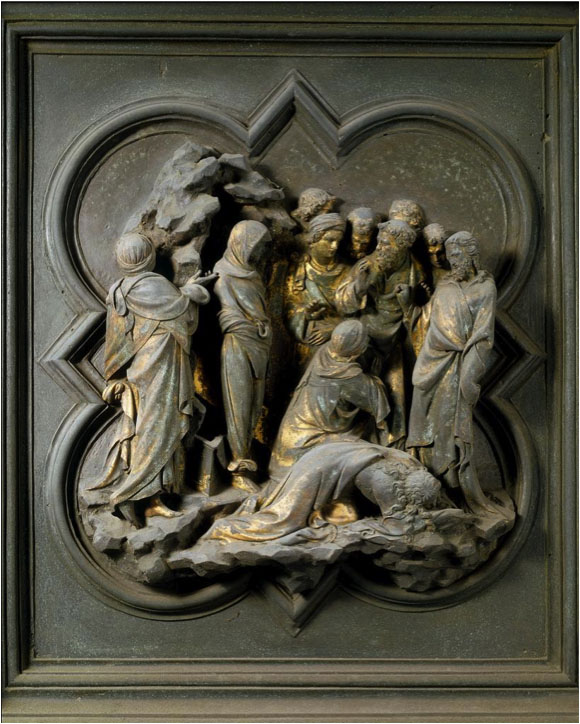After the document of 3 November 1518 regarding the litigation over the altarpiece intended for the church of Ognissanti there are no records pertaining to Rosso’s artistic activity in Florence until the signature and date on the Dei Altarpiece of 1522 (P.12). On the three years 1519–1521 Vasari wrote but one sentence: “Poi lavorò al signor di Piombino una tavola con Cristo morto bellissimo, e gli fece ancora una cappelluccia: e similmente a Volterra dipinse un bellissimo deposto di Croce.”1 Yet this is the time of his first fully mature accomplishments, the period in which the picture by him recognized since the turn of the twentieth century as his most famous work was executed: the Deposition of 1521 in Volterra (Fig.P.9a). But these are not the years of works that were much known at the time. Of his work in Florence Vasari simply commented in both editions of the Vite: “Et per le case de’cittadini si veggono più quadri, e molti ritratti (L.14A).”
Reviewing in more detail his life and work in Florence may give some idea of why his output was so limited in Florence in these years and what transpired to send Rosso to Piombino and Volterra.
Between the middle of 1515, when Rosso would have heard that his Assumption of the Virgin at the Annunziata was to be destroyed and replaced by Andrea del Sarto, when at the same time he worked on an altarpiece of which the Angel Playing a Lute is a fragment and a large section was reused as the support for the Portrait of a Young Man in Washington, and 30 January 1518 when the contract for the Santa Maria Nuova Altarpiece was made, no major painting is known to have been commissioned from the artist. He was, however, fortunate in the arrival of Agostino Veneziano and in the prints the engraver would make in Florence from works by Sarto and Bandinelli. These circumstances gave Rosso the opportunity to design his Disputation of the Angel of Death and the Devil in 1517, engraved by Agostino the following year. But its apparent success was not followed by the success of his altarpiece of 1518 for which the artist was not paid the agreed upon price on 6 November. After arbitration was called for by the refusal of the work by the prestigious spedalingo who was shocked by the imagery that Rosso gave him, the artist’s fee was reduced by nine florins of the original twenty-five and Rosso’s painting was removed from sight.
On 18 December 1517, Rosso was brought to the court “nell’arte et università degli Spetiali dell città di Firenze” by one Jacopo di Leonardo da Colle for an indebtedness of eighty-six lire piccioli that the artist had refused to pay, perhaps for pigments he needed for the lost altarpiece of 1514–1515, as suggested earlier. Not having paid this debt again, Jacopo di Leonardo brought the case to the higher Tribunale di Mercanzia on 5 November 1518, where Rosso was ordered to pay his debt, and if he did not he would have to pay a fine of two soldi for each lire owed. On the seventeenth and twenty-fourth of the same month he was called to court again, the fine raised upon each refusal to pay the debt. On 1 December 1518, not only was the fee again raised but it was decreed that the pronouncement of Rosso’s guilt and fines was to be proclaimed loudly throughout Florence.
This history, including financial losses and the shame of public denunciation, presents the collapse of Rosso’s career in Florence. He had now to struggle again toward the recognition of his talents with works of modest size for Florentine houses, as Vasari remarked, and perhaps for small churches and chapels. It would not have been easy for this artist of “una certa opinione contraria alle maniere” of other painters to work his way back to the kind of commissions that had been his with the help of Fra’ Jacopo and perhaps of his clerical brother, Fra’ Filippo, at the Annunziata as well as bear the insult of disregard for his genius and the damage to his pride in his own remarkable individuality. What seems to have happened next is here represented by a number of drawings, a small devotional painting, and two portraits.
Immediately following the S. Maria Nuova Altarpiece are two works, one a drawing representing St. Paul the Hermit in a private collection (Fig.D.3), the other a Portrait of a Young Man with a Letter in the National Gallery in London (P.6). The drawing of the first of the Desert Fathers, whose biography leads those of these anchorite saints written by St. Jerome, may have been done late in 1518 or early in 1519. More likely an original than a fine copy of a lost drawing and otherwise known from a simplified lithographic copy (Fig.D.3 Copy, Lithograph), it is the earliest evidence we have of Rosso’s use of pen and ink and wash. While the appearance of the saint as a thin and bearded old man resembles the figure of St. Jerome in the S. Maria Nuova Altarpiece and some of the figures in the Disputation of the Angel of Death and the Devil of 1517—evident even in such details as the drawing of the knobby muscles and joints—the image of St. Paul is a grander conception. This is visible not only in the greater breadth of his body but also in his pose and gestures that appear more thoughtfully and precisely articulated, and, in their effect, more deeply emotional. It is true that this figure is not grouped with other figures as are the saints in the altarpiece of 1518 and the figures in the drawing made for Agostino Veneziano. Nevertheless, the drama that Paul alone brings forth is less nervous and quick. The expression of feeling throughout the figure is more slowly and carefully paced. The rhythms of the limbs, from the bent right leg to the right arm bent across the body to the raised and bent left arm holding the cross, present a continuity of similar forms and positions that is far more sophisticated than the pose of any figure in an earlier drawing or painting by him. Also, in the flow of the hair and beard and in the tying of the sash around the saint’s waist there is a fullness of forms that is new. Though in most respects the stylistic terms of this image are like those of Rosso’s immediately preceding works there is in this drawing the appearance of an art that is more explicit, more at ease, and yet also more forceful. Here, perhaps, Pontormo’s Visdomini Altarpiece (Fig.Pontormo,Visdomini) set an example for Rosso, or his St. John the Evangelist painted for Pontorme (Fig.Pontormo,Evangelist).2 Perhaps he learned from Michelangelo’s work directly, in particular the St. Matthew (Fig.St.Matthew) with its muscularity and angular shifts of forms, however limited is Rosso’s adaption of them. The light tonality of the St. Paul the Hermit is unlike the darkness and density of the only earlier drawing, the disegno di stampa of 1517. This brightness suggests the coloristic clarity of the figure of St. John the Baptist in the S. Maria Nuova Altarpiece, which in turn may have had its effect upon Pontormo.
But for the large forms and gestures of Rosso’s anchorite saint he might have been a member of the crowd in the Disputation of the Angel of Death and the Devil. At the left side of that drawing (Fig.D.1c) the old man doffing his hat wears a garment that shows a large woven pattern at the neck. This pattern covers his entire garment in Agostino Veneziano’s engraving (Fig.E.109a), suggesting that the draughtsman, by this small notation, indicated to the engraver working in Florence to extend it to the whole garment as he did. It is such a dress woven of palm fronds that is the costume of St. Paul the Hermit outside whose rocky abode grew two large date palms that also provided him with nourishment. The rock upon which the saint kneels in Rosso’s drawing is a suggestion of the cave-like abode in which he lived high up and in hiding from imperial persecution. After many years he was discovered by St. Anthony Abbot, as depicted by Pinturrichio around 1492–1494 in the Room of Saints in the Vatican Apartments (Fig.Paul the Hermit). What place this saint might have had in Florence around 1518 or 1519 is still to be discovered. Perhaps the story of St. Paul’s fate and seclusion struck the devout Rosso to identify with this Desert Father following upon the spedalingo‘s condemnation of his altarpiece and the professional persecution it implied
The draftsmanship of St. Paul the Hermit is related to the pen drawing of the Disputation between Two Old Men, but in the St. Paul the Hermit the description of the saint’s special garment with six or seven parallel lines to indicate the fronds, generally shown as Rosso depicts them, prevented the use of the pen for hatching and cross-hatching to create shadows. This can be seen first of all in the small shadows cast by the relief of the individual woven squares. Consequently all the shadows and modeling were done with washes set within contour lines made with the pen. But some details, such as the musculature of the arms, are drawn largely with the brush and various washes. There seems to be no precedent for this precise manner of using pen and ink and wash, but it became, with heightening in white and sometimes done upon tinted paper, one of Rosso’s methods of making highly finished compositional drawings such as the Design for a Chapel of 1528–1529 (Fig.D.37a), and used often in France in drawings for the main frescoes in the Gallery of Francis I at Fontainebleau.
The clarity of presentation in St. Paul the Hermit is also recognizable in Rosso’s Portrait of a Young Man with a Letter (Fig.P.6a). Dated 22 January 1518 Florentine style on the letter that the figure holds but 1519 by modern reckoning—and assuming that the date records when the picture was made, or begun or finished, and does not commemorate another particular occasion that took place on 22 January—places it immediately after the S. Maria Nuova Altarpiece. The portrait shares with that altarpiece its free execution although not the angular definition of the drapery of the two flanking saints in the Uffizi picture.
The portrait presents a special awareness of the viewer by the sitter looking out at the spectator upon lifting his head from the letter that he has been reading. This action gives to the subject a sense of intelligence that corresponds to what appears to be an aspect of the discourse in the S. Maria Nuova Altarpiece. The body and the head of the figure are held erect and his hands holding the letter are suspended before him. His pose appears sudden and momentary. But the richness of his large costume, the uprightness of his posture, and the directness of his glance give him an authority that indicates his preparedness for any intrusion such as the viewer’s unexpected appearance before him. He seems a gentleman although not a courtier in the terms set down by Baldasarre Castiglione, first published in April of 1528 (when Rosso immediately acquired a copy).
The particular quality of Rosso’s use of a letter in this portrait can be judged by comparison with its role in Franciabigio’s Portrait of a Knight of Rhodes in London (Fig.Franciabigio,London).3 Here the figure is seen somewhat from the side with his head turned in our direction. The full extent of the letter is also visible suggesting that its contents could be available to us, as is not the case in Rosso’s portrait. There is, furthermore, an ease in the relation of Franciabigio’s sitter to the viewer that is quite unlike the stare the viewer faces before Rosso’s young man. He is not separated from us by a parapet or set before a charming landscape, nor is Rosso’s sitter described in such detail as Franciabigio’s.
Like the S. Maria Nuova Altarpiece the portrait does not give the impression of having been conceived in terms of drawing. This is particularly evident in the definition of the eyes and of the hands that look painted without the benefit of having learned their anatomy from having studied and drawn them carefully. The hands strike one as inordinately small and stiff against the large forms of the billowing sleeves. The head, therefore, appears quite large, and a sense of spatial tension exists between it and the arms and hands held before his body. No compositional pattern joins them pictorially or brings them together physically. Although somber in tone, the portrait has been provided visual drama, in addition to that given by the slight action of holding up the letter and glancing over it at the viewer, through the juxtaposition of light and dark areas and by the broad spread of the pattern of his steely-gray blue brocade sleeve at the right. Seen against an olive-green background the pink touches of his dark complexion and the slightest indication of pink in the letter’s seal subtly gain in their effect. Though not so finely accomplished a work of art as Sarto’s so-called Portrait of a Sculptor in London (Fig.Sarto,Sculptor), Rosso’s portrait is, at this time in Florence, the finest and most interesting painting of a person and personality other than Andrea’s more impressive and sophisticated portraits.
Both the Portrait of a Young Man with a Letter and the St. Paul the Hermit show the extent of the usage of the terms of Rosso’s early art although neither exhibits the ambitions of the slightly earlier commissioned S. Maria Nuova Altarpiece. The style of the drawing and the portrait is only slightly enlarged beyond the possibilities suggested by the altarpiece, which itself contains in summation the contents of Rosso’s art of the previous few years.
With hindsight, however, it is apparent that the extraordinary style of the pictures of 1521, the Deposition at Volterra (Fig.P.9a) and the altarpiece from Villamagna (Fig.P.10a), is not merely an extension of what appears in the altarpiece of 1518 that had been rejected. Nevertheless, changes not fully evolved until 1521 are already evident in the St. Paul the Hermit and the approximately contemporary Portrait of a Young Man with a Letter. The largeness of these images is new, especially as it is not merely the result of an abundance of the stuffs that Vasari criticized in the Assumption of 1513–1514. Largeness alone is not so much the issue as is a quality of assurance that comes from the finer use of it. In the drawing that quality of assurance that is visible in the pose of the figure is also in the draftsmanship of it, indicating again that the drawing is autograph. What we see, however, may not be absolutely certain evidence. Still, in the drawing of the hair and of the sash there appears a careful use of line for the creation of shapes and patterns that is found in Rosso’s one earlier surviving drawing, the Disputation of the Angel of Death and the Devil, that had been made as the model for a print. Looking at the patterns of the saint’s woven garment and those formed by the shapes of the bare white paper and by several values of wash, the aesthetic conception of the St. Paul the Hermit is close to that of the almost monochromatic Portrait of a Young Man with a Letter. The implications of new concerns in these two works are further realized in his slightly later Holy Family with the Young St. John the Baptist in Baltimore (Fig.P.7a) and in his Study for an Altarpiece in the Uffizi (Fig.D.4).
In spite of its small size Rosso’s Holy Family with the Young St. John the Baptist provides good evidence of his personal expression and individual execution around 1519. Perhaps unfinished or only a thinly painted sketch, the Holy Family makes an interesting comparison with Rosso’s altarpiece of 1518. Many of the brushstrokes of the small picture in Baltimore are long and fluid and quite different from the shorter blunt strokes of much of the earlier picture. Furthermore, the contours of the forms are more continuous in the Holy Family. The initial drawing on the panel is visible in many places and is quite unlike the handling of any earlier work. Only the St. Paul the Hermit shows something of the same pliable extended line in Rosso’s painting. This penchant for slender and angular forms and shapes in the altarpiece are not missing from the smaller and slightly later picture, but these are now less rigid and juxtaposed. Instead of the chiseled facets of the drapery of St. John in the altarpiece of 1518 (Fig.P.5d) the straight lines and planes of the Virgin’s drapery in the later picture turn through sharply bent curves. The stiffness of Rosso’s earlier saints has been relaxed and a quality of pliancy has been introduced. Some forms, such as the Virgin’s head and hand, have been elongated and exhibit a new elegance. A coordination of broad planes and long smooth contours, and not the consistent use of chiaroscuro that had been introduced by Leonardo, around 1500, suggest fullness and continuity as seen, for example, in the description of the left leg of the child. Whereas Rosso’s earlier works could fascinate by the diversity and unusualness of their invention, none has that element of poignant grace that is so touching in this small picture and that modulates its strangeness. There is even in this Holy Family a degree of humor, a sign, perhaps, of a humanity that is less anxious than it appears in his earlier works, a humanity that may already be visible in the St. Paul the Hermit. The small painting shows a degree of change that Rosso’s style has undergone since the year before. The modesty of the painting and its unambitious and unfinished character reveal, within the work’s small dimensions, a new but already accomplished draftsmanship and fluid modeling. There is little special interest in color. The monochromatic tonality of the painting is composed of tan-ochre with areas of generally dark green shading. The Holy Family is little more than a sketch but the handling of line and shape and form is deft and secure. So is its use of a somewhat new figural vocabulary.
The little St. John the Baptist is clothed in the simplest brown garment (an animal skin?) without a sleeve that reveals his chubby and muscular arm. He wears a wreath of small grape leaves. These references to Bacchus, current in representations of the saint in other Florentine painting of around the same time, is accompanied by a gesture of prayer toward Christ along with, what seems indicated by his widely open mouth, a loud sound of joy. A cross made of reeds suggests the rustic origins of St. John that is shared with the implications of the grapes leaves related to the rites of ancient Bacchic festivals. A relationship to the pagan past is also an aspect of the humanistic reconciliation of it to the worship of the new Christian God.4 While he stands on a tasseled pillow to indicate his royal status5 he grasps his mother in fear of the implied approach of what lies beyond. Old St. Joseph, with unkempt white hair, moustache, and beard merely watches the reaction of Christ. The Virgin, with an elongated and emphatically upright head, protects her child by her own regal bearing and by her left arm and hand reaching around her son. In the very center of the small painting her left nipple, evident through her garment, indicates the source of nourishment to the infant Christ. Although small and minimally executed Rosso’s Holy Family shows the fullness of the Rosso’s knowledge of what would be sought in a small devotional picture in Florence around 1519 by educated patrons who would have been aware of the special emotional and devotional aspects of this modest painting.6
This new vocabulary of fuller, more rounded forms, and of heads with large round eyes is clearly derived from Pontormo. The regular swelling contours of Rosso’s figures, the smooth surfaces of their bodies and the long pointed fingers of the Virgin closely imitate Pontormo’s draftsmanship of around 1519, as in his study for the legs of St. Michael from Pontorme (Fig.Pontormo,Empoli, and Fig.Pontormo,Florence, 6506F) and in the Study for a Pietà, also in the Uffizi (Fig.Pontormo,Florence, 300F recto).7 Although this manner of drawing is already indicated in Pontormo’s slightly earlier painting of Joseph in Egypt (Fig.Pontormo, Joseph in Egypt), for which survives only three rather rough sketches.8 The precise kind of draftsmanship that appears in the immediately subsequent drawings of around 1519 was also new to Pontormo just then, although there are some indications of it in his own earlier drawings. The effect of this draftsmanship is of a supple, subtle and sensuous pliancy that is ultimately derived from Michelangelo. It is neither so fluid nor so emotionally and compositionally forceful in Rosso’s small paintings but, insofar as it has been adopted by him, especially in the Holy Family it has transformed the terms of his rather static and angular style into a much more pliant artistic mode. In retrospect it seems possible to observe that the grandness or largeness of Rosso’s style as seen in his Portrait of a Young Man with a Letter was an end point in the pursuit of the terms of Rosso’s early art. Recognizing the value of certain aspects of Pontormo’s art at this moment and utilizing them sympathetically by putting aside, it would seem, his “opinione contraria” and argumentativeness, Rosso’s art began to achieve, around 1519, its first maturity. If this is too large a conclusion to be drawn from Rosso’s St. Paul the Hermit and from the small picture in Baltimore, it can be further supported by the style of a remarkable contemporary drawing, the Study for an Altarpiece (Fig.D.4).
Executed in black chalk, but having the appearance of gray, and on paper with a slight mat texture, the drawing has a degree of finish that is characteristic of almost all of Rosso’s surviving drawings. Compared, however, with the dark Disputation of the Angel of Death and the Devil (Fig.D.1a), the Study for an Altarpiece appears very light, almost transparent in places. Broad areas of highlight give to the figures a brightness and weightlessness transcending the limits of natural appearance that is generally the descriptive function of light and shade. This kind of tonality is already found in the figure of St. John the Baptist in the altarpiece of 1518 (Fig.P.5d), and in the St. Peter the Hermit (Fig.D.3) of 1518–1519. It becomes even more extraordinary in 1519, resembling Pontormo’s two panels from Pontorme (Fig.Pontormo,Evangelist and Fig.Pontormo,Empoli).9 But it is quite likely that it was Rosso’s art that set the precedent for the submission of chiaroscuro to color and color values, only fully realized by him in the pictures of 1521.
Compared with the S. Maria Nuova Altarpiece the slightly later Study for an Altarpiece appears almost like a re-invention of that picture stimulated by an interest in a new set of artistic possibilities. The rigid symmetry of the altarpiece has been subtly broken by the more varied postures of the figures and by the quick shift of physical and psychological expressions across, or rather around, the not very strongly indicated central axis of the composition. St. John the Baptist is seated at the left, the saints at the right are standing. St. John’s almost nude body turns in a manner that complements the posture and movement of St. Sebastian, also almost nude. St. Margaret’s kneeling posture and rich folds of drapery form a counterpoint to the postures and nudity of the two young male saints, and to the broad St. Joseph who is seen standing and largely from the front reading from a book. The postures and gestures of the figures are so interrelated by a tense but pliant grace that one senses here not the argumentative tone of the S. Maria Nuova Altarpiece but instead a sense of mutual emotion among the saints. Theirs seems not a reaction to the discussion of a point of religious doctrine. Instead the saints seem to be responding to what Joseph is reading from a large book, towards which St. John the Baptist glances and the Virgin, closer to her spouse, seems to look at the text itself within the book. The Christ Child, with one hand touching his mother’s breast, turns his head away and slightly down in the direction of the Baptist’s gesture and of St. Margaret who holds a small book and kneels upon the horned and bat-winged dragon that had swallowed her but from which she escaped though the cross she carried with her that irritated the beast’s stomach. There is an aspect of revelation, suggested by the books, that is further indicated by the bright light that flitters across the figures from the left. These characteristics, as well as details of poses and gestures that give the aspect of a dramatic event, almost certainly indicate that Rosso has been stimulated by Pontormo’s Visdomini altarpiece of 1518 (Fig.Pontormo,Visdomini). But in 1519 Pontomro’s style had also changed from that of his altarpiece, and Rosso was already seeing the Visdomini altarpiece with Pontormo’s more recent art in mind. Pontormo’s St. John the Evangelist and St. Michael are very closely related to Rosso’s figures in the Uffizi drawing that was conceived around the same time.
So thorough does Rosso’s conversion to Pontormo’s style appear to have been at this moment that one might all too easily recognize Rosso’s style in this drawing as merely Pontormesque. In fact, many aspects of the S. Maria Nuova Altarpiece survive in this drawing: the proportions of the Virgin’s head, the Sartesque flex of a wrist or finger, the interest in emaciated anatomy, the faceted drapery, the arrangement of the figures within a shallow space. Seeing these and other close similarities to his own altarpiece Rosso’s drawing would never actually be mistaken as Pontormo’s. What instead is recognizable, visible also in the Baltimore picture, is the extraordinary maturation of Rosso’s own ability to inflect more precisely the nature of his own sensibility. Given that this sensibility had first been shaped by many of the same sources that lay behind Pontormo’s art it is not altogether surprising that the latter’s art should be so well understood by Rosso. The reverse was also certainly true. What is especially interesting is the use of this understanding beginning possibly at the end of 1518 and fully utilized by Rosso in 1519.
Rosso had known Pontormo at least since around 1512 when, it was reported to Vasari, they worked together on the predella of Sarto’s San Gallo Annunciation. If true, their styles at this very early moment in their careers would probably have been sufficiently similar to Sarto’s style to make it possible for them to work together on this predella. We may know the extent of Rosso’s attachment to Sarto’s art from the style of the Portrait of a Young Woman as Mary Magdalen in the Uffizi (Fig.P.1a). From that time on his and Pontormo’s styles and careers proceeded independently except between 1513 and 1516 when they did adjacent frescoes in the atrium of SS. Annunziata under the patronage of Fra’ Jacopo. By 1518 their styles were quite different as shown by the individual manners of the S. Maria Nuova and Visdomini altarpieces. Still, such differences as there are were derived from very similar sources, a circumstance that all the more points up the extraordinariness of the appearance of these two large but dissimilar works in Florence in the same year. What is also extraordinary is that such different styles in 1518 should have resolved themselves into such similar ones no more than a year later. This may have occurred to some extent because both Rosso and Pontormo recognized the special circumstance of Florentine painting at this moment.
With the death of Fra Bartolommeo in October of 1517 and Sarto’s departure for France in June 1518 Florentine art was without its leading masters.10 It had instead two young but, already at twenty-four, mature rivals for the prestigious position Andrea held. Rather than contending for this position Rosso and Pontormo seem to have supported each other in their individual artistic intentions. Given what Rosso seems to have known of Pontormo’s works of around 1519, such as his drawings and the panels painted for Pontorme, it may be suggested that just at this time Rosso frequented Pontormo’s studio. Knowledge of the publicly exhibited Visdomini altarpiece is not sufficient to explain all the Pontormesque aspects of Rosso’s art around 1519. But why this sudden and exclusive response to Pontormo’s art? It has been suggested that about this time Pontormo made a trip to Rome where he was especially impressed by the Sistine Ceiling.11 No such trip is actually recorded, nor is the evidence for it sufficiently explicit to require this conclusion. It is also possible that Pontormo’s friendship with Michelangelo himself seriously began around 1519 in Florence and that this relationship made possible access to Michelangelo’s drawings. There is no reason to believe they would otherwise have been available to him. In either case it may well have been Pontormo’s direct knowledge of Michelangelo’s Roman works that drew Rosso at this particular moment to Pontormo’s studio. Rosso’s own works do not reveal a close independent study of Michelangelo’s art and one may wonder if his “opinione contraria” may not again have had something to do with his reluctance to gain access to what Pontormo seems to have sought and obtained. For while the suppleness of the bodies in Rosso’s Study for an Altarpiece is Michelangelesque, these bodies are without the physicalness of Michelangelo’s but instead with the appearance of how Pontormo had already subtracted it.
Unlike Pontormo’s Michelangelesque drawings of this moment, such as the Study for St. Michael’s Legs (Fig.Pontormo,Florence, 6506F) and the Study for a Pietà in the Uffizi (Fig.Pontormo,Florence, 300F),12 Rosso’s drawing does not suggest the record of actual observation. The drawing approximates in black chalk the appearance of a finished painting, like Pontormo’s two saints from Pontorme. While individual drawings from models may have been made prior to the execution of this very finished compositional drawing, the drawing itself contains contradictory evidence in regard to the role that such preparatory drawings, if in fact there were any, may have had for Rosso. The figures of St. John and St. Sebastian could first have been studied from life. But the figure of St. Margaret presents another kind of invention. The pose of this woman seen from the back yet turning toward the front is derived, it would seem, from the pose of Michelangelo’s Libyan Sibyl (Fig.Libyan Sibyl). The ornamental character of the drawing, as seen, for example, in the turn of the Virgin’s drapery over her legs, also suggests Michelangelo. Nevertheless, Rosso’s St. Margaret, with its very Bartolommesque head, gives no evidence that Rosso had actually seen Michelangelo’s grand sibyl. Rosso may have had knowledge of it through Pontormo whose Study for a Pietà contains a figure that is dependent on it. Furthemore, the invention of Rosso’s young female saint is very little, if at all, derived from a real understanding of the relation and coordination of the parts of the body in such a kneeling position. The folds of her dress conceal rather than clarify the placement of her limbs. It comes, in fact, as something of a surprise to see her right foot come out from under her skirt. That it has any connection to a leg, knee, and thigh under her garment is little more than a surmise. The same can be said of the turn of her torso that can hardly be perceived at all. The knotting of the large piece of drapery at her back is made more explicit than the turn of the actual substance of her body. Whereas the grace of Michelangelo’s sibyl is an aspect of the density of her body, the grace of Rosso’s saint is little more than the effect made by her lovely garment. At first we hardly notice this, so delighted are we by the dress with its richly faceted folds that are so exquisitely delineated and shaded. The apparent bend of her body seems to give a direction to the planes of her drapery, but in fact once the intricate subtlety of them is appreciated the extent of our interest in the figure is both defined and satisfied. This now seems also to be true to some extent of the other figures, including the two nude youths whose bodies are largely composed of small patterns of discontinuous planes of light and shade bound together by fine and tensely curved contour lines. The head of St. Joseph is composed almost completely of small patches of shadow and large areas of white that make a kind of fixed system out of the vigorous planar draftsmanship of some of Pontormo’s studies for the Visdomini altarpiece.13 But while in that altarpiece and in Pontormo’s drawings for it shadow, and very dark shadow, excavates the forms leaving their most salient features exposed to the light—rather as a figure by Michelangelo is released from a quarried block—in Rosso’s drawing and in Pontormo’s two standing saints from Pontorme light (and color) reduce shadow, making luminous even the darkest areas, and transforms the image from the suggestion of a sudden revelation to the indication of sustained emotion in figures of transcendent form. There is already some aspect of this in the figure of St. John in Rosso’s altarpiece of 1518 and in his Disputation between Two Old Men. The partial suspension of the figures from the facts of corporeal matter leads to a certain attenuation of our belief in them, but what remains of this belief has a special poignancy. On the one hand matter seems to have been surpassed; on the other, however, the success of rendering such beautiful superficiality appears to displace a more profound reality. If it is true that the character of these works by Pontormo and Rosso is to a significant extent dependent on the stimulus of Michelangelo’s art, there was sufficient substance in his figures to support the transformation of it wrought by the two young and admiring compatriots.
So finished a drawing suggests that Rosso had the prospect of an altarpiece in mind. The four figures across the back of the altarpiece compose a Holy Family with an adult St. John the Baptist instead of the infant St. John as in the Baltimore painting. The drama of these figures has become more austere and grander in the implication of impending tragedy, as the Christian worshiper would be prepared to experience. Although, the appearance of these figures might be used in the altarpiece of almost any church or chapel in Florence accompanied by subsidiary saints in the foreground related to the names or the interests of patrons or the site. St. Margaret of Antioch makes a rare showing kneeling atop a dragon that had swallowed her but, by the ill effects of the crucifix she carried, was regurgitated. She is also depicted with a book here, likely the smaller New Testament as distinct from, most likely, the Hebrew bible held by Joseph. (As an afterthought Rosso added the thin lines of a cross across the body of St. John but without any indication of how it is grasped!) St. Margaret appears, again kneeling, in Piero di Cosimo’s altarpiece of the Incarnation, now in the Uffizi (Fig.Incarnation), but painted in 1504 for the Tedaldi Chapel in the church of the Annunziata.14 She is paired with St. Catherine of Alexandria who is a patron of the Dominican Order but also revered by the Servites. More important, however, is St. Sebastian, who is shown, without arrows piercing his flesh, rushing into the scene as though too anxious to join the company of the saintly attendants on the Virgin and Her Child. In this alertness he fulfills his role as one of the saints summoned for protection against the plague, but not necessarily a particular outbreak of it. In Florence the cult of St. Sebastian was significantly established at SS. Annunziata in the Pucci Chapel, the main portal of which was at the right end of the façade, and in the ancient Compagnia di San Sebastiano behind the church, that was reconsecrated in 1516. The Pucci Chapel already had a large altarpiece, Pollaiuolo’s Martyrdom of St. Sebastian of 1475, now in the National Gallery in London. The chapel of the Compagnia had, instead of an altarpiece, a reliquary tabernacle preserving a piece of the saint’s head until, in 1529–1530, it commissioned a votive image of the saint from Andrea del Sarto.15 It is possible that Rosso, informed of the reconsecration of the old chapel of the Compagnia di San Sebastiano, possibly by his clerical brother or Fra’ Jacopo, that an altarpiece was being considered for the chapel or imagining the possibility that one would, prepared this Study for an Altarpiece. The subjects of his altarpiece almost certainly indicate a relationship to this particular Compagnia at SS.Annunziata. It was at this church that he had the first commission of his career. So again, here he would start to build his reputation with an altarpiece not of diavoli but also not as a concession to the tastes for the art of Ridolfo Ghirlandaio and the like. The success of this more gracious altarpiece would, he may have hoped, eclipse the failure of his work for the spedalingo of the hospital of S. Maria Nuova.
The attraction of Rosso and Pontormo to the art of Michelangelo around 1519 and 152o in Florence constitutes one of the most significant events in the lives of the two young men. The authority of Michelangelo’s art—and possibly the authority of his personality as well—was now for Rosso’s art the inspiration to a grander and graver style. At this moment Michelangelo’s art and person were not yet also the threat that they could later become for Rosso, perhaps because around 1519 its influence came largely through Pontormo. It did not, therefore, stimulate an obvious Michelangelesque manner as it would some years hence in Rome. For at this initial moment of contact Michelangelo’s art suggested an extraordinary variety of possibilities. Only later in the century would there be recognized what might be called a Michelangelesque canon. It is, therefore, very possible to see Pontormo’s St. John the Evangelist as related to Michelangelo’s St. Matthew (Fig.St.Matthew) and the former’s St. Michael as derived in part from Michelangelo’s Dying Slave (Fig.Dying Slave)16 The latter connection is further indicated by Pontormo’s study of the saint’s legs in the Uffizi. Though drawn from life the legs are posed with a recollection of those of Michelangelo’s statue, and are even rendered with a degree of finish that may emulate the surface of Michelangelo’s carved figure. The cherub at St. Michael’s feet brings to mind the concetto of the Slaves with apes similarly placed.17 While the sensuous litheness of the Dying Slave is an aspect of Pontormo’s drawing, in the painting it becomes, through the armor and drapery, a less physical and more buoyant movement that encircles the figure. Probably from the same source, Rosso created around 1520 an even more unusual figure, his Standing Nude Woman in the Uffizi (Fig.D.5). Somewhat later than the Study for an Altarpiece it is even more Pontormesque, especially the nude woman’s face. Its greater naturalism is related to Jacopo’s studies for the lunette at Poggio a Caiano that were done shortly after the saints from Pontorme, but Rosso’s drawing describes another kind of human being than what Pontormo’s drawings seek.18
No earlier work by Rosso quite prepares us for this image of a woman. Her apprehensive upward glance bears a relationship to the Virgin’s expression in the Assumption of the Virgin at SS. Annunziata, and to some extent to St. John’s in the copy at Tours of Rosso’s lost early painting. Except for the bare-breasted hag in the early Disputation drawing of 1517 in the Uffizi, there is no earlier representation of a naked woman in Rosso’s art. Interesting, then, that the Standing Nude Woman should have an expression similar to the Virgin’s in a scene that could be depicted otherwise as an astonishing miraculous event.
The naked woman’s coiffure with its trailing wisps of hair, ribbons, with one having slipped from its place, and a string of beads that falls across her forehead like the few visible beads seen at her neck, suggests a much different context. It is likely that in undressing, or being undressed by a servant, her hair and jewelry were last to be tended to. These last remnants of how she was dressed heighten the sense of her nakedness and of her awareness of the viewer to the right (her left). Her outstretched but slightly limp right arm, as though a garment had just been withdrawn along it, together with her left arm resting on the top of her head in a gesture of fatigue, that has some correspondence to Michelangelo’s Dying Slave. Perhaps hiding her face creates not only a feeling of languor but also of unease. There is here again a suggestion of Michelangelo’s Dying Slave. But there may be more resemblance to the youth who pulls aside his garment and exposes his nakedness, but no unease, in Pontormo’s Vertumnus and Pomona at Poggio a Caiano (Fig.Pontormo,Nude Youth). However, no image of a woman by Pontormo, in a drawing or a painting, and then only much later in his career, appears nude or so cautious as Rosso’s naked lady. Even the studies for the dressed women in Pontormo’s fresco were done from male models.
As a full-length image of a nude woman Rosso’s drawing of around 152o seems to be unique in the history of Italian art up to this time. While it may be presumed to be a study for an undiscovered project, only representations of the story of Bathsheba come to mind, but more because of recollections of how Rembrandt was to characterize Bathsheba (Fig.Rembrandt) than with any suggestions of its rare depiction in early sixteenth century Italy.19 What comes to mind instead is Vasari’s comment that rarely a day passed that he did not draw the nude figure “di natural.” In the inventory of his belongings that he left behind when he fled Arezzo in 1529, twenty-eight sheets of disegni ignudi (L.30) plus one other “ignudo rosso” (L.31) were listed, none of which seem to have survived or been discovered. The young Vasari would have known about these daily nude studies directly from Rosso while he was in Arezzo, the implication being, however, that this habit was not a new one. In his Florentine years he would already have established this discipline and become famous in Rome before he ever arrived there himself because of the drawings that preceded him, i quali erano tenuti meravigliosi, attesto che il Rosso divinissimamente e con gran pulitezza disegnava, as Vasari described them. The Standing Nude Woman is the earliest known drawing to which this appreciation of Rosso’s draftsmanship could be applied.
The listing in the Aretine inventory of ignudi need not necessarily refer to drawings of men only, although today’s sympathies and prejudices tend to register this conclusion. On the evidence of the Standing Nude Woman, however, it must be recognized that he also drew from the nude female. Barocchi captioned the illustration of this drawing L’incinta, adding cosidetta in the text. While this is likely not the case, the image of this woman, with her extended abdomen and small sagging breasts, evokes a particular individual and must have been drawn from a nude model that Rosso had before him. The association of a headdress and female nudity, along with the large abdomen of the woman, have their counterparts in some of Dürer’s prints (Fig.Dürer, Naked Women).20 But Dürer’s women are German idealizations that do not show the effects of age that give Rosso’s figure its pathos. This is not to discount or underrate the probable influence of Dürer’s prints. For what is ideal to Dürer was to Rosso an alternative to what was considered the ideal woman in Italian art, such as the Leda in Brussels, attributed to Sarto (Fig.Sarto,Leda)21 that also shows a nude woman with a headdress, as do Leonardo’s earlier representations of the same subject. What Rosso seems to have appreciated in Dürer’s works was their apparent fidelity to nature but not any signs of aging that follow upon the moment of youth’s greatest beauty.
What is so remarkable about the Standing Nude Woman is the absence of any sign of passion or impulsive energy in its draftsmanship that distinguishes it altogether from Pontormo’s drawings. Nor is there any sign in Rosso’s Woman of that quick mode of conceptualization that is characteristic of Sarto’s drawings. Rosso’s drawing appears painstakingly analytical as though feeling, either emotional or tactile, played almost no role in the creation of the image. But the very closeness of the observation of the figure and its graphic analogue in the fine texture of the shading and fine variation of the contours of the drawing indicate a special identification with the subject. This identification, however, seems as guarded as the draftsmanship of the figure is controlled. There is a sense of separation between the observer and what it observed and recorded. The effect of isolation of the figure from the spectator, that comes about through the woman’s pose, has something cruel about it, though this is not to deny the image its human truths regarding beauty, age, sex, and death. Forced to one kind of dramatic conclusion the implications of this drawing will have their ultimate expression in Rosso’s slightly later drawing of Virtù Vanquishing Fortune (Fig.D.6). As Rosso’s attitude of detachment visible in the Standing Nude Woman moves away from immediate experience toward abstraction, these implications will have another kind of ultimate realization, for a moment, in his Moses Killing the Egyptian and Defending the Daughters of Jethro of 1524–1524 (Fig.P.14a).
As the subject of this drawing is not obvious it is difficult to know for what kind of project it might have been done. No surviving painting by Rosso shows a figure that approaches in appearance or feeling the Standing Nude Woman. Nor does she closely resemble any figure in any other early sixteenth-century Italian picture. Most of Rosso’s surviving drawings are not related to paintings by him suggesting that some, perhaps most, of his drawings were never conceived as preparatory to pictures. At the same time this particular drawing is not merely a sketch or a record of a sudden idea. It is a studied invention and yet not altogether a finished work of art or a presentation drawing. There are drawings by Leonardo of this kind that are private in their intentions and for whom no other viewer, or at least no large number of viewers, would have been anticipated. The private concerns that are defined by Rosso’s Standing Nude Woman are of aspects of the human condition that were not part of grand and public art. The transformation of her body from the beauty of its younger form to a still not finally determined older age carries with it the appearance of a similar intermediate psychological state. Not only her upward glance but also her raised arms reveal, as Alberti and Leonardo would have prescribed, the condition of her soul. Realized in this drawing its conception would have been known to few, but one of those might well have been Pontormo. For it is in his Deposition at S. Felicita (Fig.Pontormo,Deposition) and in his Visitation at Carmignano (Fig.Pontormo,Carmignano), more even than in Rosso’s own works, that the implications of this kind of figure were to have their finest fulfillment for public display. Pontormo’s own art, beginning particularly with the panels from Pontorme, anticipated the manner of these later pictures as they also may have anticipated that of Rosso’s own drawing. But around 1520 the responsibility for the invention of this kind of art may have been a shared experience. For a moment, at least, it is just possible that Rosso saw in Pontormo’s art the possibilities of meaning that Pontormo himself then recognized in Rosso’s own works, specifically in such a drawing as this Standing Nude Woman.
The most important question about this Standing Nude Woman may well be the actual circumstance of the making of this drawing. As it is not clear to what narrative it might be related, the drawing may have also to be considered as one of those studies of nude figures that Rosso did almost every day di naturale, as reported by Vasari. He also relates that Franciabigio in the summer drew daily from male nudes among those that he hired as “uomini salariati.”22 For these studies artists might well have posed their model in anticipation of positions that could be used in their paintings. Rosso seems to have done just this with the cartoon that he made for Domenico Alfani and the composition he composed for Giovanni Antonio Lappoli.23 There are, however, almost no drawings of the female nude by Rosso’s contemporaries in Florence around 1520, or for the next several decades. Few subjects that were painted called for a nude woman: the Creation and Fall of Adam and Eve, David and Bathsheba, and Suzanna and the Elders, for rare examples. The most startling image of female nakedness is Franciabigo’s Story of Bathsheba, dated 1523 (Fig.Franciabigo,Bathsheba), the far left scene of his panel representing the Bath of Bathsheba (Fig.Franciabigio,Bath). None of the other three companion paintings, by Pontormo and Bacchiacca, who did two commissioned for the antechamber of Giovanni Maria Benintendi in Florence, had subjects that required even a single nude women. McKillop found this episode by Franciabigio “difficult to assess, for a nude bathing scene has no precedent, as far as I know, in Florence.”24 She probably meant a female nude bathing scene as Michelangelo’s all male Cascina cartoon of an interrupted bathing scene was well known by then. Francibigio’s major source, McKillop pointed out, was Dürer’s Bath House (Fig.Bath House), known in Florence by 1514, but the great cartoon by Michelangelo must have been recalled by Franciabigio. His female bathing scene in an almost total transsexual version of these sources, small though the painting is. Something similar, as McKillop noted, is the relationship between the “woman seated on the edge of the bath, knee drawn up … to Pontormo’s male studies for the Poggio a Caiano lunette,” a relationship mentioned above.25 It is in Franciabigio’s drawing for his Bath of Bathsheba (Fig.Franciabigio,Florence,14065F) that the model for his sexual translation would likely have first been made, although there might have been individual figure studies drawn beforehand. However, there is nothing in the conception or in the details of these figures that show any individuality. All the women seem to have been invented from the same convention, that Creighton Gilbert, as told to McKillop, related to the figures of Venus and of a Muse in three prints by Albrecht Altdorfer based on Italian sources (Fig.Venus Crouching; Fig.Venus after Bath; Fig.Hercules and Muse).26 That is, Italian prints after Roman sculpture, such as Marcantonio’s Venus at Her Bath (Fig.Marcantonio,Venus), that had brought to Altdorfer the canon of ancient figures. Franciabigio would have known these Italian sources as the model of the female nudes of his Bathsheba and her attendants. Rosso’s Standing Nude Woman does not conform to this antique model. He chose instead to compose his figure from what he observed in the living model that posed for him. Herein lies one of the most important facts about Rosso’s art, one that can be related to Vasari’s comment that Rosso con pochi maestri volle stare all’arte, avendo egli una certa sua opinione contraria alle maniere di quegli. Surely there can again be seen in the Standing Nude Woman what Vasari meant in praising Rosso’s draftsmanship with the comment that he drew divinissimamente e con grand pulitezza.
With so few surviving early drawings it is difficult to know the full evolution of Rosso’s styles of drawing, to determine from his drawings the artists from whom he would have learned the various techniques his few drawings display, and to see how his ways of drawing relate to how he painted. The Standing Nude Woman seems to be Rosso’s earliest drawing that can be related to Vasari’s comments and praise of Rosso’s drawings. There are several reasons why the earliest surviving sheet, the Disputation of 1517, is so dense in its finish. It was made as a disegno di stampa and the first large drawing of this kind that he made. Looked at close-up the contours appears so concise and unbroken and the shading of various values so very tightly hatched and cross-hatched that the draftsmanship carries almost easily visible aesthetic effect of its own. But it does create the darkness of this macabre scene, which, along with the symmetry of the arrangement of the figures, unifies this composition of a large variety of figures. These aspects of the drawing, as well as the numerous details of the figures bring to mind Leonardo’s unfinished Adoration of the Magi (Fig.Leonardo,Magi).
I have not been able to find another early sixteenth-century Florentine drawing of a naked woman that gives evidence of having been done directly from life and meant to record also her particular appearance and her feelings. Pisanello’s drawing of a woman in four poses seen from four sides (Fig.Pisanello) may be closest to Rosso’s figure that I have found.27 In each drawing the woman has abundant hair piled loosely upon her head. One of Pisanello’s women is adjusting the arrangement of her locks. But she is otherwise unlike Rosso’s single Standing Nude Woman. The casualness of Pisanello’s model’s four poses and the sense of her and the viewer’s pleasure that seems to be implied in the showing off of her fine lithe body are details that are not found in Rosso’s full bodied nude with small flat breasts. She looks concerned that someone may be watching her, as though the model was told by the artist to assume the role of Bathsheba anxious over the desires and intentions of King David. Perhaps Rosso thought that he might be selected to do a scene or two for the decoration of the Benintendi antechamber. He had not the opportunity to participate in the earlier decoration of the salotto of Pier Francesco Borgherini. But presenting his drawing of a nude woman as an example of his art would not, perhaps, have won him a place in Borgherini’s artistic ambitions.
There are other important issues related to Rosso’s Standing Nude Woman. Who is this woman and how did it come about that the artist acquired her services as a model? Artists in the fifteenth and early sixteenth centuries used their assistants to pose for them, clothed and naked, although frequently without clothes even when the final subject was dressed, and represented a man or a woman. Pisanello’s woman might be a foreigner or person used to presenting herself unclothed, as least as the artist has her appear before him. Rosso’s woman is not so comfortable. With beads and ribbons in her hair and also wearing a necklace of beads she looks well off, or at least well kept. He may instead have added these ornaments to her in the drawing, although she could have actually worn these accessories. Does Rosso pay her for modeling when he needs to study the female figure for a picture he is contemplating? As reported above, Vasari noted that for models Franciabigio used “uomini salarati.” Or is modeling just one thing she does to satisfy Rosso who has her as his mistress? Is the emotion she shows wholly related to the subject the artist is going to paint, or is it hers because she had to stand there naked knowing that someone might come in and discover her undressed? Did Rosso direct his female model so that she would show the distress of Bathsheba who was reflecting upon the desires of King David? None of these questions can be answered. But they heighten the suggestion that one of Rosso’s contrary opinions was his study of the human figure based not only on male models but also on real women, and that his close study of both was a way of circumventing antique images of the nude. He saw his models as human beings in their appearance accompanied by emotions that were equally theirs as naturally given or as assigned by the artist. That she may be Bathsheba and yet a Bathsheba unlike the ideal woman that the soon to be widowed wife of Uriah the Hittite always presents, a Bathsheba that carries her history in the appearance of her person, sad, frightened, wary and with small, flat breasts, desirable in King David’s eyes as the artist conceives the story from the model before him.
These preferences would seem to be perfect for painting portraits but only after lengthy practice in seeing what is there and acquiring the techniques to set down on paper what is observed. Rosso’s Portrait of a Young Man with a Letter of 1519 presents a somewhat awkward attempt to do this. The result resembles a collage of details: his face with eyes that are not well set into the head, his wooden hands without the appearance of mobility, the white pleated shirt that creates its own white shape, and the huge brocade sleeve with its pattern of stylized leaves. The close observation of the sitter was more fully achieved in Rosso’s slightly later Portrait of a Young Man in Washington (Fig.P.8a) and gives to it more of the authority of a specific person than the London portrait. The Washington portrait is more like the Standing Nude Woman in suggesting a particular human and a person with unsettling emotions. The forms of this portrait are larger than in the Portrait of a Young Man with a Letter and its drawing is more controlled and more continuous than in the earlier portrait. The fine hatching of the brushwork of the face, so very unlike the freer and rather haphazard execution of the other portrait, resembles the shading of the Uffizi drawing. Both the largeness of the young man in the Washington portrait and the discipline that has given it its particular shapes of anatomy and costume point again to Rosso’s contact with Pontormo. His approximately contemporary St. Anthony Abbot (Fig.Anthony Abbot),28 rather than his paintings of this very moment, is the closest Florentine parallel to Rosso’s portrait in Washington. The passion of Pontormo’s saint has not, however, been given to Rosso’s young man.
Depicted to below the waist, as are Pontormo’s figures in his recent seated portraits,29 Rosso’s figure appears less close to us than the sitter in his Young Man with a Letter, although no object or activity separates the later figure from us. The strongly foreshortened arm that might lead our attention into the picture, as does the foreshortened arm of Pontormo’s St. Anthony Abbot, instead seems more to project forcefully outward as an almost defiant gesture. As a deterrent to getting too close to the sitter it is comparable to the raised left arm of the Standing Nude Woman, from behind which she glances to the right. In Sarto’s so-called Portrait of a Sculptor (Fig.Sarto,Sculptor) the back, shoulder, and arm of the sitter maintain his distance from us but the bend of his body and the turn of his head as well as the general chiaroscuro of the painting mitigate the severity of his distance. Rosso’s figure stands as straight as his arm juts out. The irregular but clear contours of his shoulders and of his projecting hat seen against the light background subtly alleviate the appearance of rigidity but only as minor variations to the regular large forms and shapes of the portrait. The results are a slightly indeterminate formality of the picture that only partially compensates for its irregularities that include the sitter’s slightly misshapen features. The thrust of his elbow is not matched by a comparably forceful expression on his face. His eyes are slightly veiled, the muscles of his brow are unmoved and his fleshy mouth is not firmly closed resulting in vagueness, even vacuity of expression. His glance indicates his awareness of us but it is not as acute as the raking light that makes him visible to us. The figure verges on appearing haughty but this is not the only effect he makes upon us, as do some later and similar portraits by Bronzino. For the implied authority of his pose and size do not altogether mask the actual flesh and form of his vulnerable individuality. The fresh, though disciplined, execution of the picture still offers the suggestion of sympathies between the sitter and the viewer.
From the limited number of paintings and drawings that have survived, it may be possible to say that Rosso did not have the kind of talent for spontaneous draftsmanship that underlies Sarto’s drawings. Nor that talent for painting, that in Andrea’s hand, is more than the equivalent to what his drawing accomplishes by the addition of a greater range of textures and chiaroscuro and color. Rosso also had not the ambition to make such drawings as Sarto’s magnificent records of what he saw and of what he wanted to get down. The action of drawing was quick and fluid, after intense but possibly quite brief concentration on his subject’s actual form and contours. The spontaneity of Sarto’s draftsmanship is what gives his subjects their life and gives to the human figure and their details, their shining sensuous surfaces. Their actions and gestures are large with comparable indications of emotion and thought, singular rather than complex. His figures are splendid examples of their kind, of beautiful women and handsome men, with fine graceful postures and gestures, dressed in costumes of ample cloth and great folds of rich colors. These compose the aesthetic dramas of his paintings. In the painting of her hair and the colorful shading of her face, Rosso’s Portrait of a Young Woman as Mary Magdalen may reflect the timid intention to imitate Sarto’s sensuous textures. The copies of his lost Madonna and Child with St. John the Evangelist show that Rosso looked elsewhere to the art of Fra Bartolommeo, perhaps to meet what he thought was the mode of a small devotional painting for a cleric, in this instance, Fra’ Jacopo. For his Assumption of 1513–1514, he had the earlier frescoes of Sarto in the atrium of SS. Annunziata to draw upon. He used the stylish young man posing in the left foreground of Sarto’s Procession of the Magi, bundled up in waves of drapery, to serve as the model for the apostles carichi molto di panni, e di troppo dovizia di essi pieni, as Vasari put it.
By the time that he created his Disputation of the Angel of Death and the Devil, he had learned the tight chiaroscural draftsmanhip that he thought he needed for a disegno di stampa and for the details he wished to describe and the atmosphere he desired for his setting. Again it was the example of Leonardo’s Adoration of the Magi that served him here, directly and very probably through Baccio Bandinelli. It was to Rosso that Bandinelli turned to learn how to paint after he failed in his first pursuit to see the techniques and materials of oil painting by witnessing the execution of his own portrait commissioned from Andrea del Sarto sometime between 1515 and 1517. He had first gone to the older and highly successful Sarto because his painting technique was the finest that could be found in Florence. In these years Baccio, born in 1493, had already acquistato nome di grand disegnatore, Vasari tells us. Rosso, a year younger, was approached as a contemporary and, with little experience himself in oil painting, would have had less to teach Baccio. Baccio, however, in exchange, had much to teach Rosso, and the Disputation drawing most likely shows an aspect of what Rosso learned from the “great draftsman.”30
In the Disputation between Two Old Men another aspect of Bandnelli’s drawings was taken as its graphic mode, a quick and clear penmanship of sharply defined contours, of the men’s faces, with large planes of parallel hatching, of varied closeness, and cross-hatching for the darkest shadows. Hands are as sharply drawn as the gestures they described. Bandinelli, himself, never used pen and ink so masterfully nor conceived of figures so driven in their emotions. The quickly made parallel strokes to create shading in Rosso’s drawing appear as parallel strokes of his brush in the description of the angular folds of the drapery of Saints John the Baptist (Fig.P.5d) and Jerome (Fig.P.5g) in the S. Maria Nuova Altarpiece of 1519. They also heighten the effect of the dialectic of the figures.
Rosso would not have learned from Bandinelli the use of wash to accompany pen and ink that appears in his St. Paul the Hermit, known from what seemed a copy but that is so surely done to appear at times autograph. Its penmanship describes the contours of the muscles and of the bones of his fingers, wrists and knees of the saint. The shading of the figure, however, is produced by washes, not by parallel pen and ink hatching and cross hatching as in Rosso’s Disputation between Two Old Men, as learned from Bandinelli. Shading was rarely used in figure drawing of the early sixteenth century although it can already be found in the previous century, and even earlier.31 Beginning in the late 1520s, it was used by Rosso in very finished large drawings, also heightened in white, and in France for the drawings made for the frescoed scenes in Gallery of Francis I. What caused Rosso to use it in the St. Paul the Hermit may well be the saint’s garment, by which he is identified, made of woven palm fronds that are always carefully depicted. Rosso gave great attention to the description of this garment as a series of squares, each with six or eight parallel lines to suggest each frond of a palm leaf, set opposite to each other to indicate the weave of the whole garment. He could not or wished not, then, to shade this garment with other parallel lines of hatching or cross-hatching. Instead he chose to use a wash, not only for the shading under each frond but also for the shading throughout the drawing, including the shadow on the rock. It is possible that this use of pen and ink and wash is newly invented here and in other lost drawings of around this time and may have some bearing on how he painted his Deposition of 1521.
The execution of the Study for an Altarpiece of around 1519 has much in common with the execution of the St. Paul the Hermit in spite of the differences of media. The musculature of the old anchorite is much like the anatomy of St. John’s arms in that altarpiece drawing and the smoothness of the shading in black chalk of the latter has much the same texture as the washes in the earlier drawing. The fine lines of the altarpiece drawing are just as thin as the pen lines that outline St. Paul the Hermit’s arms and legs. There is also the same flattening of the figures parallel to the front plane of the drawing that finds its way further explored in the Volterra Deposition. There the garments of the figures show the same lightness and transparency of the cloth that sweeps across, and knots and folds upon the Virgin and St. Margaret in the black chalk drawing. Like the special light that gives its unusual effect to the lowering of Christ’s body and to the grief of his beloved ones, so, too, an unusual light in the altarpiece drawing creates a scene of transcendence. Rosso’s Standing Nude Woman has already the form and physiognomy of the holy women in the Deposition of 1521, and emotion derived from observed and felt experience.
Vasari wrote that Rosso made for the “Signor di Piombino”, Jacopo V Appiano: “una tavola con un Cristo morto bellissimo” (L.15) and “una cappelluccia” (L.16). These two works are mentioned just before the Volterra Deposition of 1521 and immediately after the arch designed by Rosso and erected for the entry of Leo X into Florence in 1515 (L.12). Vasari was mistaken in placing the arch and, at the Annunziata, the arms of Leo X after the S. Maria Nuova Altarpiece of 1518. Documents now make clear that Rosso’s “Cristo morto” and the “cappellucia” were made in 1520—begun, that is, after 22 February 1519, the date, in modern style, on the letter of the male portrait in London—and perhaps not finished until January of 1521, and that both were done in Piombino (DOC.6b; DOC. 7; DOC. 7a).
Although Vasari names Jacopo V Appiani, the Lord of Piombino, as Rosso’s patron, one of the two works and possibly both were made for the confraternity of the Corpus Christi. Its altar was located in the principal church of Piombino, the pieve of Santi Lorenzo e Antimo (much destroyed under Napoleonic rule), whose “‘juspatronatas’ was officially assigned to Jacopo V Appiani in 1517 by Pope Leo X.”32 The “Cristo morto bellissimo was noted by Vasari as a “tavola,” a panel painting. It has been suggested that its subject would have been “one of the Passion mysteries after he Crucifixion.”33 However, Vasari’s usage of the title “Cristo morto” generally refers to a picture like Rosso’s painting in Boston (Fig.P.18a).
It has been suggested that Vasari’s reference to a “cappelluccia” indicates the decoration, “probably in fresco”, although Vasari later comments that Rosso “fu sempre nemico del lavorare in fresco”, of a small chapel, perhaps in Sant’Agostino. The decoration of a chapel probably cannot be dismissed as a possibility, nor excluded even if another project with equal likelihood of being true may also be suggested, that is, a small architectural work. Such a “cappellucia” would lend some support, along with the arch of 1515, to Vasari’s remark early in his “Life” of Rosso that “Nell’architettura fu eccellentissino e straordinario”34 The panel painting of the Dead Christ could then have been the exquisite small altarpiece of this fine small chapel.35
Just as Vasari mentioned only Rosso’s employment by the Lord of Piombino so is it likely that the ambitious artist also had seen the prestige of this commission as an important reason for accepting it. In Florence he had lost his chances for success due to the lack of satisfaction that he and his work gave to those who ventured to hire him. But his talent, even genius, may still have found respect, which led the confraternity of the Corpus Christi and the Lord of Piombino to find him in their search for a fine Florentine artist who would leave Florence to work in Piombino. Contact could have been made through Fra’ Jacopo or Rosso’s brother at SS. Annunziata with the clerics at the pieve di Santi Lorenzo e Antimo in Piombino. Rosso was greatly in need of commissions and, if possible, important patronage, the confraternity in Piombino needed an artist for the works of art that a recent gift may have made possible, and Jacopo V Appiani could have recognized the value of fine works of art for the state of which he had just received confirmation and investiture from Charles V. Rosso, like St. Paul the Hermit, needed his own seclusion from those in Florence who would be aware of his professional misfortunes.
Rosso’s work at Piombino must have been sufficiently successful to warrant another commission from another religious body in Volterra, 50 or 60 kilometers northeast of Piombino and on one route that the artist could have chosen to return home. He was first recorded in Volterra on 8 April 1521, (DOC.7) just three months since he was last recorded in Piombino. He was back in Florence by 9 September (DOC.7a).
It was in the drawings and small paintings of 1519 and 1520, including the lost works that he did in Piombino, that Rosso was prepared for his largest and most expressive work to date, the Deposition of 1521 now in the Pinacoteca in Volterra (Fig.P.9). Nevertheless, it would be misleading to ignore his earlier works as also anticipating, in many ways, what we see in that extraordinary altarpiece. There is not a single preceding work that does not contain some aspect of style or feeling that appears in this Deposition. Nothing should be more likely. But it is also possible to see the Deposition as so different from most of his earlier works as to misrepresent, to some extent, the nature of its novelty. For so transformed is its appearance from that of the Assumption of 1513–1514 that it would be very hard, without other evidence, to recognize them as by the same artist. This might also be said of Pontormo’s Visitation of 1514–1516 at SS. Annunziata (Fig.Pontromo,Visitation) and his altarpiece of around 1528 of the same subject at Carmignano (Fig.Pontormo,Carmignano), though more years separate these two works. The dissimilarity of these pairs of pictures clearly indicates the changes that took place between early and only slightly later sixteenth-century Florentine art, changes that have long been recognized since the turn of the twentieth century. So much so that their stylistic similarities can now be easily overlooked. In spite of its diversity Rosso’s art can be shown to have recurrent, if not consistently recurrent, forms and expressions that are fundamental to the character of his Volterra Deposition.
It is not necessary to compare the Deposition with all of Rosso’s earlier works, but it must be looked at in relation to the only other earlier painting of comparable size, the Annunziata Assumption. The nature of the commissions of these two paintings was probably not significantly different. Both were made for established religious organizations, and both were made for public exhibition, though the later one was painted for the chapel of a confraternity attached to a large church in a small town. This isolation may have been fortunate for Rosso in 1521. In 1513–1514 quite the reverse would have been true: working in a public place in Florence should have had its advantages for the very young artist. But since the refusal of the S. Maria Nuova Altarpiece Rosso’s situation in Florence had changed. Speaking in the broadest terms, neither picture is thematically unusual and no especially unusual circumstances need lay behind the conception of either, though at least one particular condition can be related to an aspect of the Deposition. Both pictures meet the terms of grand invention and expression that had been determined for Florentine painting by the middle of the second decade of the sixteenth century. Although the subjects of Rosso’s pictures are different they are both subjects that contain an upper and lower event, and in both paintings this factor controls their conception in a special way. The figures below are separated from those above, physically and psychologically, and this separateness becomes an issue of meaning for Rosso. There is only a minimum of response of the apostles to the Virgin rising above them; not one of the lower figures in the Deposition gives his attention to Christ’s body that is seen still high up against the cross. The isolation of the upper event, and especially the isolation of the major figure of that event from those below who might give their full attention to it, leaves the spectator partly alone to contemplate what the picture’s meaning might be. We are not altogether witnesses either to the Virgin’s elevation to heaven or to the aftermath of Christ’s death from the same point of view as those below in these pictures who are part of the context of these scenes. In fact, our attention to and our sympathies with their reactions do not lead us to the fullest possible understanding of what is happening above their heads. But the independence of our position is not complete because of the extraordinary closeness of these figures to us. In both pictures they are so near the picture plane, marked by architectural moldings in the Assumption and by the front of a ledge in the Deposition, that details actually appear to extend in front of it. The resulting dualism of our situation is a fundamental aspect of the invention of these pictures, and one that determines and constitutes the deepest level of their meaning. As these two pictures share this dualism, so they share the meaning it creates. Where they differ stylistically they give, of course, evidence of the history of Rosso’s maturation that leads from the Assumption of 1513–1514 to the Deposition of 1521. The thin old man, here Joseph of Arimathea, that appears above the ladder in the Deposition had already become established as a type in Rosso’s art by 1518, in the S. Maria Nuova Altarpiece. The angular poses and gestures in the Deposition are also already found in the altarpiece of 1518 and create a comparable appearance of urgent purpose and meaning in the men that lower Christ’s body and in the figure of the Magdalen. However, the precise nature of the energetic thrust of their gestures and attention is more like that in Rosso’s Disputation between Two Old Men of 1518–1519. Here the angularity of the drapery and the faceted planes of light and shade resemble, too, the drapery in the picture in Volterra. Insofar as it is possible to speak of angularity as becoming cursive it had already become so under the influence of Pontormo’s art and with a tense resiliency in the Study for a Altarpiece of around 1519 (D.4). Consequently Rosso’s forms have in turn become more connected and more corresponding, even as some are placed in opposition to one another. No earlier work by Rosso reveals its intentions so precisely. And yet, looking now at the Deposition of 1521 it is evident that the accomplishment of the earlier drawing led to an even more precise formulation of its style. The ambiguities of St. Margaret and vague conception and description of St. Joseph are nowhere to be found in the later painting. These two saints are, it is true, not part of a very dramatic situation, but even as meditative figures their appearance is still somewhat without that sense of purpose that seems to control the more active attitudes of the other figures in the drawing. The counterbalancing of outward activity and inwardly directed stillness in the Deposition achieves a sharper and more poignant effect. And where it is quiet, as in the woman at the far left and in the young man holding the ladder, the picture implies a search for understanding, as does the Standing Nude Woman, rather than a declaration of it. In a more hesitant and less stringent manner Rosso’s Assumption of eight years before also posed a comparable quest for meaning.
It has generally been recognized that the scene of Rosso’s painting is dependent upon the very large Deposition commissioned from Filippino Lippi in 1503 and given to Perugino to complete late in 1505 (Fig.Lippi-Perugino).36 Details of these two pictures are sufficiently similar to guarantee this relation, and the original location of the earlier painting on the high altar of SS. Annunziata provides almost certain proof that Rosso knew it. The use of ladders propped up against the cross-arms of the cross, the pose of one man on a ladder seen from the back, the old Joseph of Arimathea with a long beard high up in the picture, the energetic activity of the lowering of Christ’s body, the low horizon, the grouping of the women at the left, the relatively isolated male figure at the right, and the standing young figure at the right of the cross are all elements of the Annunziata Deposition that have some degree of correspondence in Rosso’s altarpiece. The theme of the Deposition was not so frequent to have provided Rosso with many precedents. No known Deposition other than Filippino and Perugino’s appears to be so closely related to Rosso’s own version. Upon its creation it became the most authoritative depiction of this theme. One other lost Deposition may have influenced Rosso, that by Sarto and Franciabigio on a curtain for the high altar of SS. Annunziata, but that, too, according to Vasari, was similar to the Filippino and Perugino altarpiece.37
Probably the somewhat Bartolommesque alterations that Sarto and Franciabigio would have made to the style of the earlier Deposition may have had some affect on the character of the forms in Rosso’s painting, although considering the very early date of the painting by Franciabigio and Sarto and the evolution of Rosso’s own art by this time this may not have been significant in 1521. More important would have been the changes made by them in composition and postures. But even these could not have been too extensive, for Vasari still saw the similarity of their picture to that other Deposition in the same church. No such comment could be made about the Volterra Deposition in relation to the one by Filippino Lippi and Perugino for it is only its most general scheme that is utilized by Rosso.
That scheme, however, is basic to Rosso’s conception, indicating that Rosso would have known about the Volterra commission before he left Florence for Piombino or at the time of a brief trip to Florence after his work at Piombino was completed. It is also the point of departure for his own vision of the event. In both paintings the rectilinear grid formed by the cross and the ladders unifies and sets off the human drama that is seen against it. Furthermore, the juxtapositioning of energetic activity above—even agitation in Filippino’s altarpiece—to the relative stillness of the figures below is a part of Filippino’s composition that Rosso recognized as meaningful even as he altered it to create a scene significantly different. The contrast between what appears to be largely Filippino’s agitated forms above and Perugino’s smoother forms below may also have stimulated Rosso. But it must also be recognized that the style of Rosso’s Deposition has a history that can be followed from within the context of his own earlier artistic activity. Given the nature of that activity it would have been impossible for Rosso merely to vary modestly the appearance of the Deposition by Filippino and Perugino. Rosso’s ambitions would have required that it be almost totally transformed, even as that transformation is sympathetic and not willfully antagonistic to the work that inspired it. This itself is an indication of Rosso’s maturity in 1521.
Although it has sometimes been stated that the figure of Christ in Rosso’s Deposition is derived from Sarto’s lost Puccini Pietà or from Agostino Veneziano’s 1516 engraving after it in the same direction as the painting (Fig.Agostino,Sarto), the relationship of them is not exceptionally close. Sarto’s figure may have been recalled by Rosso but the role of his Christ in the Deposition required his body to be swung quite differently. The slender proportions of Rosso’s Christ are also different from those of Andrea’s heavy and muscular figure. If a recollection of this figure did occur to Rosso it may have been more important in terms of the effect of the presentation of Christ’s body in that Pietà. For Rosso’s figure appears not awkwardly distorted by the handling of the men who are lowering it. His body therefore suggests some of the connotations of a Pietà image, but only to the spectator, not to the other figures in this Deposition. Viewing the picture from the level of the heads of the lower figures our identification is very directly with them; glancing up we then see the dead Christ who has moved them to grief but who at this moment is not the object of their attention.
The Deposition was painted for the altar of the chapel of the Compagnia di S. Croce di giorno, originally dedicated to the Blessed Virgin38 and attached to the right side of the church of S. Francesco in Volterra. The gothic chapel was frescoed in 1414 by Cenni di Francesco di Ser Cenni with a cycle of the story of the Virgin in the apse and on the other walls with scenes of the story of the True Cross derived from those by Agnolo Gaddi in the choir of the Franciscan church of Santa Croce in Florence (Fig.S.Croce di giorno).39 On a pier at the left is a fresco of the Stigmatization of St. Francis (Fig.St. Francis, Volterra, Chapel), across from another with a fresco of St. John the Baptist, Rosso’s namesake. Rosso’s altarpiece, in which the figures are illuminated from the upper right corresponding in some degree to the source of light from windows high in the right wall of the chapel—there is also light from two round windows midway up the left and right sides of the three-sided apse—dominated the chapel by its size and central position. Filling the breadth of the central bay of the apse it blocked entirely a view of the lancet window in the center of the apse that rises to the upper level of the round windows in the flanking bays and is now walled up. Why the chapel required an altarpiece in 1521 is not known, although in 1517 and 1518 there was interest in tending to the decoration of the chapel (“in adornatione dicti oratorii”). It is not known what, if anything, it replaced. Rosso’s Deposition could have been a substitute for whatever was represented in the central window blocked from view by it or for what may have once been intended for that place and never executed. In 1493 the confraternity received from one of its most prestigious members, of the Guidi family, a fragment of the true cross that had once been owned by pope Alexander II.
As the altarpiece dominated the chapel (Fig.S.Croce Chapel, Volterra),40 so the unusually large cross of the Deposition looms before us, the single beam of its arms extended beyond the side edges of the picture. It is also unusual in shape. Having no upward extension, it has the form of a “T” or of the Greek letter tau and therefore makes reference to the mark made by the Hebrews with the blood of the Paschal lamb above their doors, to protect them from the angel of death, prior to their departure from Egypt. As Thomas of Celano wrote of St. Francis: “He took for a special token the sign tau,” and “He used it as the signature on all his letters, and he painted it on the walls of all the cells.” It was Francis’s sign of the cross and of the redemptive powers of Christ’s death on the cross, referring back not only to the Exodus but also to the vision in the ninth chapter of Ezekiel where a man “clothed in linen” is told by the Lord to “mark Thau upon the foreheads of the men that sigh and mourn for all the abominations that are committed in the midst” of Jerusalem, while others are commanded “Utterly [to] destroy old and young, maidens, children, and women: but upon whomsoever you shall see Thau, kill him not” (Ezechiel 9:2–6). Bonaventura also identified St. Francis with the tau-writing Angel of the Sixth Seal (Apocalypse 7:2).41 Through the huge Crux Taumata Rosso’s Deposition is identified as a particularly Franciscan image of the redemption.42 This symbolism was heightened by the placement of the altarpiece in a chapel frescoed with scenes of the story of the True Cross and with a scene of the Stigmatization of St. Francis. Although none of these paintings is more specifically related to Rosso’s picture, a greater resonance of its meaning was achieved by the thematic and Franciscan associations within the chapel.43
Nevertheless, the effect of Rosso’s Deposition is not primarily dependent on these associations. While the tau cross is the armature of its meaning as it is of its design, the experience of the scene is more than symbolic. The closeness of the figures to the picture plane presses the human drama upon us, and the night sky, while making the scene extraordinary, also accords with the historical time of day of the lowering of the dead Christ from the cross, “The sixth hour has come when there was darkness over the whole land until the ninth hour” (Mark 15:33) and “the sun was darkness” (Luke 23:43). The Lippi-Perugino Deposition suggests no particular time, nor is time an obvious detail in earlier paintings of this subject. In Rosso’s picture this special circumstance, important in itself as it specifies our experience of the scene, may also determine an aspect of the color of this painting.
While the color of Rosso’s Deposition cannot be dissociated from the other stylistic qualities of this altarpiece, other factors might more conveniently, and perhaps even more appropriately, be considered first. For the conception, the structure, the composition and the particular description of the figures in this altarpiece are all closely related to the style of his only slightly earlier Study for an Altarpiece which is executed in black chalk. The absence of color in this drawing does not significantly distinguish it from the Deposition nor does a black-and-white photograph of the painting altogether belie its intentions. To a large extent the painting is structured by its drawing and by relationships of contours, planes and values that are almost identical to those in that drawing done around 1519. The graphic character of the painting is not simply a network of outlines within which the picture is painted, although simple outlines can be seen under the paint and indicated by the sharp edges of the long planes of garments. The execution of the painting is itself in places explicitly graphic, the underdrawing corresponding to the outlines in the Uffizi drawing, the broadly painted execution of the altarpiece in many parts, as in the face of Christ and the whole figure of Joseph of Arimathea, resembling almost precisely the parallel hatching and smooth shading of the drawing. Passages of the S. Maria Nuova Altarpiece are similarly executed. Areas of the Deposition are so thinly painted that the pigment is little more than a transparent film through which the white gesso ground of the panel is brilliantly esapparent like the untouched areas of highlight in the Uffizi drawing. The exposed graphic structure of this picture is one of the factors that give it its startling actuality as an artistic, dramatic, and human experience.
So explicit are many of the contours, planes, and changes of value in Rosso’s Deposition that they seem the result both of the finest analytical observation and simultaneously of the most intelligent abstraction of the essential properties of what might be observed. What would have been observed, however, seems, especially in the lower figures, to have been merely the appearance of carefully arranged drapery. There is little sense of underlying substantial form. Poses and gestures present us with the signs of feeling and very personal emotions and movements, but these are little bound to, governed by or released from any plausible anatomy. Even the more exposed anatomy of the figures above does not altogether convince us of the plausibility of their postures. What is convincing through the postures, gestures, and expressions of these hollow figures is the character and intensity of their feelings and actions. The kind of excitement that appears in this painting is already felt, to some extent, in Rosso’s Study for an Altarpiece, the dramatic elements of which were almost certainly stimulated by those of Pontormo’s Visdomini Altarpiece.
The angularity and angular connections of the forms in Rosso’s Deposition create a rhythm that slowly and then quickly paces the movement of the observer’s attention. Like the smooth, clear forms of the figures, this movement resembles that of some in mid-Quattrocento Florentine paintings and sculpture.44 But as Rosso’s forms are larger and more complex so too are the shifts of direction, both centrifugal and centripetal in this Deposition, more fully coordinated and carry through the picture broader and clearer figural patterns than generally found in quattrocento paintings. Though these movements bear a relation to those in Pontormo’s altarpiece of 1518, some of them, and the postures of a few of the figures, recall postures and movements in Michelangelo’s Battle of Cascina. The figure of Christ brings to mind the seated nude just right of the center of the Holkam Hall copy of Michelangelo’s cartoon (Fig.Cascina). The spreading of the figures across the height and breadth of Rosso’s picture may also reflect knowledge of some of the scenes of the Sistine Ceiling, although Rosso would have known of them only from information that would have been available in Florence.45 Some awareness of Michelangelo’s Roman frescoes seems also to appear in Rosso’s Uffizi drawing for an altarpiece. The posture of St. Margaret in that drawing, which seems to reflect the Libyan Sibyl, appears partly to lie behind the conception of the Magdalen in the Deposition although this figure also bears some relation to the central foreground nude of Michelangelo’s Battle cartoon. Similar transformed recollections are also suggested by the men on the ladders, as well as by the posture of Rosso’s Christ.
The figures in the Deposition do not occupy significantly less space than those in the Lippi-Perugino picture. But as Rosso’s picture is taller and his figures larger the limits of his painting appear more confining and the space therefore more restricted. The cutting-off of the arms of the cross by the sides of the panel as well as the elbow of Joseph of Arimathea at the top of the picture, the approach and alignment of forms to all sides of the panel, the ledge below at the very edge of which the figures stand, and the arrangement of so many large forms parallel to the picture plane produce the effect that the scene is very close to us. It is also pressed up to us by the contrast that is made between the very small soldiers at the lower right and the large figures in the foreground. Furthermore, the night sky gives little sense of measureable depth, existing more as an even dark plane before which the illuminated figures are projected into relief, recalling Pontormo’s Visdomini Altarpiece. The woman looking out at us, again as in Pontormo’s painting where the comparable figure is St. James, also makes us aware of our proximity to the Deposition. Space is, nevertheless, not denied and it is not merely a void as we are inclined to consider the intervals in Michelangelo’s paintings and in Pontormo’s very dark altarpiece. Within its very narrow limits the space has an almost Bartolomeoesque clarity and appears very carefully measured by the geometry and placement of the figures and by the diagonal of the obliquely seen ladder that does not appear in the Annunziata Deposition by Filippino Lippi and Perugino. This ladder, as well as the placement of Joseph of Arimethea leaning over the cross, may have been suggested by the Deposition attributed to Raphael, engraved by Marcantonio (Fig. Marcantonio,Deposition) and “dating not much later than ca. 1520.”46 The space immediately before us in Rosso’s picture is approximately equal to the total volume of the large figures in the painting. It is through this lucid, if very restricted space, that the energetic drama and poignant emotions of the Deposition are carefully articulated.
From Rosso’s Deposition it is possible to sense in his earlier Study for an Altarpiece a quality not only of light but also of color, for the changes of values in that drawing create patterns that do not merely describe form. A black-and-white photograph of the altarpiece of 1521 does not suggest the same thing. But the original, filled with color as it is, impresses one not merely as colorful but as projecting a very special kind of light that gives its colors their special brilliance. The Deposition is a night scene and as the light falls consistently from the upper right it can be concluded that the event is made visible by the very special character of the last light of the day, perhaps after the darkness between the sixth and ninth hour when Christ died, as stated in the Gospel of Mark. This light, perhaps moonlight as suggested by Freedberg, entering the scene from the upper right is not the only factor that controls the composition of the color in the picture, although it is certainly one that affords us an unusual experience. It reminds one somewhat of the light, although not the evening light, in Rosso’s Disputation between Two Old Men, and in his portrait in Washington. It is similar to the special brightness of the Uffizi altarpiece drawing of around 1519, that in turn reflects the radiance in Pontormo’s Visdomini Altarpiece. But the coloristic radiance of the Volterra Deposition is without the intense brightness, and darkness of Pontormo’s picture. The brightness in Rosso’s altarpiece is rather a clarification of the color of the S. Maria Nuova Altarpiece aided, possibly, by the example of the clear color in Pontormo’s two panels from Pontorme which, in turn, may reflect a response to the color in Rosso’s altarpiece of 1518.
It is one of the peculiarities of this strong evening light to emphasize broad planes and reduce the range of values that would in earlier daylight present the continuous rotundity of a form. This was recognized by Rosso, and his exploitation of it in the Volterra Deposition is one of the factors that give it something of the character of an apparition. To achieve the flat luminosity of the final hours of the day—flat also because the illuminated surfaces are not fully surrounded by an environment of light—the white gesso ground of the panel is covered in places very thinly, especially visible in the lower figures at the left and right and in the lower man on the left step-ladder. These salient areas have a remarkable luminosity seen against the darker colors of the setting and the night sky of the picture.
However, Rosso’s picture is not simply a realistic depiction of a late evening scene, for no such scene would also be so colorful or so isolated. Furthermore, strongly faceted forms as are found here occur in Rosso’s earlier works and are therefore in this picture not the result solely of an observed phenomenon. The sharpness and clarity of Rosso’s forms are associated with abrupt changes of color values but not with any use of chiaroscuro. The colors that Rosso uses have been chosen to pierce the night darkness of the Deposition and make it appear as a startling vision. The color would seem first to have been determined by certain requirements arising from Rosso’s original conception of the meaning and circumstances of this event. Night required a dark blue-green background, late evening light required white at its brightest. The unusual quick action of the Magdalen needed to be complemented by an extraordinary brightness of her traditional red garment. The green of the dead Christ needed to be repeated in the color of the fainting Virgin below. From these choices the rest of the color of Rosso’s Deposition seems to have been determined.
The excited movement of the Magdalen is paralleled by that of Joseph of Arimethea, at the top of the cross, who shouts directions to the men lowering Christ’s body, very unlike the Lippi-Perugino well-dressed gentlemen. So too the color of his garment almost repeats the color of hers—bright red-orange becoming pink in the highlights, although his garment is not so bright and orange as hers. She therefore maintains her major importance, also by being more fully visible and so immediately in front of the spectator. Across the picture, two figures are linked not by exact repetitions of their colors but by subtle secondary associations: the dull red-brown of the woman behind the Virgin, the orange tan cord over the shoulder of the man above her, and the orange pink highlights of the garment of the man above him. The placement of these colors is related to the large rhythmic movement of Rosso’s composition sweeping through the Magdalen to the left, moving upward through the foremost standing woman, and across through the men on the ladders to the figure of Christ, a movement that joins the psychologically and dramatically different halves of the Deposition. On either side of the cross the colors are relatively evenly balanced although again never by exact repetition. But the colors are sufficiently similar to give the picture an emblematic quality. The woman at the lower left together with the Virgin form a combination of white, yellow, orange-tan and green that responds to the bluish-green, white and tan of the looming figure of St. John the Evangelist covering his face with his hands at the right. Following these analogous color relationships are the complementary colors of a pair of figures: the dull red-brown of the woman standing behind Mary and the greenish-yellow, ashen green, and dark green of the young man supporting the diagonal ladder. The yellow and green of the latter appear again, though modified, in the figures at the upper left, and the red-brown of the woman suggests a relationship with the red, largely to the right, of Joseph of Arimethea at the very top of the picture. Across from each other the two men in profile on the ladders balance each other with dark green, yellow, and tan, the dark tan of the flying cape at the left corresponding to the color of the lighted right arm of the cross. The color change of the garment at the left from green-gray to orange-pink creates a peculiar charged effect—compared to the relative purity of the color in the greater part of the picture—that is matched by the color change of the turban of the old Joseph of Arimethea, from blue-green to pinkish-purple. Otherwise there is no decoration on his garment unlike the elaborate brocade worn by this figure in the Lippi-Perugino Deposition. Nor is there any ornament elsewhere on Rosso’s altarpiece, including the absence of those lengths of linen cloth draped over the cross, around Christ’s body, and flying in the wind in the earlier Deposition, brought by Joseph in which to wrap Christ’s body. There are also no halos.
Although the color of the Deposition is bright it is also boldly modulated so that it appears as concisely determined in its effect as the draftsmanship and clear large patterns of the composition. The strong simplicity of the color is, however, modified in places not only by the changes that have been mentioned but also by occasional small passages of subtle tints such as the grayish pink-lavender ribbons and the greenish yellow hair of the Magdalen and the lavender cast of the gray sleeve of the boy holding the ladder. An intimacy, even in the broader areas of color, is furthermore suggested by the thin and fluid execution of the painting.
Directly in front of the altarpiece the viewer is very aware of being before a very colorful painting—and the size of the picture provides very large expanses of color—the color is so much of the fabric of all that is seen that it cannot be isolated from the total experience of the Deposition. It has no independent sensuous appeal as for instance color can have in Sarto’s more obviously opulent and physical pictures. The traditional red of Mary Magdalen’s garment, powerful as it is, is no more powerful than the bold blocking out of her forms and the extraordinary diagonal thrust of her angular body. The passion of her movement is of the same temper as the color of her dress. The green and gray of the Virgin are not the local colors of her garments—she is traditionally dressed in red and blue—but the colors, clearly of her sorrowful condition, near, in her fainting state, to the death of her son. The special designation of her grief may arise from the original dedication of the chapel to her that would never have been entirely replaced by its dedication to the Holy Cross. The thin and pale and whitish colors in the picture, suggesting the special luminosity of the last light of the day, or possibly of moonlight, also aid in defining forms and figures that are corporeally insubstantial and whose meaning therefore lies in their mere appearance. They cannot be approached or understood in any other real way. The color is attractive but it is also forbidding: the reds are vivid, the greens deathly, the whites are splendid, the dark blues somber, as is the night sky of the picture. The color is also insistent: it is not recessive, not veiled by chiaroscuro, nor merely unusual and piquant as in parts of the S. Maria Nuova Altarpiece. The color gives not only a sense of urgency to the Deposition, but also, by contrast, a sense of finality declared by the grieving figures below.
In the Study for an Altarpiece and in the Standing Nude Woman Rosso’s style achieved that maturity which immediately thereafter was to define the meaning of his great altarpiece in Volterra. Although in one sense that style is seen in the mere appearance of things (in a sense, as in an apparition) it must also be recognized in what Rosso chose to represent in his Deposition. The total psychological isolation of the lower figures from the action above them and, most importantly, from the figure of Christ who is traditionally both the object and subject of a Deposition, is the result of a very special interpretation of this event. Already in Fra Angelico’s large frescoed Crucifixion at S. Marco, not one of its twenty lower figures looks up at Christ (Fig.Angelico). In Marcantonio’s Deposition after Raphael only one of the Maries looks up. But the separateness of the lower figures in Rosso’s painting is emphasized by the closeness of the three standing women at the left,47 by the thrust of the Magdalen in their direction,48 by the hunched over posture of total despair given to the young St. John the Evangelist who turns away from all the other figures, and by the stare of the foremost woman at the left that keeps us at a distance. Separated as these figures are from Christ, physically and by their inward directed feelings, they appear for the moment, at least, to have abandoned him. The sudden thrust of Mary Magdalen’s body away from her traditional place facing the cross gives special significance to the Virgin, the new object of the Magdalen’s devotion. The same, if less passionate, attention of the Magdalen appears in Marcantonio’s engraving. In Fra Angelico’s Crucifixion the bottom of the cross is wholly exposed, the Magdalen, seen from the back, kneels to the left before the Virgin whose fainting body she partially holds upright. In all three of these images the relation of the Magdalen to the Virgin suggests the turning away from death to the support of life and hence from the termination of Christ’s life to the establishment of his Church.49 But the action of the lower figures in Rosso’s painting appears much more spontaneous. They are not thoroughly self-aware. Their emotions and actions appear to result entirely from their own despair, reminiscent of Rosso’s Standing Nude Woman.
In spite of the energetic activity of the four men on the ladders above, the slender body of Christ does not seem in need of such urgent care. Except for its greenish color, and the wounds on the left hand and the right foot, the body does not appear to have suffered the tortures of a crucifixion. It is contrasted to the refined anatomy of a muscular young man whose arm grasps Christ around his knees. This is also true in the Deposition of Filippino and Perugino and in Marcantonio’s print. But in the context of Rosso’s violent and passionate picture the passive, almost floating figure of Christ seems, by contrast, unusual. His red hair, beard and moustache would seem to make a reference to Rosso himself. There is, through his open mouth, an expression of pleasure that, with his relaxed posture, produces the appearance of an ultimate satisfaction. This benevolent depiction of death, suggestive of mere sleep, is Christ’s “sleep in the ecstasy of his Passion”, according to the Early Christian Methodius of Olympus, “during which he procreated through the virgin Mother Church all those who would be baptized in his blood.”50 Christ’s death in the Volterra Deposition is the absolute counterpart to St. John’s all consuming desolation. The benefits of death in Rosso’s painting of 1521 are ideologically very similar to those offered by the smiling winged skeleton in his drawing of 1517. No one in Rosso’s Deposition recognizes this meaning: only the remote spectator can be aware of it. The young man holding the ladder, who thereby both aids in the lowering of Christ’s body and yet belongs with the figures below, looks at the lunging Magdalen. He is, in his mood, not unlike the sixth apostle in the Assumption at SS. Annunziata. He is also the only actual spectator in the picture, but he is too close to what is happening to understand it as fully as we can.
Brilliant as Rosso’s Deposition is and near as its figures are to the picture plane, and therefore to us—though the figure of Christ is actually well above our heads—the sense of intimacy within the picture is kept from us. We do not really share the experiences of the figures in the painting. While the abstracting character of the drawing, light, and color sharpen the emotion of the scene it also removes the scene from the appearance of a palpable actuality. The woman at the left looks over her shoulder out at us but hardly to solicit our sympathy: her whole body, attractive by its brightness, actually blocks our sympathetic entrance into the picture. The experience on our part, simultaneously of intimacy and distance, is similar to that of Pontormo’s fresco at Poggio a Caiano, aided there, by the very high location of the picture. This is not necessarily a reversal of earlier sixteenth-century attitudes but rather an extraordinary extension of them, in one sense, to exacerbate the former closer association of intimacy and distance. In Sarto’s Pietà of around 1520 in Vienna (Fig.Sarto,Vienna)51 the limited space, the largeness of the figures, their closeness to us, and the bright color of the painting must produce some of the same responses that these same elements do in Rosso’s altarpiece. The whole of Sarto’s image is a convincing illusion of massive forms whose presence before us is wholly palpable in effect. The naturalistic aspect of the body of Christ, whose size and position could block us from the other figures in the painting, offers us the experience of His immediate presence that we are invited to share with the Virgin and the angels behind Him. The Virgin’s glance, expression and gesture of lament beckon our attention and appeal to our sympathies. The presentation and emotion of Sarto’s image are obvious, and therein lies its strength. The flesh and blood and full, though controlled, feeling of the experience are assumed accessible to the spectator.
In Rosso’s picture they are not quite so understood. The actions of some of the figures appear almost beyond control, and emotion is so private that the figures cannot directly communicate their feelings to us. In certain figures these feelings are so intense that they must be concealed from us, by the shadow across the Virgin’s face, by the poignant turning away of the Magdalen’s head, and by the total covering of St. John’s grieving face by his own hands. Even Masaccio’s similar Adam is not so consumed by his emotion at being expelled from Paradise (Fig.Masaccio, Adam). The glance over her shoulder of the woman at the left suggests that we could not really understand what is the experience of the figures in this picture. Furthermore, the abstraction and hollowness of Rosso’s figures cannot be taken literally as can the full-bodied appearance of Sarto’s. Rosso’s figures seem, therefore, to stand for something that to some extent can only be indirectly comprehended. The condition of Sarto’s Christ is clearly dead; Rosso’s Christ must also be dead and yet his expression suggests that he is not. This indeterminate condition between the finality of death and the transience of pleasurable sleep bears of course the implication of the miracle of Christ’s resurrection. But this meaning must be discovered in Rosso’s picture and experienced as a personal revelation by the Christian worshiper himself. The piety of Sarto’s picture is more conventional and public with a pictorial and emotional ancestry that goes as far back as Giotto. The emotion of Rosso’s picture is private and self-indulgent suggesting in certain respects the feeling expressed in early Trecento Sienese paintings of the same subject, such as Pietro Lorenzetti’s Franciscan Deposition, with a tau cross, in the Lower Church in Assisi (Fig.Pietro Lorenzetti).
This relationship suggests that Rosso composed his picture with aspects of its style related to the frescoes of 1414 that cover the walls of the chapel for which his Deposition was to be the altarpiece. As noted earlier the scenes in the apse are of the life of the Virgin, to whom the chapel was originally dedicated, and elsewhere in the chapel of the story of the True Cross. The latter series was derived from Agnolo Gaddi’s frescoes done around 1380 in the Cappella Maggiore of S. Croce in Florence. So it can be understood that Cenni di Francesco’s frescoes are “authentic” representations of the narrative they present. Still, these strong but monotonous images would seem to have little to offer Rosso as inspiration for his altarpiece even where a figure of a mother in a green dress stretched out to the left to reach and to hold her murdered child in the Massacre of the Innocents (Fig.S.Croce Chapel, Volterra and Fig.P.9b(2) and Fig.Massacre,detail) suggests a source for Rosso’s Magdalen reaching out to hold the Virgin, deathly in appearance and easily seen in relation to the mother reaching for her child at the same level of sight very near in the fresco to the right. Except, also, that the Florentine artist may have respected the Florentine tradition of clear contours and clear modelling that these frescoes preserve and of which Rosso’s altarpiece would become a part. Given the Franciscan dedication of the chapel to the Holy Cross together with the analogous frescoes it is just possible that Rosso, as a responsible artist and a devout Christian, visited Assisi in preparation for the making of the Franciscan image that he was commissioned to paint for this Franciscan chapel in Volterra.
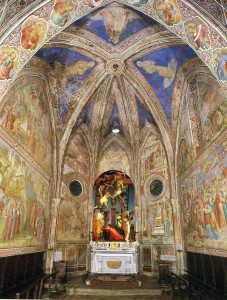 |
|
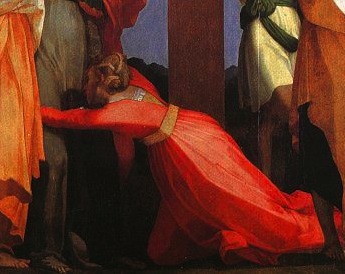 |
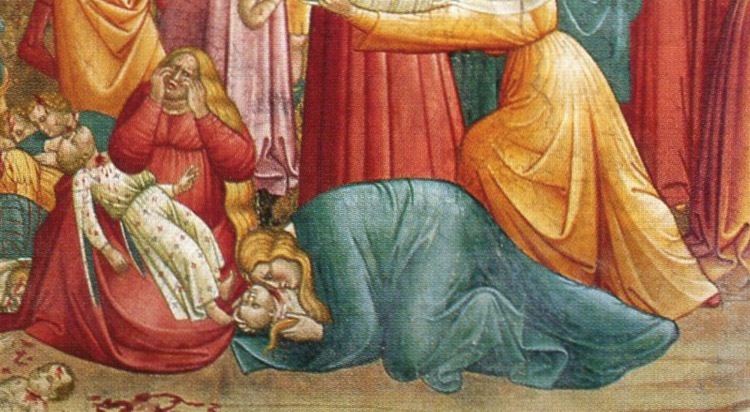 |
But the more immediate and most cogent sources of Rosso’s picture lay within the art of Florence of the first two decades of the Cinquecento. The elegance of Rosso’s Deposition is not far removed from that of Fra Bartolommeo’s God the Father with Sts. Mary Magdalen and Catherine of Siena in Lucca (Fig.Frate,Lucca). Nor is the conception of Rosso’s picture less grand. Furthermore, the gravity of its meaning is very similar to that of Sarto’s Puccini Pietà (Fig.Agostino-Sarto) and his Pietà in Vienna (Fig.Sarto,Vienna). The serious experience that is provided by Rosso’s Deposition has not changed from that of Sarto’s altarpieces. This is not to say that Rosso’s picture is stylistically identical to theirs. But in its differences the style of Rosso’s Deposition is not antithetical to Sarto’s. For Rosso’s Deposition utilizes all that gave strength, grandeur and authority to Sarto’s and Fra Bartolommeo’s pictures. However, Rosso’s intuitions about what is meaningful are not the same and consequently his painting is unlike the art of his most famous predecessors. The condition of feeling within the Volterra Deposition is suspended, ambivalent, and discontinuous. The emotion is also both ecstatic and anxious.
Private as is the experience of the figures in Rosso’s Deposition, and personally searching as worshipper’s experience of this painting may be, it has still some of the declarative characteristics of an altarpiece designed for a congregation, though in this particular case probably not a large one. By comparison Rosso’s Madonna and Child with St. John the Baptist and St. Bartholomew of the same year from the small Pieve di S. Giovanni Battista at Villamagna, very near Volterra, and now in the Pinacoteca in Volterra (Fig.P.10a), is a muted, withdrawn, ascetic image. Like the Deposition the slightly later small altarpiece has a conceptual history extending continually as far back in Rosso’s career as his early Madonna and Child with St. John the Evangelist known from the copy at Tours (Fig.P.2Aa). More immediately it is derived from his sacra conversazione drawing of around 1519 in the Uffizi. But even there the figures are not so elongated as those in the altarpiece from Villamagna where the proportions are so attenuated as to all but remove the Madonna and saints from a relation with normal experience. It is true that such tall and slender figures had existed earlier in sixteenth-century Florentine painting, in Pontormo’s Joseph in Egypt (Fig.Pontormo, Joseph in Egypt). But the small size of the figures in this narrative picture lessens the value of their proportions in the definition of an imagined foreign humanity in Egypt. In the Volterra Deposition the figure of St. John, were he to stand up straight, would be abnormally tall and the figure of the Magdalen unusually drawn out. The stretching of the proportions of these two saints makes effective emotions out of the appearance of the figures’ actions. However, in the Villamagna altarpiece there is hardly any movement at all. Although there is actually more space in this picture than in the S. Maria Nuova Altarpiece, the space is not, in 1521, the medium for the transfer of gestures and glances. Space therefore appears more as a void, suggesting in turn a chamber that does not contain the same air that the spectator breathes. Furthermore, the elongation of the figures, which is not related to any overt action on their part, is itself an index of their special existence. Their high center of gravity and lengthy planarity suggest an almost Byzantine remoteness, but not its self-sufficiency. Carried to such an extreme of abstractness and yet maintaining some physical identity as human beings Rosso’s figures appear on the verge of extinction. For indebted as this painting is to Andrea del Sarto’s Madonna of the Harpies of 1517 (Fig.Sarto, Harpies), the plausibility of that image—though itself a remarkable fiction—just barely survives in Rosso’s picture. But because Rosso’s picture was in a small town far from Florence the actual measure of the humanity that Rosso represents cannot have been expected by him to be dependent upon an actual comparison with Andrea’s painting. The comparison that tells of its humanity is with ourselves, as is also the identification we make with it. It is by this comparison that we come to understand something uncommonly poignant and even tragic in its significance.
There is also in the Villamagna altarpiece, as in the lower part of the Volterra Deposition, a sense of a threat from the unforseeable future, the threat of inconsolable isolation. In the presence of the Child’s painful restlessness, the Madonna’s beautiful austerity maintains only a vague semblance of security. The lean St. John the Baptist makes a fateful point with his open mouth and erect forefinger set against Christ’s body, at its crouch, a gesture matched by the up-raised knife of St. Bartolomew. Holding his book of scriptures open so that its contents could be available to us, this saint looks out at us as though aware of our need to understand. The article of faith that seems to be argued in the S. Maria Nuova Altarpiece is not an issue of contention here. The issue is fully and deeply understood and the gravity of its meaning implies no eventual joy. How different are the implications of Andrea’s significantly larger altarpiece of 1517!
Austere as the Villamagna altarpiece is, its rigidity is relieved by a supple—and human—resiliency, by long, slightly bent curves that subtly modify the angularity of limbs and folds. There is also the relief of opulent abundance in the drapery held at St. John’s side and of the sensitively handled raking light that makes special our seeing of this sacred group. It is not the light of the Volterra Deposition and it does not fall upon or create forms of such precise facets as in that slightly earlier picture. The light is softer but extraordinary nevertheless because it illuminates the forms from such an oblique angle. The drapery that falls behind St. John’s left leg actually appears translucent as it catches the light upon its far side. Here the orange-tan, used also for the shadows of his otherwise very pale yellow-tan mantle, has a warmth that relieves the very cool tonality of this altarpiece. But so muted is the color of this picture that in certain respects it has almost the effect of monochrome as the larger areas of color shift within a restricted range of grays, browns, green and pale yellow. Introduced into this scheme are faint suggestions of other colors, such as the very slight pink of the cheeks of all the figures, the flush of orange in areas of St. John’s very thinly painted mantle, and the pale pink-lavender of the shadows of St. Bartholomew’s white sleeve. The edge of the cover of his book is red, as are a letter and six lines of text on the left hand page. The red of this passage of writing is the same bright orange-red of the Christ Child’s garment, creating a coloristic analogue of the temper of his restless posture and anxious expression and, by implication, of his future Passion as suggested by the book. Perhaps the red of his garment, seen not far from St. Bartolommew’s upraised knife, should also remind us of the Circumcision when Christ first shed his blood.52 This was also the color of the passionate Magdalen in the Volterra Deposition, a color that is hers by tradition, it is true, but one that is made more intense in that picture as the complement to the unusual energetic role Rosso has given her. Against the dark green of the Virgin’s mantle, the dark green of Christ’s sash and the dark gray of the background architecture the red that covers Christ’s body is the dramatic climax of this picture that its otherwise extraordinary formality, elegance, and reserve frame but cannot entirely restrain. The resulting tension is the burden of experience of this sacra conversazione from Villamagna. The red of the blond Child’s garment, the red of the text in St. Bathololmew’s large book, and the reference they make to the blood that He has and will again shed could possibly also remind us of the artist whose red hair and beard might again here identify him with the subject of his picture.
The drama of the color in Rosso’s altarpiece, related though it is to that of the Volterra Deposition, seems ultimately to be dependent upon a recollection of the color of Sarto’s Madonna of the Harpies to which Rosso had already responded in 1518, in the S. Maria Nuova Altarpiece. The red of the mantle of Sarto’s St. John is of an extraordinary richness and its placement in the picture at the far right is remarkable, exciting and daring. It should, one might suppose, unsettle the equilibrium of Sarto’s picture. But the plasticity of the forms in this painting, the leftward placement of the Child, the weighty contrapposto of the figures, the continuum of the rich chiaroscuro, the remarkable inward turn of St. Francis’s body, the subtly varied monochrome of his garment, and the coloristic triad of the Virgin’s clothing absorb that red into the unbroken fabric of the picture. There is no chiaroscuro in Rosso’s painting, only changes of color and value. The figures have almost no weight and their poses involve no contrapposto. The balance of this composition is created by similar shapes and colors placed on either side of a central axis that is made explicit by the very upright pose of the Virgin. The red garment of the Child, set to the left of the Virgin and accompanying, as it does, His anxious expression and physical restlessness, makes precarious the symmetry and neutral tonality of the picture. The color of Sarto’s picture of only four years before is sensuously dense. In Rosso’s painting it is thin and pale or dark and recessive, creating by its relationships an unreal kind of illumination. Though not of the highest tonal value, the red of the Child’s garment is the most intense color in the Villamagna altarpiece. Yet this color is seen by us not merely as a property of his garment or as a factor of the design of this picture, but more seriously as the sign of this Child’s fate. Aesthetically exciting as this color is, it excites also to a recognition of tragedy. The excitement of Sarto’s picture is of a significantly different—and affirmative—kind. Linked as Rosso’s picture is to Sarto’s, the connection between them at this moment in Rosso’s career appears a very tenuous one.
The altarpiece from Villamagna was not mentioned by Vasari and was probably not known to him. In the 1550 and 1568 editions of the Lives the Deposition was little more than listed. He said merely that “… a Volterra [Rosso] dipinse un bellissimo deposto di Croce”, suggesting that Vasari did not know this picture at first hand and had heard of it from Vincenzo Borghini in 1551 or 1558. It cannot be proved that he even knew a drawing of it. The Villamagna altarpiece seems not to have been seen by art historians until the third decade of the twentieth century. The Deposition was known to very few, again until the 1920’s. It had little impact on the artists of the sixteenth century except, in a limited sense, Daniele da Volterra in his own picture of the same subject (Fig.Daniele da Volterra). So while these pictures are generally recognized as Rosso’s “masterpieces” and play a serious role in our present conception of the history of Florentine art around 1520 they were in fact not significantly influential at the time. Their historical role is actually within the subsequent history of Rosso’s own art. It can, however, be wondered if pictures of such passion and intensity could have been painted in Florence following the kind of reception afforded the S. Maria Nuova Altarpiece of questioned decorum, although it was there that Rosso was artistically prepared for the extraordinary achievements of 1521.
There is some reason to believe that the two pictures of 1521 are the result of quite personal considerations, which coincided with or augmented the interests of the Franciscans at S. Francesco and of the members of the Compagnia di S. Croce di giorno and were acceptable to the small congregation at Villamagna. Such a possibility is prompted by the red hair given to Christ in the Deposition (placed in a chapel where a fresco of St. John the Baptist, Rosso’s namesake, occupies an important position), and by the fact that the figure of St. John the Baptist in the Villamagna altarpiece also has red hair and a red beard (in a picture placed in a small rural church dedicated to St. John the Baptist). The finely thought-out religious content articulated with such artistic precision of the two paintings also suggests that they may have been conceived by Rosso with special self-identification. This may have come about because Rosso was himself a cleric. In a Roman letter from the Bishop of Arezzo to Paul III of 20 June 1535, Alias de annon 1528, related to money owed for the unexecuted frescoes at S. Maria delle Lagrime in Arezzo (see the Preface to D.31–D.34), Rosso is referred to as magistro Rubeo magistri Gasparis pictoris clerico florentino, and again in a French ecclesiastical document of 25–26 September 1537 (DOC. 31) related to his becoming a canon of Notre Dame in Paris he is referred to as magister Rouscius Johannes baptista Rosci, clericus florentinensis dyocesis Florentie. The first document would have followed upon his appointment as a canon at Sainte Chapelle in Paris in 1532 (see unlocated DOC. 25), but this appointment would not account for his being called a Florentine rather than a Parisian cleric in the two documents of 1535, referring back to 1528, and 1537. As an acolyte in the minor orders of Sainte Geneviève in Paris he is named in a document of 9 November 1537 (DOC.32): dominum Rossium Johannem baptistam Rossi clericum, canonicum parisien, without mention of Florence. No documents dating from Rosso’s years in Italy refer to him as a cleric, but all of these Italian documents are business records, secular in their wording, even when they deal with church pictures. It is, therefore, very likely that Rosso was a cleric before he went to France, although in what capacity and from which moment are not known. However, he was not a friar, resident in a monastery, as Fra Angelico and Fra Bartolommeo had been. From what we can imagine of Rosso as a cleric in his Italian years it is possible that the religious content and expression of his pictures of 1521, and earlier works as well, are more than may have been usual, of his own uncommon devising.
1 Vasari-Milanesi, V, 158. This sentence follows upon Vasari’s references to the lost coat-of-arms of Leo X and the arch made for his entrance into Florence, both done late in 1515. But Vasari misplaced his mention of the S. Maria Nuova Altarpiece, situating it before these two works. This is the only chronological mistake in Vasari’s account of Rosso’s career in Italy, and may, as suggested in Chapter II, have some meaning in relation to a lost altarpiece of which the Angel Playing a Lute (P.4) in the Uffizi is a fragment.
2 Dated ca.1519 by Cox-Rearick, 1964, I, 161–162, II, Fig. 98, and 1519–1520 by Costamagna, 1994, 142–145, no. 30, with Fig. and extensive bibliography.
4 See Freedberg, 1982, and Lavin, 1983, 162, especially Lavin’s comment on Andrea del Sarto’s contribution to the double subject in the St. John the Baptist theme, “namely the classical allusion, [that] reflects the new historical profundity in high renaissance typology.” The Baptist’s simple garment may be his original camel’s hair tunic (see Lavin, 1955, passim) but the green knot on the shoulder makes it unclear that any particular skin or fabric is intended. However, the leaves of his crown are not merely vine leaves but have specifically the shape of grape leaves with five points although only three are shown in this picture. ADD PICTURE OF GRAPE LEAF/LEAVES
6 For the slightly later Florentine painting by Perino del Vaga of the Holy Family and the Young St. John the Baptist with many of the same details but quite different sentiment, see Wolk-Simon, Linda, “A New Painting by Perino del Vaga for the Metropolitan Museum of Art, New York,” see BM, 153, 2011, 644–649, Fig. 1. Wolk Simon states “More unusually, the young Saint John is crowned with grape leaves and wears a leopard skin, usually associated faith the ancient god Bacchus.” In reproduction the grape leaves are very difficult to see.
13 See especially Pontormo’s drawings for the head of St. Joseph (Cox-Rearick, 1964, I, 130–132, nos. 43–44, II, Figs. 52–53).
16 For an extensive review of these chapels see Cox-Rearick, 1964, I, 162, and n. 5, where it is suggested that Pontormo’s knowledge of the Slaves may have come through drawings rather than the statues themselves which may not have been back to Florence by 1518.
17 On the concetto of apes with the Slaves, see Tolnay, 1943–1960, IV, The Tomb of Julius II, 98–99, with Janson’s suggestion of the Liberal Arts and with the Dying Slave the Ape holding a mirror to signify “ars simian naturae”, and Tolnay’s indication of the tradition of the ape as a symbol of Evil; and Hibbard, 1974, 151–152, with a review of the meanings of the Ape with the so-called Captives and Slaves.
19 In addition to Franciabigio’s painting of 1523 discussed below there are the small fresco by a pupil of Raphael on the eleventh vault of the Vatican loggia (Fig.Vatican,Bathsheba) and Giulio Romano’s painting of 1525–1532 in one of the octagonal coffers of the loggia of an interior garden at the Palazzo del Te, known also from his drawing for it formerly in the collection of Jeffrey E. Horvitz. (Fig.Giulio Romano).
31 I have not been able to find a single drawing before the probable date of Rosso’s St. Paul the Hermit that shows the use of pen and ink and wash as in this work. Here it seems that Rosso came to this handling of these media and techniques because of the special problem of describing the garment of woven palm fronds and the shading of the squares made from them. Looking through the extensive collection of drawings in the fine catalogue by Hugo Chapman and Marzia Faitti, Fra Angelico to Leonardo, Italian Renaissance Drawings, London, 2010, there was no drawing that resembled in its handling of pen and ink and wash Rosso’s drawing of around 1518 or 1519. This technique is especially interesting because the artist continued to explore its use and refine it throughout the following years of career until his death in France in 1540.
35 Waldman and Franklin, 1999, 109, comment that Rosso’s Cristo morto was “surely an important work of art” but this is probably no more true than what can be understood from Vasari’s comment that the painting was “bellissimo”. Even this brief evaluation was probably given to him in Vincenzo Borghini’s report of his visit to Piombino in 1557 or 1558.
41 For an extensive discussion of the subject, see Chapter Four, “The Scribe of the Tau” in John V. Fleming, From Bonaventura to Bellini: An Essay in Franciscan Exegesis, Princeton, 1982, 99–128; see also Rona Goffen, Spirituality in Conflict. Saint Francis and Giotto’s Bardi Chapel, University Park and London, 1988, 24–25, 89–90, n. 36; and André Hayum, The Isenheim Altarpiece. God’s Medicine and the Painter’s Vision, Princeton, 1989, 37–39, 159, ns. 49–51.
44 The lower part of Rosso’s picture brings to mind Domenico Veneziano’s Miracle of St. Zenobius in the Fitzwilliam Museum (Fig.Miracle Zenobius), Cambridge, especially the action of the mother that is similar to that of Rosso’s Magdalen. This figure also recalls Ghiberti’s Magdalen in his Raising of Lazarus of the North Doors of the Baptistery in Florence (Fig.Ghiberti, Lazarus). A similar kind of action in a painting of 1414 derived from one of 1380 is the lunging, but still motionless in effect, mother in green in the foreground of Cenni di Francesco Massacre of the Innocents in the Cappella di Santa Croce di giorno in Volterra (Fig.Massacre,detail).
45 Ciardi, 1987, 1, and Ciardi and Mugnaini, 1991, 25, 149–154, proposed that Rosso was in Rome in 1519–1520, just before he executed the Deposition. I see nothing in the painting that requires such a trip to explain it. The color has precedents in Florentine painting, including Michelangelo’s Doni tondo, and most recently Pontormo’s panels painted for Pontorme. Hall, 1992, 152–153, pointed out that as a model for Michelangelo’s cangiantismo one needed to go no further than the Doni tondo, which, as a challenge to the authority of Leonardo’s sfumato, has irresistible appeal to Pontormo and Rosso. She also found Rosso’s “manner almost belligerently hard-edged, like the Doni tondo,” although she said this when discussing his early Assumption to which the comment does not apply. In discussing the Volterra Deposition she referred to “its brazen cangiantismo and denial of sfumato, or atmosphere of any kind. Sculptural-hard forms, inexplicable illumination, fever-pitch emotion, all are enhanced by the irreal Cennini-style, or blond manner, coloring.” Cangiantismo appears to any great extent only in the garment of the figure on the ladder at the upper left; it also touches the turban of Joseph of Arimathea above the ladder, and is probably to be seen in the yellow to green garment worn by the youth holding the ladder below. The color of Rosso’s picture is extraordinary, but it has to be seen in the context of Rosso’s whole conception of this deeply significant and moving event.
Franklin, 1994, 56, remarks that “Aspects of the style of the Volterra Deposition lend visual support to this [Ciardi and Mugnaini’s] hypothesis” but he does not specify any of those “aspects.” Waldman and Franklin, 1999, 109–110, remark that “It has long been argued that Rosso may have made a visit to Rome, and perhaps also Naples, around the time he went to Piombino.” Again no visual or circumstantial evidence is presented except that Rosso’s known activity and Vasari’s account of these years before Rosso’s stay in Volterra could have allowed for it. For a lengthy account of visits to Rome and Naples, see Natali, Antonio, “Congedo col Rosso,” in Piscina, 1995, 186–192, that also includes his discussion of the lost Portrait of Queen Giovanna of Naples and Sicily, on which see also L.62.
48 The Magdalen’s posture would seem to be new to representations of the Crucifixion and Deposition, as pointed out by Hamburgh, 1988, 583, and Marilena Mosco, in Maddalena, 1986, 121.
50 As quoted by Leo Steinberg in “The Metaphors of Love and Birth in Michelangelo’s Pietàs”, Studies in Erotic Art, ed. by T. Bowie and C.V. Christenson, New York and London, 1970, 252–253, n.30. The suggestion of Hamburgh (1988, 587–592) that Christ’s right hand touches his genitals and hence “indicates the vital doctrine of his Incarnation, his manhood” seems to me a misreading of what actually appears in Rosso’s picture. The lower half of Christ’s right arm is behind his body and not visible in the painting. All of Christ’s body is a deathly green; the pink arm that is seen belongs to the man behind Christ who is helping lower his body from the cross.

